Travel Hacking 101: Beginner’s Guide to Free Flights & Hotels
R.J. Weiss, CFP®
- Updated December 20, 2023
Travel hacking has saved me tens of thousands of dollars. Just as important, it’s given my family incredible travel experiences that we wouldn’t have otherwise been able to afford.
With this guide, you’ll have all the knowledge and tools you need to start travel hacking like a pro and create unforgettable travel memories yourself.
Here’s what we’ll cover :
- What is travel hacking?
- Travel hacking and credit Impact
- How to earn points and miles
- The best first credit cards for travel hackers
- Tips for getting free flights with credit card points
- How to maximize your hotel points to get the most free nights
- My favorite award redemptions of all time
And lastly, we’ll answer some of the most common questions asked by new travel hackers.

What Is Travel Hacking?
Travel hacking is the art and science of unlocking free or significantly discounted travel experiences by strategically earning and redeeming reward points and airline miles.
This concept encompasses various techniques, including leveraging credit card rewards, airline loyalty programs and hotel rewards to make your travel dreams a reality.
Since some credit cards offer as much as 2% cash-back, you might wonder whether it makes sense to just use those rewards for travel. The real benefit of using points and miles comes from point redemption values that can often reach 3 cents per point or more, and sometimes even go up to 10 cents per point.
Credit cards that offer generous welcome bonuses and reward points for everyday spending are the foundation of travel hacking. By using credit cards strategically, you can accumulate valuable points that can be redeemed for flights, accommodations and other travel-related expenses.
It’s not uncommon for a single credit card signup bonus to cover the cost of an international flight, making this a game-changer for many travelers.
In addition, you can also earn points or perks by taking advantage of airline loyalty programs or hotel rewards programs. By staying loyal to a specific airline or hotel brand, you can earn rewards points or perks such as free upgrades, lounge access and more.
In essence, travel hacking is about understanding the ins and outs of the rewards ecosystem and using that knowledge to make the most of every travel opportunity.
How Travel Hacking Impacts Your Credit and Finances
If you’re considering travel hacking, it’s crucial to understand how it can impact your credit score and overall financial health.
Your credit score is a three-digit number that indicates your creditworthiness and helps lenders evaluate your risk as a borrower.
Several factors determine your credit score, including:
- Payment history (35%)
- Credit utilization (30%)
- Length of credit history (15%)
- New credit (10%)
- Types of credit in use (10%)
Signing up for credit cards is closely tied to many factors that carry the most weight in your credit score. Therefore, it’s not whether travel hacking will affect your credit score but how it will affect it.
To ensure a boost to your credit score while enjoying travel rewards, remember to:
- Choose credit cards you plan to keep long-term.
- Aim to hit the minimum spend requirement without overspending.
- Keep your credit utilization less than 30%.
- Space out new credit card applications.
- Pay your balance in full using auto-pay to avoid missing payments.
Much of this is familiar to anyone who has managed their credit responsibly. But if you’re new to managing your credit, check out our article titled “ How Travel Hacking Impacts Your Credit and Finances ” for a more in-depth guide.
How to Earn Points and Miles
Points and miles are the currencies of the travel hacking world. When you know how to earn them efficiently, you’ll be well on your way to ticking off dream destinations from your travel bucket list.
Fortunately, with the right travel hacking strategies, you can earn points and miles toward your dream vacation without spending a fortune.
The top strategies for earning points include :
- Credit card sign-up bonuses . By strategically choosing a card with a great bonus, you could find yourself enjoying a premium flight experience or a free hotel stay.
- Optimizing your spending through bonus categories . Many credit cards offer bonus rewards for specific purchases, such as travel or dining. Using the right card for each purchase can help you accumulate points faster.
- Shopping portals . You can earn rewards at popular online stores. Many credit card issuers, airlines and hotels have their own shopping portals.
- Maximize points earned while booking travel . Frequent travelers can optimize their rewards by taking advantage of loyalty programs offered by airlines and hotels.
- Refer friends and family to credit cards . Referring friends and family, including a spouse, to credit cards can be a rewarding way to earn additional points or miles.
- Open a business credit card . Business credit cards often have some of the most lucrative signup bonuses, making them an essential part of beginner travel hacking.
- Earning points with bonus transfers . Bonus transfers can be a powerful tool for quickly reaching your rewards goals. Many credit card issuers and loyalty programs offer periodic promotions, where you can transfer your points or miles to partner programs with a bonus.
- Promotions and offers . Promotions and offers can encompass both limited-time and ongoing incentives, which involve activities such as adding authorized users, making purchases at specific merchants, linking your loyalty accounts with certain merchants, or completing one-time tasks, such as meeting a spending threshold within a specified timeframe. These offers vary by credit card issuer and card type.
By implementing these strategies, you’ll effectively accumulate rewards and transform them into unforgettable travel experiences.
To learn more about these strategies, read our detailed guide on earning travel rewards: Earning Points & Miles: The Best Ways to Earn Travel Rewards .
The Best First Credit Cards for Travel Hackers
As a beginner, choosing a card that offers long-term benefits, has a quality signup bonus, and has reasonable minimum spending requirements is essential.
Our top choices for first-time travel hackers include the Chase Sapphire Preferred Card and the Capital One Venture Rewards Credit Card, among other outstanding credit card offers we’ve curated for your convenience.
The Chase Sapphire Preferred Card offers a reasonable annual fee of $95, making it a great value. It also provides a consistently great signup bonus worth hundreds of dollars in travel rewards.
With this card, you can redeem your points at a rate of 1.25 within the Chase travel portal, or transfer your points to various airline and hotel partners (including popular brands such as United Airlines, Southwest Airlines and Hyatt Hotels).
The Capital One Venture Rewards Credit Card is another excellent option for beginners.
With this card, you can earn unlimited 2X miles per dollar spent on every purchase, making it easy to accumulate rewards quickly. It also offers a consistently high signup bonus, which can be worth hundreds of dollars in travel credits.
One unique feature of the Capital One Venture Rewards Credit Card is that it allows you to use points to erase purchases categorized as travel on your credit card without using a travel portal.
You can then benefit from a larger sign-up bonus and other travel perks the card offers, like lounge access, TSA credits and the option to transfer points to travel partners for potentially higher value. This combination of features makes the Venture card more appealing for travel enthusiasts compared to a 2% cash-back card.
Overall, both cards offer flexibility in using your rewards, making them worthwhile even if you don’t have a specific travel destination in mind.
We’ve partnered with CardRatings to give our readers access to top credit card products. By collaborating with CardRatings, we ensure all data is accurate regarding the credit card products available, as it changes frequently. To discover these and other top travel card offers, see their “ Best Travel Cards ” page.
Airline Miles for Beginners
If you’ve never done it, booking flights with points can feel intimidating. With so many airline programs and transfer partners, knowing where to start and how to get the most value for your points can be challenging.
So let’s start with the basics. There are two main ways to use your points to book flights:
- Through an airline’s mileage program . Using an airline’s mileage program means you redeem points or miles earned through that airline’s loyalty program. Each airline has its own award chart and pricing, which determines how many miles you need to save for a free flight based on the destination and class of service.
- Using fixed-value points . These points hold a set value, typically measured in cents per point. You can use these points to book flights or other travel expenses at a fixed redemption rate. For example, if you have 50,000 Chase Ultimate Rewards points and the Chase Sapphire Reserve , you can use them to book a flight at a rate of 1.5 cents per point, which would be worth $750 towards the cost of the flight.
When trying to maximize the value of your travel rewards, booking flights with miles can offer outsized rewards compared to fixed-value points. However, there are certain situations where fixed-value rewards can come in handy.
At the same time, booking flights with reward points is more challenging than booking flights with fixed-value rewards, as award space availability can be limited.
When you’re ready to book your flight, check out our step-by-step guide to redeeming points for airfare . Plus, see our rankings of the best free tools for award flight searches to help save time.
Exploring Your Accommodation Options: Hotels, Vacation Rentals and More
Booking accommodations like hotels, vacation rentals, and other types of lodging with reward points can be a great way to save money or even splurge on a luxurious stay.
Similar to flying, when it comes to redeeming points for lodging, there are two primary methods:
- Hotel loyalty programs.
- Fixed-value rewards.
Earning points by transferring them from credit card companies is one of the fastest ways for you to book hotel stays. For example, you can earn a signup bonus with a credit card issuer like Chase, then transfer the points to a hotel loyalty program like Hyatt.
This allows you to earn points fast and potentially stay at a higher-end property than you would be able to afford if paying with cash.
Additionally, some hotels offer co-branded credit cards that allow you to earn points directly with the hotel, and often offer free nights or room upgrades.
Using fixed-value rewards to book hotels offers flexibility to those who prefer to avoid committing to a specific hotel chain. The Chase travel portal, for example, allows you to book hotels at a rate of 1.25 cents per point with a Chase Sapphire Preferred card or 1.5 cents per point with the Chase Sapphire Reserve .
Capital One offers many redemption options, including booking hotels through deal sites like Priceline or vacation rental sites like Airbnb.
After making bookings, which can be done outside of Capital One’s travel portal, you can use your points to effectively “erase” those purchases from your account statement. The key is that they must be categorized as travel.
Remember that leveraging the power of points and rewards to create meaningful travel experiences is the core idea of travel hacking. Whether you’re looking to save money or splurge on a luxurious stay, booking accommodations with points is an excellent way.
Check out our Booking Hotels with Points Made Easy guide for more tips and tricks.
Discover My Favorite Reward Redemptions
Curious about the real-world potential of travel hacking? Don’t miss my article on my favorite reward redemptions .
This piece dives deep into some of the most incredible travel experiences I’ve had, all thanks to strategically using points and miles. From first-class flights to five-star resorts and unforgettable family vacations, these examples will give you a glimpse of what’s achievable.
Let this article inspire you, whether you’re just starting out or looking to take your travel hacking to the next level.
Traveling Hacking FAQ
Yes, travel hacking is legal. It involves strategically using credit card rewards, airline loyalty programs, and hotel rewards to get the most value for your points and miles. However, it’s essential to follow the terms and conditions of each rewards program and credit card issuer to avoid potential issues; while violating these rules is not illegal, it could get you kicked out of the program and may result in the forfeiture of any accumulated points or progress.
When done responsibly, travel hacking should not ruin your credit. In fact, it can even improve your credit score. Ensure you pay your credit card balance in full every month, keep your credit utilization low, and avoid applying for too many cards in a short period.
The time it takes to earn enough points for a free flight or hotel stay depends on various factors, such as your spending habits, the credit card you choose, and most importantly, how you plan to use the rewards. With the right strategy and card, you could potentially earn enough points for a free flight or hotel stay within a few months.
The Chase Sapphire Preferred card is most often recommended for beginners. The card offers flexible rewards, reasonable annual fees and a valuable signup bonus. But make sure to check out the best current offers for other cards that might match your travel goals, in addition to making sure you’re a good fit to hit the minimum spend and having a good enough credit score.
Unlock Your Next Adventure
Travel hacking is all about leveraging the power of points and rewards to save money and create meaningful travel experiences.
To dive deeper into specific topics, be sure to check out our related posts:
- Travel Hacking & Credit Impact
- Earning Points & Miles
- Choosing a Travel Rewards Credit Card
- Airline Miles 101
- Maximizing Hotel Loyalty Points and Programs
With these resources, you’ll have everything you need to take your travel hacking to the next level.
Happy travels!
Travel More, Spend Less
From international business class flights to nearly free family vacations: unlock it all with points through our free 7-day travel hacking course.
We won’t send you spam. Unsubscribe at any time.
That’s a great post!
Well, I stumbled upon this well-detailed blog and now after going through it I have a better understanding of travel hacking. Thanks to the author for researching and curating a well-written top-notch piece of information.
Leave a reply Cancel reply
Your email address will not be published. Required fields are marked *
Comment Read our comment policy.
A Message From Our Founder
Welcome to The Ways To Wealth. I founded this site to help make a difference in people's lives by delivering objective, reliable advice and recommendations that help them make more money, save more money, and invest wisely.
- Money Management
- Debt Payoff
- About The Ways To Wealth
- Media & Advertising
- Privacy Policy
Latest Posts
Why i love the bilt rewards card, even though i don’t pay rent, robinhood gold card: game-changer or gimmick (8 insights), swagbucks review 2024: still legit our insights after 5 years, usertesting.com review: we applied to 46 tests and got approved for none, m1 review (2024): a fantastic all-in-one investing choice, popular tags.
- Reading Lists
- How to Use Points for Free Flights
- The Best Carry-On Luggage
- The Ultimate Guide to Traveling Like a Pro
- My Favorite Travel Credit Cards
- lake louise
- new orleans
- new york city
- palm springs
- packing lists
- product reviews
- How to Use Vitamin C Serum
- Easy Step-by-Step Skincare Routine
- Drunk Elephant: Best & Worst Products
- Fitness & Wellness
- How I Edit My Photos for Instagram
- Furniture My Interior Designer Loves
- Best Strapless Bras
- blogging & business
- Amazon Finds
- Hotel Lobby Candle
- Shop My Faves
- Promo Codes and Discounts
- Shop My Instagram

70 Travel Hacks That Will Change Your Travel Game Forever
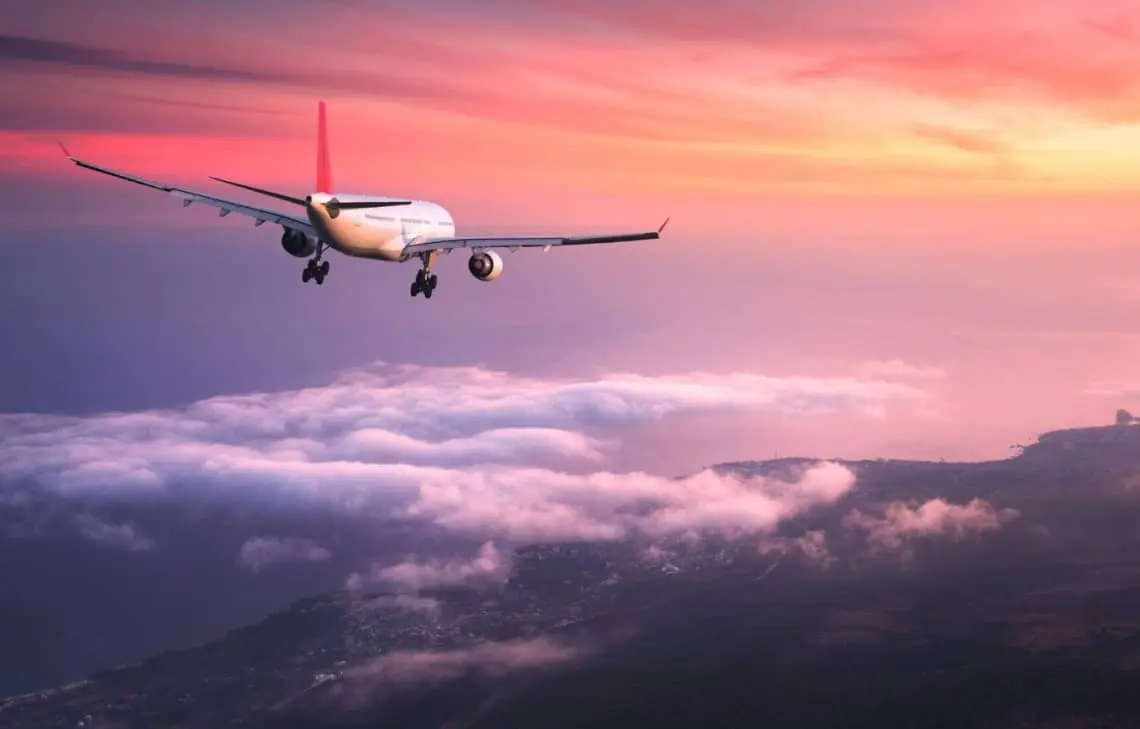
With 57 countries under my belt and more than a decade of traveling regularly, I think it’s safe to say that I’m an expert in the field. I’ve made every mistake you could imagine—missed flights, lost baggage, exploding hair irons—but with each disastrous experience, I’ve grown a little bit wiser, and a LOT savvier when it comes to traveling like a seasoned pro.
These travel hacks for flying, packing, saving money, getting hotel upgrades and more are the secrets I swear by. I hope they’ll help make your next trip pleasurable, memorable, and stress-free.
70 Travel Hacks That Will Blow Your Mind
1. use my “contact lens case” hack for makeup and skincare products ..
This is one of my best space saving packing hacks. People tend to take up unnecessary room in their toiletry bags by bringing full-sized products.
Here’s the trick: put your foundation, moisturizer, eye cream , and any other liquid products into contact lens cases. Every inch counts!
2. Be strategic in your seat selection when booking a flight.
There’s nothing worse than getting stuck in a seat that doesn’t recline, or ending up in a row next to the lavatory with people hovering over you for the entire flight. I avoid these kind of mishaps by checking SeatGuru before I choose my seat on flights.
Occasionally, I’ll even choose a flight based on the type of plane that SeatGuru tells me I’ll be flying on. The website and app shows you photos of the plane’s interior so you’ll know in advance whether you’re booking an outdated 747, or a brand spanking new plane.
Plus, it gives you warnings about seats that have potential issues, like limited recline or a misaligned window.
3. Pack your own DIY amenity kit for long-haul flights.
I loooove the amenity kits that you get when you fly First or Business, but since I don’t always have that luxury, I decided to start making my own. My “DIY kit” stays in my carry-on bag at all times, and includes a toothbrush and toothpaste, deodorant, sheet masks, moisturizer, hand cream, eye masks , lip balm, and socks.
4. Avoid cankles by wearing compression socks.
They’re basically Spanx for your calves and feet, because feeling swollen after a long-haul flight is the WORST.

5. Consider choosing an “alternate destination” when you search.
If the city you’re flying in or out of isn’t a main hub, consider flying into a bigger city and connecting or finding a flight (or other mode of transportation) out of that city.
Not only will you save money, but you have the potential to earn more mileage points.
6. Download the Google Translate app to help with language barriers.
You can use it to take photos of text in another language, and it will translate the words in real time. (I have a separate blog post featuring the best travel apps for savvy jetsetters , which you should check out as well!)
7. Use packing cubes.
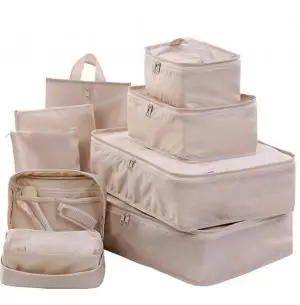
Another space saving packing hack that I swear by? Packing cubes! I truthfully thought these were a scam until I tried them out for myself.
They not only compress your items to give you additional space, but they also help keep you organized—I use a small one for socks and underwear, a medium-sized one for tops, another medium-sized one for comfortable walking shoes and sneakers , and a large one for jeans , pants, and dresses.
8. Look out for price errors.
Often times, there will be glitches on airline or third party sites that offer a ridiculous low fare. Sign up to these sites to keep an eye on them. But know that you will have to act quick, as these companies will typically fix the fare as soon as they catch it. Here are some great resources to keep an eye on for low fare deals.
- Scott’s Cheap Flights (or Jack’s Flight Club for UK-based people)
- The Flight Deal
- Secret Flying (if you’re based out of Europe)
- Holiday Pirates
- Airfarewatchdog.com
- FlyerTalk Mileage Run (discussion board)
* Bonus Tip: Fill your social media with these sleuths by following them on Instagram and Twitter!
9. Take advantage of generous credit card offers.

The greatest travel hack of all time? Credit cards and points. Open up a credit card that has a sign-up bonus (assuming you can be responsible enough to pay your bills!), and transfer the points to an airline for a pricey international flight.
Check out my full step-by-step guide to using points and miles for free travel if you haven’t already!
10. Be strategic with flight cancellations.
If you book a nonrefundable ticket and your plans change or you know you won’t be traveling on that flight—do not cancel the ticket until the last possible moment.
Or…just don’t show up. Here’s why: in the rare case that there’s a flight cancellation or schedule change, your nonrefundable ticket could entitle you to a credit or refund. Had you cancelled the ticket, you wouldn’t be entitled to anything.
11. Learn how to avoid long airport security lines.
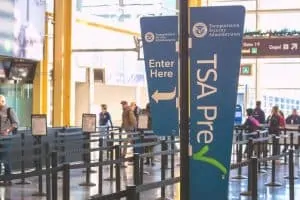
TSA-precheck, Global Traveler, and Clear have been an absolute gamechanger for me, and if you travel more than a few times a year, they are absolutely something worth investing in. If you’re not familiar:
- TSA Precheck enables you to use a separate line for domestic (US) flights, and you won’t be required to take off your shoes or take out your laptop.
- Global Traveler is for international flights and (as far as I know) is for the US only. When you’re returning to the US, you use a machine that scans your passport rather than having to wait in line at customs.
- Clear lets you scan your fingertips at security and then get escorted to the front of line at airports where it is offered.
12. Take a hydration multiplier for long flights.

While everyone will tell you to “drink as much water as possible” and “try to stay hydrated” on a long-haul flights, the reality is that if you’re drinking a liter of water on a plane, you’re going to find yourself getting up to go to the bathroom repeatedly.
My hack for this is to use Liquid IV. It’s a “hydration multiplier” that hydrates you 2-3 times faster than water alone. You pour the little packet of powder into your water bottle, shake it up, and then drink.
It tastes pretty similar to Gatorade (the lemon/lime is my preferred flavor) and will keep you hydrated without sending you to use the restroom every 30 seconds.
13. Keep track of itinerary ideas in Google Docs.
I use Google Docs for all of my itineraries—especially when I’m planning a girls trip and there are multiple people involved. I’ll share the link with everyone I’m traveling with to make it more collaborative. It’s also where I keep a running list of recommendations from people for the destination that I’m visiting.
14. Challenge yourself not to check a bag.
Avoid lost baggage nightmares by packing carry-on only for trips under a week. In need of luggage that actually fits a lot of stuff? Here’s a list of the best carry-on bags that help save space with packing.
15. Order a “special meal” in advance of a long-haul flight.

Most major airlines will offer the option to order a special meal when you book your flight—these include vegetarian, gluten-free, dairy-free, kosher, vegan, low fat, and sometimes even low sodium options.
People who place orders for “special meals” will always get served first, so if you’re hoping to catch some z’s on the flight, you’ll have more time to sleep while everyone else is waiting for their food to arrive.
16. Save local currency from the country you’re visiting as a souvenir.
My husband and I started doing this many years ago, and now we have what we jokingly call a “world bank” at home. It’s a cool alternative to buying a dumb keychain or t-shirt you’ll never wear.
17. Create a framed collage of foreign currency from your trips after you get home.

I often find foreign currency to be incredibly beautiful. We’ve taken some of the best-looking bills from various places we’ve visited, and framed them.
18. Do the same with hotel room keys, airline tickets, and baggage tags.
You can use a place like Framebridge to arrange and frame them for you—they’ll even send you a pre-paid envelope to mail in your items.
19. Talk to taxi drivers.
Often, a simple taxi ride from the airport to your hotel will turn into an impromptu city tour if you ask the right questions.
20. Build your itinerary using Go ogle Maps Trip Planner.

This might be the greatest travel hack of all time. Did you know that there’s a FREE tool within Google Maps that you can use to create an entire itinerary for your next trip? It’s called Google Maps Trip Planner and it’s incredible.
21. Don’t exchange money at the airport.
Wait and go to an ATM near your hotel for better exchange rates.
22. Take advantage of layovers as often as possible.
Sometimes, I’ll even choose flights with 12+ hour layovers as a way to see another city for a day.
23. Never miss another photo opp.
Take photos in “burst” mode so you don’t need to worry about missing the shot.

24. Carry a photocopy of your passport in your wallet.
Just in case.
25. Speaking of wallets… invest in a good travel wallet.
Trying to keep track of boarding passes, passport photocopies, foreign currency, and receipts can get a bit messy if you’re trying to stuff everything into your regular, everyday wallet.
The best way to stay organized while you’re heading out of town is to use an inexpensive but chic travel wallet that has additional compartments for travel-related items.

26. Use a travel agent or tour operator for special trips or multi-city itineraries.
They can often get you better rates and preferential treatment at hotels.
27. Become a points and miles pro.
I’ve said it before and I’ll say it again—I’ve learned everything I know about points, miles, and travel hacks from my friend Brian Kelly, aka The Points Guy . Browse through his site for all the secrets.
28. Easily share photos with friends/family.
Start a shared album with your the people you’re traveling with at the beginning of a trip, so you’re able to easily exchange photos.
29. Get the experience of a luxury hotel without staying at one.
Dying to stay at a fancy hotel but can’t afford the nightly rate? Pop in to the lobby bar for drinks instead.
30. Plan your trip during “shoulder season” to take advantage of better hotel rates and less crowds.
Shoulder season = the period between high and low season, when the weather is still great but the destination is less busy. In places like Positano , Santorini , and Mykonos for example, shoulder season is generally April through the middle of June, and September through October.

31. Avoid jetlag by getting onto the local time zone as soon as you board the plane.
If it’s technically morning in the destination you’re going to when you board the plane, do NOT go to sleep—even if it’s midnight where you’re leaving from. If you work on adjusting to the time zone while on the flight, you’ll have a better chance of battling jet lag when you arrive.
32. Hire a local guide during the first day of your trip in a foreign city.
It’ll help you get the lay of the land. Then ask your guide for non-touristy recommendations to hit up during the rest of your trip. Also: if you’re traveling with a big group, DEFINITELY hire a guide. It takes the pressure off of one person being put in charge of the itinerary.
One of the best things I’ve ever done was hire a guide for my five-day trip to Tokyo since I wanted to see as many things as I could in a short period of time.
33. Use a sheet mask on long flights to replenish the moisture back into your skin.
I love using these sheet masks on the plane. Instead of looking haggard when you land, your skin looks super glowy and fresh.

34. Hire a passport/visa expediting service if you’re in a pinch.
I used a company called “It’s Easy” to renew my passport when I was super tight on time, and they were able to get it to me within a few days.
35. Keep a “packing checklist” in your phone.
You can refer back to it every time you’re heading out of town. I have an example of my travel packing checklist here .
36. Always keep your boarding pass.
I usually keep mine until I see that my miles have posted on my frequent flyer account—if you end up having to claim missing miles from your airline, you’ll need to have your ticket number and confirmation number as a reference. Which leads me to my next point…
37. Create a frequent flyer account on every airline you travel with.
There’s no reason not to. If you don’t you’ll be missing out on valuable miles that could potentially be put toward your next trip. I personally have FF account with: American, Delta, JetBlue, United, Cathay Pacific/Asia Miles, British Airways/Avios.
38. Keep your iPhone photos organized.
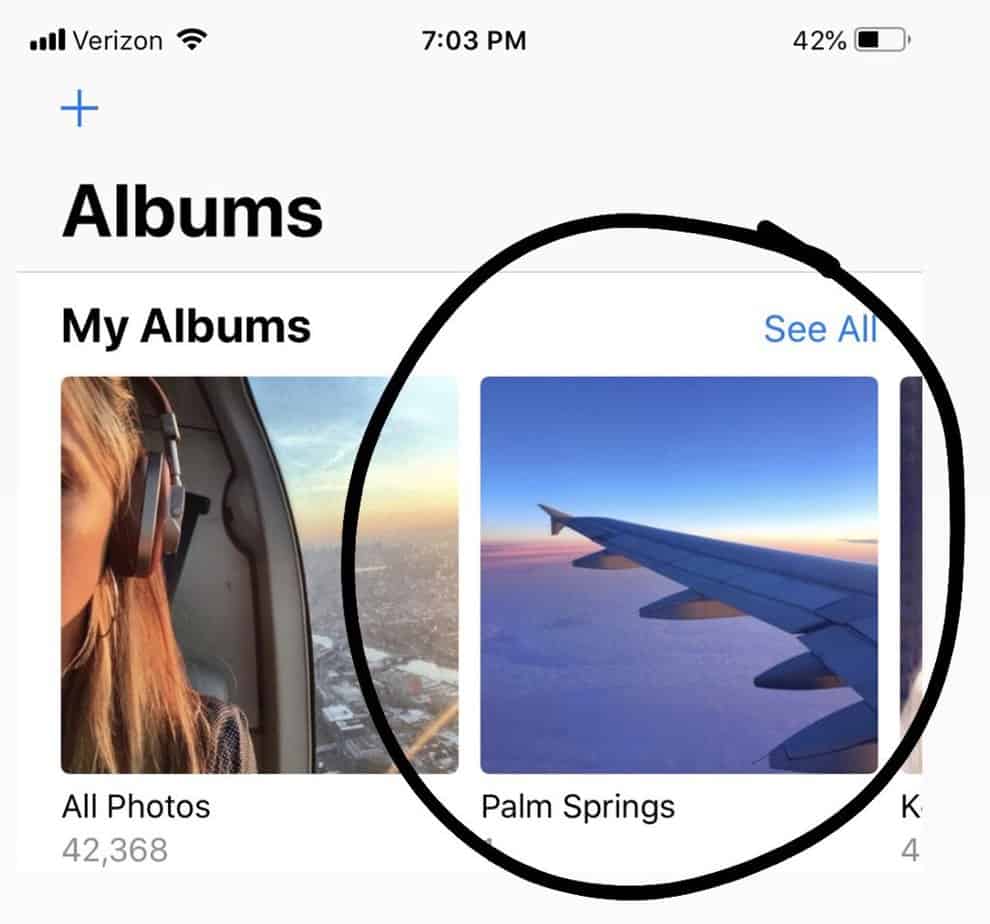
Save all of your favorite trip photos into an album in iPhoto so that you can find them quickly.
39. Turn your travel photos into cool animations using free apps.
One of my favorite ways to jazz up my photos following a trip is by using apps like KiraKira and Enlight Pixeloop. (For example, I have a little tutorial that shows you how to add falling snow to your photos in 30 seconds.)

40. Use a pants hanger to ensure blinds stay closed over night.
There’s nothing worse than waking up at the crack of dawn on vacation because of a small gap in the hotel drapes. I avoid this by using a hanger with trouser clips to secure the two window shades together.
41. To find cheap flights, consider looking beyond the obvious sites like Kayak and Expedia.
If you set the tab or filter to “everywhere” or “anywhere” and are flexible with your dates and travel time, you can find really inexpensive flights and even earn extra miles if you fly an extra leg.
A few of the best “deals” sites are:
- Sky Scanner
42. Always ask for an upgrade.

Unless you’re on an unlimited budget or celebrating a special occasion, never book the best room at a hotel—but always ask for an upgrade. I did this on a recent trip to Maui , as well as in the Maldives and St Barths , and totally lucked out!
Make sure to join the hotel’s loyalty program before arriving (they’re free), since they usually honor those requests for members as long as a higher room category is available.
43. Sometimes, the budget airlines have even cheaper flights on their sites.
Also, if you sign up for their newsletter and loyalty clubs, you get added perks and insider info. A few that comes to mind are Norwegian, Frontier, Southwest, and Spirit.
44. Be a “country counter.”
Download the “Been” app to keep track of the countries and states you’ve visited.
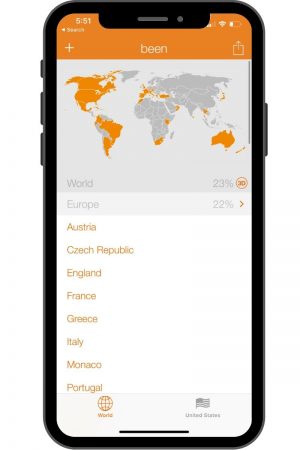
45. Get a more authentic “local” experience with your accommodation.
Using sites like Air BnB, VRBO, Booking and others gives you the opportunity to live more locally and at a significantly discounted rate. In fact, sometimes the house share experience is more personalized and luxurious.
46. Book a private room at a hostel to save money.
If hostels are an option (check HostelWorld.com), you can book private rooms for a really cheap rate. This is a great way to 1) save money 2) meet new people (perhaps people you could room with in another country on future trips.)
47. Always have a back-up power source.
Charge an external battery before you travel, and have it with you on the plane in case the seats don’t have outlets.
48. Compare flight prices using Airfare Matrix.
AirFare Matrix is something travel agents use. It is a Google tool and allows you to do some great price comparison without the third party interjection (that can sometimes cause you to pay more if you’re not searching in an incognito browser).
You can’t book directly from the site, but can use the codes as a source to get the cheapest price when you call an agent, or even the airline.
49. Try toggling to a different “home” country when searching for flights to get cheaper rates.
If you’re looking to fly a specific airline, set your country (usually in the top right hand corner or in the website’s footer) to one that has a good FX rate (of the countries available, of course).
This will allow you to view and purchase the flights in another currency, and potentially save big! It will take some time and some trial and error, but if you have the time, it’s worth it!
50. Mark your bag fragile.
It’ll be handled properly and make it to the top of the pile, ensuring your luggage comes out in the first batch!
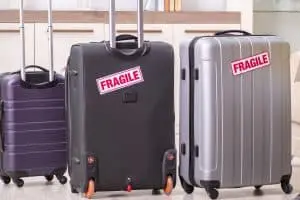
51. Before you pay for an upgraded cabin, see if the flight is full.
If not, put yourself on the upgrade list as soon as you can. Also, offering to get bumped from a flight and wait for the next flight could give you leverage to negotiate a better seat (and maybe even money or points).
52. Use FourSquare for Wifi.
You can find wifi passwords on FourSquare for restaurants, cafes and other places (just be careful, obviously, as not all of these are secure.)
53. Turn on “Private Browser” when searching for flights.
Prices do, in fact, fluctuate based on the cookies in your web browser and how many searches you’ve performed for a specific destination. Which is why searching for flights in a private browser (also known as “incognito mode”) is an absolute must.
If you’re using Google Chrome, you can enable Incognito mode by hitting Command + SHIFT + N.
If you’re using Firefox or IE, you can enable a private browser by hitting COMMAND + SHIFT + P.
54. Bring an oversize scarf on the plane that doubles as a blanket.
Then wear it as a chic cape during your trip.

55. Save on parking by pairing up with a local.
Garage Pointer is a website that connects you with people who own parking spaces and are willing to rent them (temporarily) to visitors. As of now Garage Pointer is only available in the U.S.
56. Rent a car…from a local.
Ready for the best car travel hack? Look into whether or not Turo is available in your destination. The app and website connects you with people who own cars and are willing to rent them out for a fee that is (usually) much less than traditional car rental.
57. Overwhelmed with what to pack? There’s an app for that.
PackPoint helps you determine what to pack based on where you are going and the length of your trip. It checks the weather in your upcoming destination and then provides a detailed packing list for you. (I would also recommend using my “what to wear” guide if you’re packing for trip to Europe in the winter .)
58. Use a service to ship your clothes ahead of your trip.
Sure, this might not be for everyone, but did you know there was a service that stores, packs, ships and cleans your clothes prior to trips? It’s a company called DUFL . While it’s definitely targeted to a very specific market, DUFL is an incredible concept.
You send them a capsule wardrobe (consisting of clothes you need for every trip, like business travel), and they’ll store the clothes in a “virtual closet,” which you can access through the app prior to your departure. They then send the clothes to your hotel ahead of your arrival, and collect them to dry clean and store when you leave.
59. Use FlightAware to track your flights.

The website and app allows you to track your flight (or the flights of loved ones) in real time. It’ll also keep you up to date on important info, like whether the incoming flight is delayed, or if the flight had to be rerouted for any reason.
60. Invest in a good adapter/plug converter.
I like this one because it works in all countries, and also has USB ports.
61. Book tours and experiences through AirBnB.
Did you know that Airbnb can be a great resource for things other than accommodations? Over the past few years, the company has expanded to include incredible local experiences and tours.
62. Wear a travel outfit that looks super chic—but it secretly comfortable.

I have an entire blog post dedicated to this (linked above!) but in a nutshell, I’m a big fan of looking put together when I travel. However, I also wouldn’t be caught dead wearing jeans on a long flight.
There are a few little tricks I use to turn otherwise sloppy outfits into something that you’d be confident walking into a luxury hotel wearing.
The most important thing? A lightweight fringed scarf (which doubles as a blanket mid-flight) and a leather or denim jacket.
63. Invest in a great pair of noise-cancelling headphones.

We’ve all been stuck next to a screaming child or chronic sniffler on long flights, and the experience can truly get your trip started off on the wrong foot.
I truly can not tell you how much of a game-changer noise-cancelling headphones are. While everyone else around you is having a meltdown over not being able to sleep or concentrate, you’ll be in your own little zen world.
Pro tip : if you don’t want to spring for the fanciest new technology, buy older or discontinued models of Bose headphones on Amazon for a fraction of the price for latest models.
64. Leverage special occasions for perks.
Celebrating a big anniversary or planning a trip for your honeymoon ? Be sure to let the hotel know in advance. When my husband and I went to Thailand and the Maldives for our honeymoon, we mentioned it to each property that we booked, and ended up with upgrades, bottles of champagne sent to the room, and other extra special perks from hotel staff.
65. Use your h otel’s shower cap to protect your toiletries from exploding.
Nervous about your liquids exploding in your toiletry bag on the flight home? Wrap them in the shower cap provided to you in the room. And if you don’t have a shower cap: use the plastic liner that comes with your ice bucket.
66. Download the Revolut app.
The popular European banking app recently launched in the U.S., and it allows users to exchange currencies from 55,000+ surcharge-free ATMs nationwide.
67. Seek itinerary inspiration through social media.
Use Instagram to inspire your itinerary. Browse through hashtags and geotags to see where people took gorgeous photos—and then go to those places! Alternatively, you can google things like “ The Best Instagram Spots in NYC ” or “ The Most Instagrammable Places in London ” for fun ideas.

68. Use AirHelp to get compensated for flight delays or cancelled flights.
We’ve all been there: you miss a connection because of a delayed flight, or your flight get inexplicably cancelled, and you know that the airline has to owe you some kind of compensation.
The problem is that actually getting what you’re owed can be a logistical nightmare that involves long wait times, endless phone calls, and unanswered emails. AirHelp essentially plays the middleman by acting on your behalf.
They do charge a fee (which is a percentage of what you’re ultimately compensated) but as someone who has used the service successfully, I can say that it is VERY much worth saving you the headache.
Plus, Airhelp knows exactly what you’re entitled to based on their expertise, so you’ll often end up getting more than you would have received on your own.
69. Do your souvenir research ahead of a trip.

One thing I always do before I travel is a bit of research about the most unique gifts and souvenirs to buy in the destination I’m heading to. Looking this up ahead of time might top you off to some really cool new boutiques, and it will also guarantee that you don’t end up at an airport gift shop wasting your money on a meaningless memento.
For example, this list of the best things to buy in Paris contains a ton of “hidden gems” within the city you might never have known about otherwise. There’s also something extremely satisfying about going on the hunt for a specific unique item—and then finding it!
70. Keep a note in your phone filled with travel quotes .
For those times that you desperately want to post an Instagram photo, but you’re at a loss for a caption.
Did you find this list helpful? Are there any travel hacks you love that I didn’t include? Drop them in the comments below!
Thank you to nicole cueto aka @thecubancarrie for her contributions to this piece.
Pin this post for later:

You Also Might Like
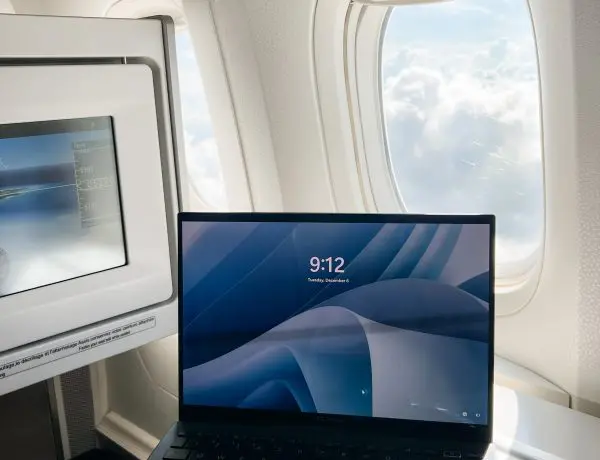
The Craziest Thing I’ve Ever Done: Here’s the Story Behind My Last-Minute Trip Halfway Around the World

Planning Your Honeymoon? Read This First.

THE MAGIC OF MUSTIQUE
If you’re traveling with an infant/toddler; bookmark, screenshot AND print the rules for taking things like breastmilk/formula/snacks through security as well as the policy about early boarding for families. It helps to be prepared for any hiccups. And even if you just fly once or twice a year with a child, get TSA Precheck. Your child under 12 can go through the line with you, which makes things SO much faster.
Lindsay Silberman
this is SUCH a good tip (and one i would never have thought of!) thanks for sharing!
I always get a seat on the plane forward of the wings. Any turbulence the plane encounters dieting the flight is less bumpy in the front half.
Charles Loes
these hacks help me a lot thanks for such guidance.
I always get a seat on the plane forward of the wings. Any turbulence the plane encounters during the flight is less bumpy in the front half.
Helen Gaskin
Really a complete guide has never seen such stuff there. I am all the way from Pinterest and your pin is best to attract anyone. And guide too.
Leave a Reply Cancel Reply
Save my name, email, and website in this browser for the next time I comment.
The Perfect Skincare Routine for Beginners
60 quotes about travel that will inspire your wanderlust.

Home » Travel Hacking
Travel Hacking
Frequent traveler programs (points and miles) are a mainstay of many people’s travel plans. Here’s our travel hacking guide with our top eight tips for earning points and miles.
When we became frequent business travelers after college, we immediately signed up for all the frequent traveler programs we could. At the time, we weren’t travelling for business all that much (maybe only once a month) and it seemed like it would take forever for the points to accumulate into reward travel. But we signed up for those programs because someone told us to. And we’re glad we did!
Companies offer frequent traveler (points and miles) to secure your loyalty – and get more money out of you. In a way, they are gambling on you to increase your share of business with them. But you can play that game too. Points and miles addicts play the game back and amass huge amounts of points/miles to travel for practically free (as seen in the movie Up in the Air ). A popular term these days to explain the game is Travel Hacking or Points Hacking.
Everyone has their own definition of travel hacking, but we define it as involving two related goals: 1) Traveling for the least amount of money possible. The goal is to reduce your expenses to practically zero. 2) Traveling above your means by employing upgrades and perks that you would not otherwise pay for. The goal is to make the experience of travel more relaxing and enjoyable. Travel hacking is about changing the value equation and getting the absolute best travel experience possible for the least amount of money.
We frequently write about maximizing your business travel into personal benefit and how to be a better travel hacker. Here, we share our top tips for travel hacking—
Sign up for all the mileage/points programs
The biggest mistake travelers make is not signing up or not signing up early. They say, “we travel so infrequently, we’ll never get the reward.” You won’t get the reward if you don’t play the game. Initially, that was our thinking. But we signed up anyway once we learned how travel rewards programs work. Now, we tell travelers to sign up for every program they can – because you can never predict your future travel plans. Check out our comprehensive list of travel loyalty programs .
Consolidate travel activity
The travel companies offer these programs in the hopes that you will consolidate all of your business with them. And the more you fly/stay with a company, the more rewards you get (they offer incremental 40%, 60%, 80% and even 120% bonuses on their programs once you get to higher-tier levels). This makes a compelling advantage to consolidate your travel rewards programs. And that is the recommendation you’ll see everywhere else about points hacking.
But don’t consolidate too much! If you put ALL of eggs in the airline basket or with a specific hotel program, you are locked in. And that’s what the airlines and hotels are counting on. We’ve found it beneficial to have a primary airline and two hotel chains that we focus on.

Focus on bonus periods
When you signed up for the programs you gave them your e-mail address and they began e-mailing you (A LOT). You’re skimming those e-mails looking for special promotions and you ALWAYS sign up for every promotion (remember you don’t reap the reward if you don’t play the game). Even if you don’t think you’ll meet the minimums to receive the reward, you sign up anyway (because you can never predict your future travel).
All of the major hotel companies run special promotional campaigns or bonus periods. To get the benefit you have to sign up (which takes less than 30 seconds). Another advantage to you, the bonus periods sometimes do not overlap, so you make the choice to consolidate your travel with the company that is currently running a bonus – and reap the rewards.
The airlines have experimented with this. Back in the early 2000s, United Airlines used to run a lot of mileage bonuses and U.S. Airways ran a Grand Slam program for many years, but most of those programs have been eliminated. What you still see are selective promotions to launch a new route, specific routes, or volume-based promotions (if you fly 10 times within a quarter, etc.).
Keep your points and miles active
The airline and hotel companies don’t want you accumulating rewards indefinitely. They want to see activity – ideally, they want you paying them money for more flights or stays. But they also want to see you using your points (it decreases their “liabilities”). Each airline has a different point expiration policy so you’ll need to do your homework, keep track of expirations, and also monitor programs for changes. For example, Delta Sky Miles don’t ever expire and Frontier Airlines Miles expire every 6 months. And some programs like American and United set 24 months as the window.
Over time, we’ve found it useful to have some activity in each reward program at least once in a 12 month period. That keeps your accounts active and you still receive bonus incentives from the airline or hotel.
Here’s an example on how point expirations work. If you took a flight on American Airlines in December 2022, those miles would expire in 24 months, or December 2024. But if you took a flight in September 2023, that resets the expiration date on ALL miles to September 2025. The point to remember – the expiration is from the last activity. And that activity does not need to be a flight!
I have a lot of United Airlines miles and ultimately will probably use them for a free flight eventually, but I haven’t flown on United in years (although I used to live in a United hub market). I keep those miles “active” by accumulating “partner” mileage. In other words, I spend money with an United Airlines partner and chose to have the reward accumulate with United. Twice a year, like clockwork, my mother receives flowers on her birthday and on Mother’s Day. I order the flowers with the United Airlines shopping mall and get a mileage credit in my United account, which keeps my miles active. (Note: Technically, United’s miles don’t expire as long as your account is “active,” but United closes some accounts without activity in 24 months).
We do the same thing with hotels. Many of the hotel chains (Hilton and Marriott come to mind), offer surveys where they give you points just for taking 10 minutes out of your day to answer a few questions. The points we receive for the surveys keep all of our point totals active for another year. Some hotel chains also have partnerships with Uber or Lyft, where you get points for taking ride share trips.
We recommend using an online points or mileage tracker, such as Award Wallet, TripIt or similar to keep track of points/mileage balances.
The best reward might be the upgrade
The idea of free flights or free hotel nights is appealing, but sometimes your best perk is actually using the points/miles to secure a travel upgrade. Don’t want to pay $4,800 for a business class flight to Europe? Pay the airline the $900 for the coach flight, and then upgrade with frequent flyer miles. Or, use your hotel points to upgrade to the Club Level and get free drinks and meals.
But – if you’re a loyal guest, sometimes you get the upgrades automatically without paying for them. I travel frequently for business (sometimes weekly) and fly First Class about half the time because of free upgrades. This works with hotels too. I’m frequently upgraded to suites or the VIP club level at hotels because of status within the loyalty program.
And some airlines allow you to be a yearly pass to their airline lounge using miles. Over time, we’ve found this to be a great value.
This all goes back to goal #2 of travel hacking: upgrading your travel experience to enjoy things you would not otherwise pay for.
Not all points are “valued” the same
It’s true – not all points are valued the same and a dollar is not a dollar in the world of hotel points.
Grand Hyatt Istanbul is a Category 4 in the Hyatt Program and is 15,000 for a standard room (21,000 for the Regency/Club Level). The Ritz-Carlton Istanbul, basically across the street, is a Tier 3 in the Marriott Bonvoy Program and is 45,000 points for a standard room. The Ritz-Carlton is more than twice as expensive in terms of points. Now, you might think the Ritz-Carlton is the better property, but based on what? A point is not a point.
Some hotels (Marriott) offer more opportunities for bonus points. Therefore the “value” of those points is less than in other programs (the points buy you less; or you need more points to buy the same experience). But, those programs also offer you more points per dollar or in bonuses.
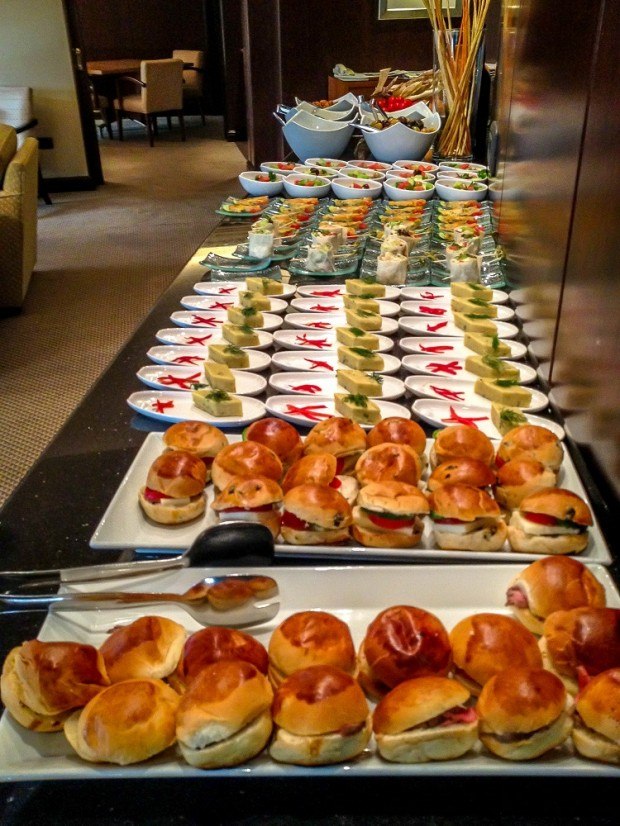
Do your homework. Once you accumulate points in different programs and begin spending them on free travel, some points may prove to be more valuable. Also, if you accumulate large balances in one program or need points in another program, it is possible to exchange your reward points and flight miles between your existing programs. For Hilton, allows you convert points between airline, rail and other programs into Hilton Honors points.
Even with points/miles, it can take cash
Points and miles are considered currency. And they have a tangible value. In the event of a divorce, they are considered an asset that is divided. And some airlines will allow you leave your miles to someone in your will when you die.
But even if they have a value on their own, many programs, particularly the airline programs, won’t let you actually use your miles without a cash fee on top of it. Those fees vary, but you need to factor them into your calculations.
However, one of the biggest changes to the hotel programs in the last few years is the addition of Cash and Points rewards. You put up some points and some cash. This can be either a fantastic value or a terrific waste of points – depending on the property and the room rate for the exact dates you want to visit. Do your homework before using a Point-and-Cash scheme.
Earn points for shopping
All the major frequent traveler programs have mileage malls or online shopping malls. Essentially, you earn miles or points per dollar spent in the online malls. If you do any amount of online shopping, you should always go through a mileage mall to earn points for something you are doing anyway. This is a great way to earn large bonuses!
To get big rewards, you need to go for credit cards
To receive the really big mileage/points benefits, you need to sign up for credit cards with their lucrative perks. This is a massive topic and we write about frequently, however, here is a short version to travel hacking with credit cards.
Yes, you can travel hack without a credit card, however, to really scale your activities, you need a travel credit card. The best travel credit card is the one that works for you and your goals. You need to know what you want to accomplish (free flights, free hotels, a mix of both, etc.) and then register for the card that meets your goals.
If you live in a major airline hub, you might register for a specific airline card. For example, if you live in Atlanta, you might get the Delta credit card, or a United card in Denver or an American card in Dallas. If your goals are hotels, you might register for a hotel-specific card.
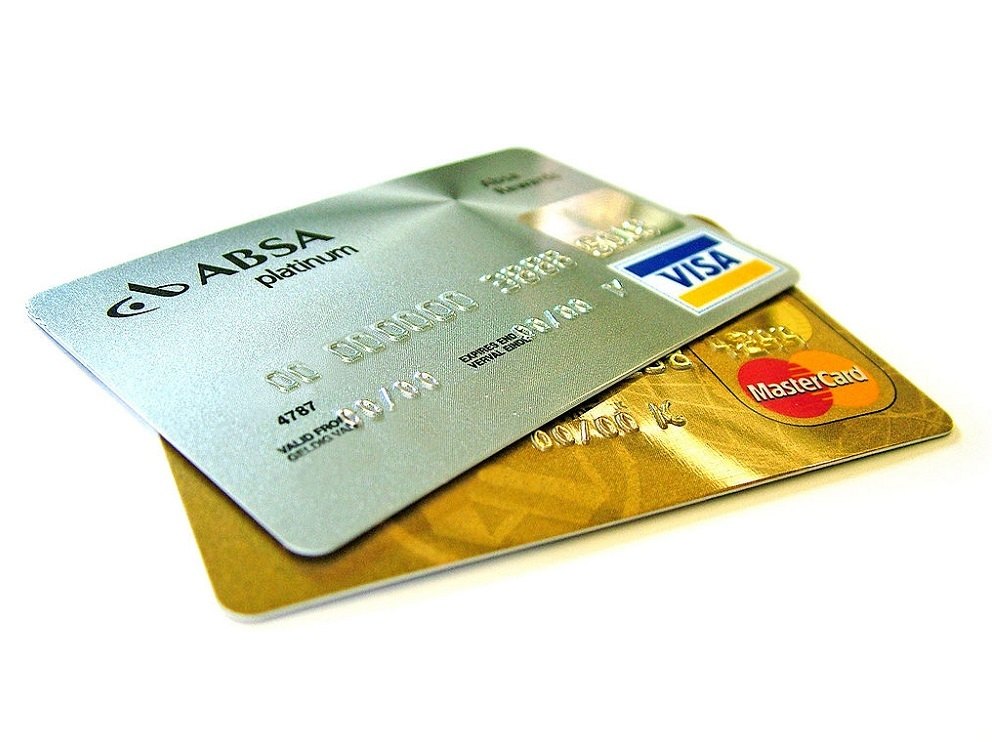
But, if your goals are more general and you don’t have a specific travel provider, consider getting a general travel card that will allow you use your points with any airline or hotel. The much advertised Capital One Venture card and Chase Sapphire are two of the more popular general cards.
To make hacking with credit card work, look for a card with a nice welcome bonus (for example, many airline cards offer 25,000, 40,000 and even up to 100,000 bonus miles). At the same time, make sure that the required spending level is achievable for you. If you can’t spend the $5,000 in 3 months to get the 40,000 miles, that is of no benefit to you. Pick the largest welcome gift for the least amount of spend. Then check and try to find a card with the lowest annual fee. Most cards will waive the annual fee for the first year. This is ONLY a good idea if you have decent credit and you pay off your bills in full and don’t carry a balance.
That welcome gift and the spending will get you a long way to your goals. But most travel hackers also “churn” their credit cards. Signing up for a card, keeping it through the welcome period and for a while beyond, and then cancelling. And then coming back and signing up for the same card again after a period of time. Each credit card has rules for “churning” and they may have a waiting period of 12 to 48 months before applying again. But in the meantime, there are other programs or credit cards. This is really pro-level travel hacking.
Manufacture spending to realize big rewards
Once you have your travel rewards credit card, you can earn massive amounts of miles/points through a process of “manufactured spending.” You can manufacture spending on your credit card and then get reimbursement for it. If you work for a company, see if they will let you use your personal card for business expenses and then you get reimbursed for it.
If you go out to dinner with a group, be the person who pays and then get cash from your friends. There are almost an unlimited number of options if you think creatively. The key is: manufacture spending on your credit card and while obtaining cash to pay it off.
This site uses Akismet to reduce spam. Learn how your comment data is processed .

- Travel Hacking
A Beginner’s Guide To Travel Hacking : Earning a Free Flight In Under 15 Minutes
by Jason Moore
How To Earn a Free Flight In Under 15 Minutes
* This article will help you avoid wasting time visiting a million different websites and provide all of the nuts and bolts of travel hacking so you can get started today.
Disclosure: Zero To Travel has partnered with Daily Drop for our coverage of credit card products. Zero To Travel and Daily Drop may receive a commission from card issuers. We appreciate your support.
A free flight in 15 minutes? You probably think I’m full of horse doo doo.
Just another idiot dude on the internet with some outrageous claim that can’t possibly apply to my life.
Not so fast!
Well ok, I do act like an idiot sometimes. But nobody is perfect, right?
But here’s the deal – it’s entirely possible to earn enough points for a free flight in under 15 minutes.
Before we dive in, a little education on travel hacking is necessary to provide a game plan that fits your lifestyle and current financial state.
There will be plenty of juicy nuggets along the way including a resource below that can take your game to the next level, so stay with me.
What is Travel Hacking?
Travel hacking involves working within the existing rules set up by airlines, credit cards, and hotels, and using them to your advantage to earn free travel including flights, lodging, and other upgrades.
Travel hacking is not a new thing. According to Wikipedia, the first frequent flyer program was created in 1972 for United Airlines. Loyalty programs have existed for decades.
Heck, I earned my first free flight about 14 years ago.
Travel hacking certainly is a hot buzz word of the moment. It seems like there are more people attempting to hack travel than there are people traveling.
The term ‘hacking’ in general, is overused…sort of like the plot-line to those Rocky films (blasphemy coming from a Philly guy, I know). Hacking implies some kind of matrix unauthorized access.
The truth is that travel hacking is completely legal and much less complex than an NSA spy algorithm.
Although travel hacking sounds sexy and dangerous, in actuality it’s pretty simple to earn free flights on a most basic level.
Is it hard to become a travel hacker?
Getting into travel hacking doesn’t require skeleton keys, retina scans or super-secret knowledge possessed by those lucky few with enough money and time to play the game.
It’s relatively simple to earn free flights and hotel rooms without much disruption or increased difficulty added to already complex lives.
For people who want to jump right into the game without having to weigh the countless options available or do hours of research, the following offers a basic plan to get started immediately.
If travel hacking becomes a hobby, it’s good to follow a few select resources dedicated to the subject. Since credit cards, airline rules and promotional offers are constantly changing, it makes sense to pay attention to maximize mileage and rewards points earning potential. These resources are provided at the end of this article.
For now, let’s keep it simple.
The Beginner’s Guide To Earning Free Flights
Do you know that story about the tortoise and the hare? In Aesop’s legendary tale the tortoise wins due to persistence. The hare could easily win due to his speed, but he becomes overconfident and takes too many risks.
Sometimes speed doesn’t matter as much as consistency over time.
Just like this classic fable, the race to earn free travel can take two approaches.
The difference is, implementing both strategies is key to racking up free travel. Becoming both the tortoise and the hare allows for optimal rewards points hoarding.
The Tortoise Travel Hacker: Earning Rewards Points Over Time The Old Fashioned Way
“The best time to plant a tree was 20 years ago, the second-best time is now.” -Chinese Proverb
This is true for most things in life if not all. Whether it’s starting a business, getting in shape, or earning free travel, if you haven’t gotten started yet then now is the time.
Here is an easy two-step process for Tortoise Travel Hacking
Step 1 – Sign up to join all rewards and frequent flyer programs
All of these programs are free. Don’t waste time signing up for every airline and hotel right this second. When you stay at a new hotel chain or fly a new airline, make sure to sign up for their program at that time to earn credit. Never take a flight or stay in a hotel without earning some type of points or miles.
To go a step further, you can always check the hotel or airline’s website before you book and see if they are running any promotions that can earn you bonus miles/points.
A List Of All Airline Websites
Over time you’ll end up with many frequent flyer and hotel rewards accounts. To track them all join Award Wallet , which is a service that helps to manage personal loyalty program accounts.
Here is a partial screenshot of my account.
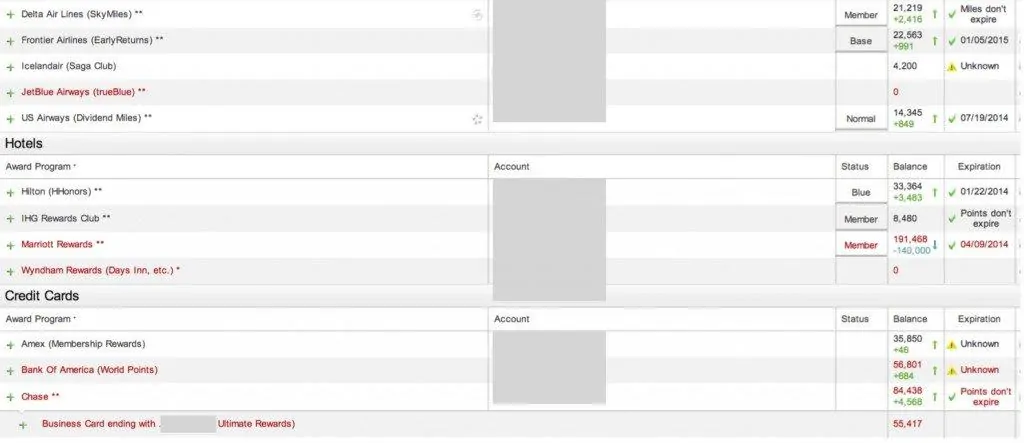
The reason why I suggest joining Award Wallet is that it will help you track everything in one place. Plus, they will alert you when points or miles are about to expire.
I have foolishly lost miles in the past (pre Award Wallet) because I simply couldn’t keep track of my accounts. With Award Wallet’s help, I’ve been notified and was able to purchase small amounts of miles and points in order to avoid losing them all.
Step 2 – Be a repeat customer
Fly the same airline and stay in the same hotel chain as much as possible.
Loyalty programs were created for this specific reason, and it works. Find the companies you like and stick with them. It’s not always possible due to cost or availability but try your best to be a repeat customer. Over time these points add up to earn you free travel and hotels.
Again, this is the slow boat to earning free travel. To kick things up a notch you’re going to have to get into the travel rewards credit card game.
Now, let’s put you on the fast track to earning a free flight anywhere in the world.
The Hare Travel Hacker: Credit Card Travel Rewards
I’ll admit, it’s sort of boring to read about credit cards (yuck!). Why is it important? This is, by far, the fastest way to earn free flights, hotel rooms, and other travel-related goodies.
If you want to get off to the races fast, the only way to earn tens of thousands of miles for free flights without having to sit on hundreds of hours of flights is to sign up for credit cards that offer bonus miles or points.
Here is a regularly updated list of the Best Travel Rewards Credit Cards .
Credit card companies get a new customer, and you get free flights or rewards.
In my opinion, earning free travel via credit card rewards is not a game you should be playing if you cannot figure out a way to do these 2 things:
1. Pay your credit card bill in full every month and carry absolutely no credit card debt.
Are you fiscally responsible?
If you carry credit card debt does it make any sense to get another credit card and go into more debt? I would say no. I’m not a professional financial advisor and don’t pretend to be, but part of active travel is not running yourself into a financial hole!
If I were dishing advice, and I guess I am, then I would only take on new credit cards if I had the ability to pay my bill in full monthly, and no existing credit card debt.
When it comes to credit card spending, start conservatively. Earn a free flight or two and make sure the extra responsibility of added credit cards isn’t a burden.
After that, you can step up your game. After all, what’s the point of earning all of this free travel if you can’t afford to take the trips!
2. Ability to meet the minimum spend requirements to earn the points.
When you sign up for a travel rewards credit card you must meet their minimum spend requirements in order to earn the points bonus. For example, my favorite travel rewards card is the Chase Sapphire Preferred . This card requires you to charge $4000 in the first 3 months but you will receive 60k points. You can learn more about this card here!
That’s a lot of freakin’ money!
I know..but don’t worry.
Notice it’s charge $4000, not necessarily spend. Charging on your card is not the same.
More on that shortly, first…
What Are You Waiting For?
The bottom line is this; if you are currently carrying a credit card and it doesn’t earn you any rewards points you are wasting a huge opportunity.
Living in the United States, options are nearly unlimited when it comes to rewards credit cards.
If there is a card in your wallet that gets used and does not benefit you in some way, it’s time to pay it off, cut that sucker up and sign up for a card that actually benefits you.
Travel hacking with rewards credit cards can get complicated due to the sheer volume of choices in rewards credit cards. Not to mention keeping track of all the rules, minimum spend requirements, balance due dates and more.
However, by signing up for multiple credit cards, spending and transferring points you can rack up hundreds of thousands of miles and save big time money on flights, consumer goods, hotels, sports tickets, and pretty much anything you can think of.
You could google search travel hacking right now read every blog post, review and website on the net to find out which credit cards are the best but I’ll save you the time. They all reach this conclusion:
Credit Card Travel Hacking Simplified: The Best Travel Rewards Card To Get
Option #1 the consensus choice for travel rewards credit cards – chase sapphire preferred (annual fee: $95/year).
I’ve had the Chase Sapphire Preferred card for as long as I can remember having travel rewards cards. This card offers the best overall deal for personal cards.
Current Offer: Earn 60,000 Ultimate Rewards points after spending $4,000 within the first 3 months of account opening. Learn more
- 10X miles on hotels and cars booked through Capital One Travel
- 5X miles on flights booked through Capital One Travel
- Unlimited 2X miles on all other purchases
- No foreign transaction fee
The Chase Ink Business Preferred is the best overall deal for business cards. Learn more!
Current Offer: Earn 100,000 bonus points after spending $8,000 in the first 3 months from account opening.
- 3X per $1 on the first $150,000 spent on total purchases for these categories each year (then 1X per $1 after): shipping purchases, advertising purchases, internet, cable, and phone services, and travel
- 1X per $1 on all other purchases
Both cards allow you to easily redeem points via Chase Ultimate Rewards for flights and hotels, among many other things
If you are going to roll with one or two cards, check these out and see if they will work for you & your needs. Avoid the annual fee by canceling before the end of the first year, if you wish.
Note: The Chase Ink Preferred is a business card . If you don’t have a formal business you can apply as a sole proprietor which is essentially just claiming that you are a business. It may require calling the credit card company and explaining to them what you do. Having a small side hustle could qualify you for a small business card like owning a blog or selling on Etsy for example. Learn more!
Check out How to Start a Sole Proprietorship (note you don’t need to fill out any legal papers) Consult with a tax professional for more details. If you apply as a sole proprietor your Tax ID number is your social security number.
Option #2: The Hotel Rewards Card with Miles Transfer Opportunities – Marriott Bonvoy Boundless® Credit Card (Annual Fee: $95/year)
Runner up according to popular opinion, blogs and the like is the Marriott Bonvoy Boundless® Credit Card f or the opportunity to book some higher-level lodging and the ability to easily convert and transfer points to a designated frequent flier account and earn even more miles in the process. Learn more!
Additional Benefits
- Enjoy a Free Night Award every year after your account anniversary (valued up to 35,000 points)
- Earn 1 Elite Night Credit towards Elite status for every $5,000 you spend
- Receive 15 Elite Night Credits each calendar year
- Progress to Gold Status when you spend $35,000 each calendar year
Option #3: Choose a Card Based On Your Local Airport
If you live near Philadelphia, that airport it is the hub for US Airways then it may make sense to keep your eye on US Airways cards deals if you love flying that airline.
List of Hub Airports
The reason why I prefer Option #1 and #2 is because it’s easy to transfer points to many different airlines so why limit to one card that is dedicated to only one airline?
Keep It Simple
But we are keeping it simple. Want to test the waters with credit card travel hacking? Move forward and:
Learn more about the Chase Sapphire Preferred Card
Able to handle another minimum payment and want double points? Jump in and:
Learn more about the Chase Ink Business Preferred Card
When applying, I spread out my applications to avoid the burden of spending massive amounts in a short time.
If you like Option #2 or want to add more cards into your rewards portfolio go ahead and:
Learn more about the Marriott Bonvoy Boundless® Credit Card.
After Signing Up
Track all cards and rewards programs.
Sign up for Award Wallet
Meeting the Minimum Spend
This can be tricky, but as I mentioned earlier think of this as a charge. There are ways to charge this money without actually spending your own.
How is that possible?
Check out this article on meeting the minimum spend for your travel rewards credit card and it will make sense.
10 Creative Ways To Meet the Minimum Spend Requirements
Another very basic way to avoid stress with minimum spends is to just time your rewards card applications with a big purchase you need to make.
For example, planning on buying a new computer? Snag a rewards card before that purchase so it goes towards the minimum spend.
There are plenty of other creative ways to meet the minimum spend so don’t let this seemingly large obstacle intimidate you.
Earning a Flight In Under 15 Minutes
Circling back to my promise at the beginning, here is how I earned a flight in under 15 minutes.
First I applied for a Chase Ink Business Preferred Card , which took about 10 minutes.
Secondly, did you know that you could pay your taxes with a credit card?
Since I paid virtually no taxes during the year I owed a lot of cash money to the feds.
Thankfully, the money was set aside. Once the Chase Ink Business Preferred card arrived, my federal taxes were charged on it and the balance was paid off immediately.
Even without owing taxes the same principle can apply by again, timing rewards card applications with a big purchase.
Where To Pay Taxes With a Credit Card
Travel hacking with credit cards isn’t complicated, and certainly nothing to be intimidated by. Start with one card, and get going. For more advanced strategies:
The Final Word
It’s worth noting that when rewards points are used for miles for ‘free’ flights you may still be responsible for paying taxes and fees. However, this cost is minimal.
Sure, all of the tracking, spending and applying for cards or mileage points can be a bit tedious when the time comes to book a flight and rewards points
But when the time comes to book a flight and rewards points land you halfway across the world for virtually nothing, the minor effort is more than worth it.
Sit back, smile and enjoy your free flight. Safe travels my friend.
What do you think about travel hacking? Do you have any tips or strategies? Leave comments below.
Want to save thousands of dollars on travel? Tune into the Zero To Travel Podcast, with over 12+ million downloads worldwide you’ll discover plenty of new and affordable ways to explore the world.
Subscribe to the Zero To Travel Podcast Now
*Opinions expressed here are the author’s alone, not those of any bank, credit card issuer, hotel, airline, or other entity. This content has not been reviewed, approved or otherwise endorsed by any of the entities included within the post. Zero To Travel has partnered with Dialy Drop for our coverage of credit card products. Zero To Travel and Daily Drop may receive a commission from card issuers.
You're almost there!

Drop your email below so we can send your FREE course!
Success! Now check your email to confirm your subscription.
There was an error submitting your subscription. Please try again.
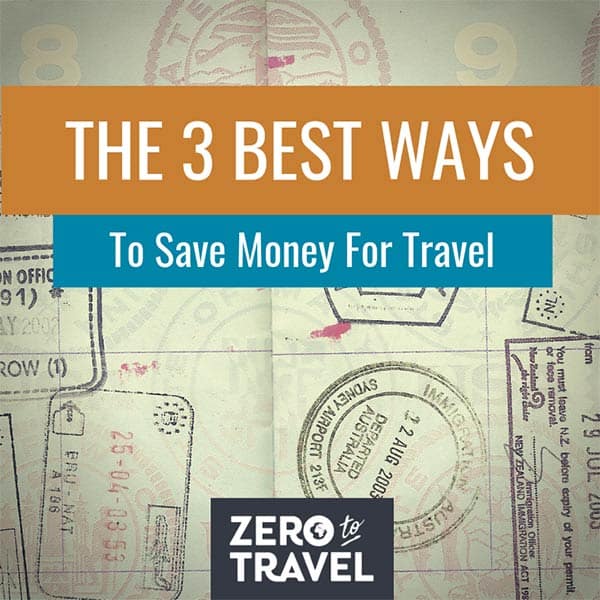
Want to Travel More?
You need a plan. Sign up to access this mini-course, get exclusive content and join our amazing community of travelers. It’s all FREE!
You're in! Check your email for your free guide!
Recent posts.
- Greatest Hits: Adventure and Conservation – A 6,000 km Tuk-Tuk Journey Through Africa
- Bicycling Across the USA Without Money in Search of Human Connection With Daniel Troia
- Greatest Hits: Sustainable Travel 101 (How to Be A Better Traveler) With Richard Hammond
- New Zealand: Top 10 Hidden Gems, Campervan Lifestyle (Tips and Tricks), and Doing Life Differently With Lisa Jansen
- Greatest Hits: Biking the World for Climate Change With Devi Lockwood
Recent Comments
- nck crack without box on Road Tripping Europe To India : Daily Life On A Land Rover Overland Adventure
- Nora on Turn Travel Into A Lifestyle With Goats On The Road
- Jason Law on Top 10 Road Trip Albums
- Svanna Clariot on Atlas Obscura: Curious World Wonders
- Kylie on Hitchhiking: Myths, Facts and Beyond
- February 2024
- January 2024
- December 2023
- November 2023
- October 2023
- September 2023
- August 2023
- February 2023
- January 2023
- December 2022
- November 2022
- October 2022
- September 2022
- August 2022
- February 2022
- January 2022
- December 2021
- November 2021
- October 2021
- September 2021
- August 2021
- February 2021
- January 2021
- December 2020
- November 2020
- October 2020
- September 2020
- August 2020
- February 2020
- January 2020
- December 2019
- November 2019
- October 2019
- September 2019
- August 2019
- February 2019
- January 2019
- December 2018
- November 2018
- October 2018
- September 2018
- August 2018
- February 2018
- January 2018
- December 2017
- November 2017
- October 2017
- September 2017
- August 2017
- February 2017
- January 2017
- December 2016
- November 2016
- October 2016
- September 2016
- August 2016
- February 2016
- January 2016
- December 2015
- November 2015
- October 2015
- September 2015
- August 2015
- February 2015
- January 2015
- December 2014
- November 2014
- October 2014
- September 2014
- August 2014
- February 2014
- January 2014
- December 2013
- November 2013
- October 2013
- September 2013
- Destinations & Culture
- Digital Nomad
- Inspiration
- Is It Worth It?
- Travel Jobs
- Travelosophy
- Uncategorized
- Entries feed
- Comments feed
- WordPress.org

You need a plan. Sign up to access this mini-course The 3 Best Ways To Save Money For Travel , get exclusive content and join our amazing community of travelers. It’s all FREE!
You're signed up! Check your email to access the mini-course!
Point Hacks & Travel Hacks Beginners Guide
Immanuel Debeer | 31/03/2023
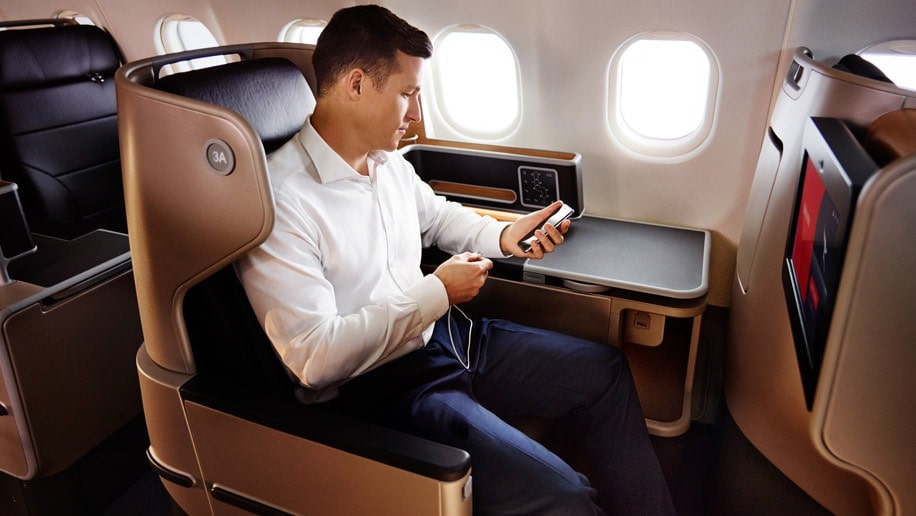
Point hacking or travel hacking as it’s known is by far the best way to travel in luxury on a budget. How so?
By maximising credit card, hotel and airline loyalty programs, you can minimise your total travel expenses to a fraction of the retail price. Points & travel hacking allows me to travel in style throughout the year, simply by applying methods and tricks accessible to almost anyone who is willing to learn.
Travel hacking is the art of obtaining frequent points in the cheapest possible fashion and then redeem them for extravagant travel without actually paying the price.
How to get started with points/travel hacking?
On this page, my aim is to give you a brief overview of how you can get started on your point hacking/travel hacking journey. The aim here is to bring you up to speed as fast as possible so you can understand the basic concept and hopefully get a basic understanding about the value points and miles can bring you.
If you’ve stumbled upon this points hacking/travel hacking page, I assume you’re a total newbie to the game. If you’ve already redeemed points for business or first class flights, this intro guide probably isn’t for you! Continue on points hacking and maybe one of our other frequent flyer guides can be of value to you.
Before we jump into the nitty-gritty of how it all works, I would like to lower your expectations…
The biggest myth about frequent flyer points and miles is those claiming “I travel business or first class for free” .
Guess what, there’s no such thing as a free lunch, and the same is the case when it comes to points hacking. Anyone telling you this hobby is free is simply lying (usually to get attention and click-bait you with some catchy headline).

Now that I’ve crushed your points hack dreams of travelling the world for free, here’s the cool thing: frequent flyer points allow myself and many others to fly in premium cabins for a fraction of the price. Usually, the cost of our flights is less than the price of an economy ticket.
Points/Travel Hack Tip 1: Patience
As a frequent flyer points newbie (and aspiring travel hacker in Australia), you will probably be scared off by the number of miles and points required to actually fly business or first class. All I can say is, Rome wasn’t build in a day, and neither is your points balance. When I started with this ‘hobby’ , It took my 1 year of hustling to save up enough points to make my first redemption in business class for 2 passengers from Australia to Europe. A lot of people I talk to expect to hear about some magic trick which will allow them to travel for peanuts and zero work. Tomorrow.
The Good News
Here’s the good news, if you’re somewhat financially savvy, have a steady income (sorry but frequent flyer points aren’t a great hobby if your only objective is to save money. You need to pay in order to play) and are willing to learn. Some people (myself included) become obsessed with frequent flyer points; it’s all we think about. Every. Single. Day.
We talk about it all day long, and eventually, you will find that family disowns you and friends zone out as soon as you start talking about your latest ‘points’ hack. This OK and totally normal, I’m happy to let you know that there are online communities FULL of people like us who nerd out over points and luxury travel.

For those that want things ‘now’ and preferably with no effort involved… I wish you good luck, but this hobby probably isn’t for you either. It scares me to think about all the time I’ve spend reading, writing and talking about points and travel hacks.
Now, if you’re a normal person (e.g. Not like me) and your only goal is to fly long haul somewhere nice once a year with your partner, preferably in business class (or first), I have great news for you! It’s totally doable.
Getting The Points Without Flying
Now you’re probably thinking… what the hell is this nonsense, I have no time to fly around and earn frequent flyer points just so I can redeem them for business or first class flights once a year.
It’s OK! The great thing about frequent flyer points (and point hacks) is that you don’t actually need to fly to earn them! In fact, I hardly earn any points from actually flying.
The reality is that the frequent flyer programs run by the airlines are a massive cash cow. Heck, in some cases the frequent flyer program is more profitable than the actual airline itself! The way frequent flyer programs make their money is by selling the points to companies who will then use them (the points) as a marketing tool to get you the consumer to use their service or buy their product.
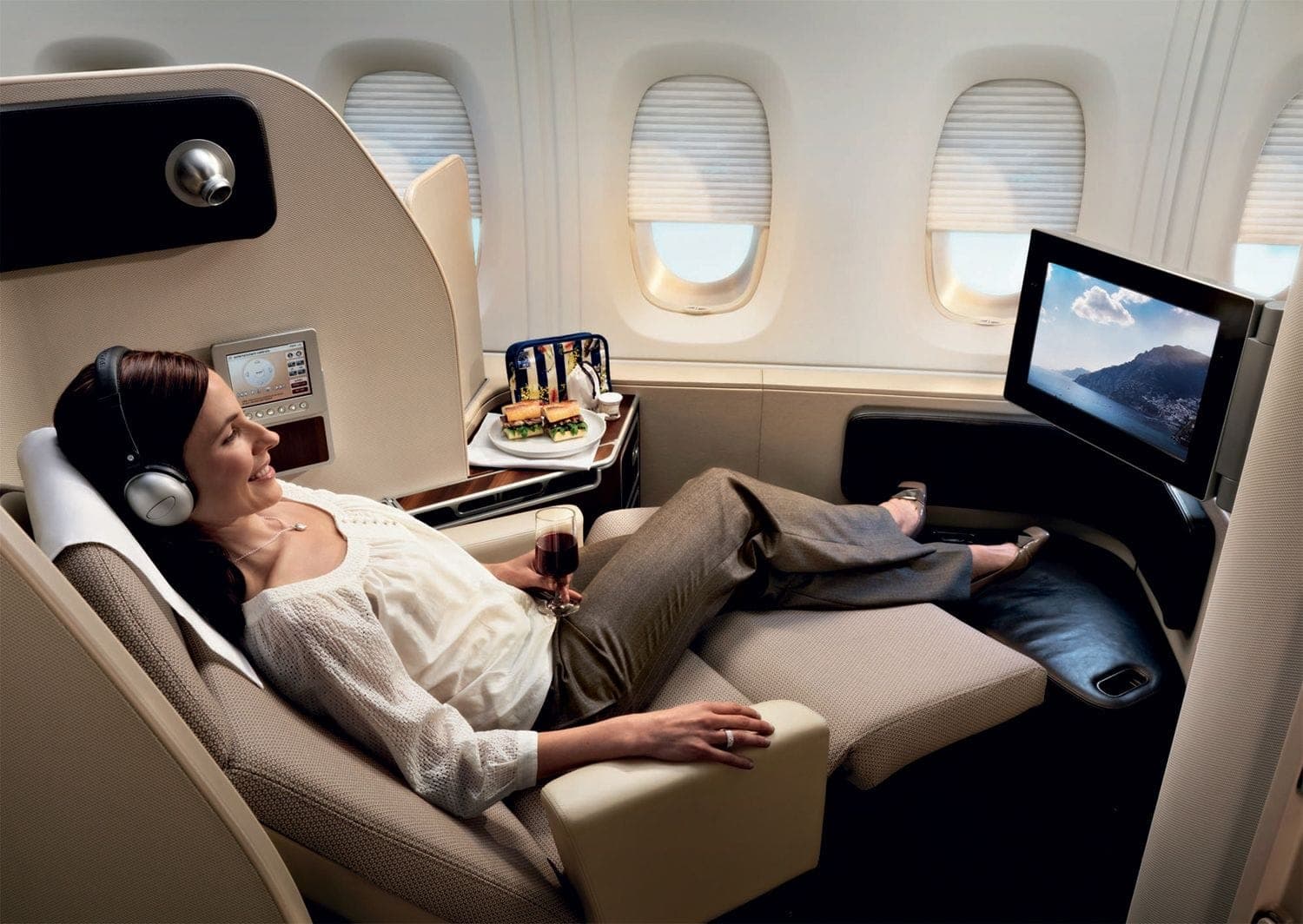
The reason frequent flyer programs are so profitable is because you can redeem your points for many things: toasters, treadmills and other random crap with a low cash value. And guess what? The majority of people will spend their points on these material things or cash them in for vouchers.
If you’re reading this, you’re the minority.
As it stands, the minority redeems their points for luxury travel which would otherwise cost tens of thousands while the majority redeems their points for toasters. Ying and Yang!
One of the biggest customers for airline rewards are financial institutions: banks and credit card companies. And here lies the biggest opportunity for someone that doesn’t actually fly, to earn frequent flyer points — a lot of them.
Here are some way you can earn a lot to points and start points hacking without stepping a foot inside an aircraft:
Points Hack Tip 2: Credit card sign up bonuses
Most banks and credit card companies will try to compete in the market to win over the customer by offering big sign up bonuses. This allows you to earn hundreds of thousands of frequent flyer points with a single sign up. Personally, I have 8 active credit cards under my name, and if you’re wondering; my credit score is outstanding (check our credit score guide here ).
For the best sign-up bonus deals visit our frequent flyer card page !
Points Hack Tip 3: Spend every single dollar on your card
Now that you have a card or two, it’s time to get savvy. Personally, I don’t spend any money in cash or via debit card unless there really isn’t another way.
This means that my cash is safely tucked away in my high interest-earning bank account, working for me while I make use of the credit the banks have allocated to me.
Now here’s the crucial thing: you need to be in control of your finances! It’s very easy to overspend so it’s vital that you know what you can afford and pay your card balance in FULL every month.
This way you won’t pay any interest. Paying interest on a frequent flyer card will quickly render any points earned useless. The other thing you need to focus on is getting the maximum points for every dollar you spend. For example, certain cards will pay you 1.5 points per dollar for shopping at a supermarket while others might only pay 0.5.
This is where some learning is required in order for you to use the right card for the right transaction. It’s all about optimising, and although on a small transaction it might not seem like a big deal, when you add it up over the years, the difference is staggering.
Points Hack Tip 4: Get points for shopping.
Whenever you need/want to spend money you need to ask yourself, can I get any extra bonus points apart from using my frequent flyer credit card? More often than not, the answer is yes! In Australia Qantas, Virgin, Singapore Airlines and Asia Miles all have only portals where you will find retailers such as David Jones, eBay and the likes who offer you bonus points by simply click through on their links.
Points Hack Tip 5: Play the supermarket game.
Aldi might try to convince us it takes 70 years to save up enough points for a hairdryer by shopping at Coles or Woolworths; we’ll I’m happy to call them out on their bullshit. Savvy shoppers can easily earn a lot of points through the supermarket programs.
All you have to do is keep an eye out for the targeted promotions they send you. Usually, the supermarket giants will try to get you to spend a certain amount to get X amount of bonus points.
By signing up to multiple accounts, you can trick their systems and pick and chose the offers that work for you. Not using one Flybuys card for a few months will usually prompt the loyalty system to send you an offer to get you to come back. You just have to beat them at their own game.
Points Hack Tip 6: Dining and wining.
Next time you’re out, pick up the tab! Your friends will think you’re fantastic (until you ask them to repay you in cash), and you walk away with the points. On top of that, there are portals such as Qantas Restaurants which give you points for simply making a restaurant reservation with them. Easy. Wine drinkers are in luck too; Qantas has an online wine shop which sometimes offers great bonus point deals. However, you have to do the maths to see if the deal is actually a deal.
Summing Up: How To Get Started With Points/Travel Hacking
To get started, I would recommend you set a goal first; where do you want to travel, how many tickets do you need, in which class and with what airline?
Once you figure that out, it’s time to get to work and chose the frequent flyer programs which will enable you to reach your travel hacking goal. In Australia, the main suspects are of course Qantas ( check our Qantas Classic Flight reward guide here ) and Velocity Frequent Flyer but don’t let that limit you. They are by far the best programs out there, BUT they are the easiest when it comes to opportunities to earn a lot of points.
Once you get more advanced and delve deeper into the realm of frequent flyer points, you will soon figure out that there are a lot for programs out there which you can use.
Check out our frequent flyer guide page for lots of detailed guides!
Although it’s best to focus on only a couple of programs as a beginner, my advice is always to go with a flexible reward program. For example, Amex Membership Rewards lets you transfer to a range of airline partners at 1 for 1 ratio. This way, you can figure out the most cost effect or most fun route to get to your destination and transfer points to the program, which is best suited for your plans.
Now it’s your turn! Make sure to subscribe for all our latest points hacks tips in your inbox!

Immanuel Debeer
Chief points nerd and travel hacker at Flight Hacks
Points Hack FAQ
Points/Travel Hacks FAQ

Which airline points are worth the most?
Is points hacking difficult, is points hacking free.
RELATED POSTS

Immanuel Debeer | 23/04/2024
Unlock 1,000 Bonus Velocity Points with DiDi: Here's How
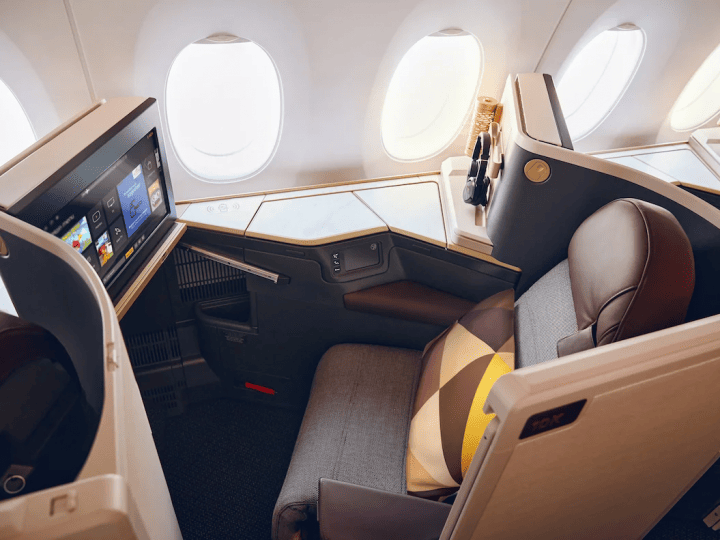
Huge: This Etihad Discount Code Give You Up To 20% Off
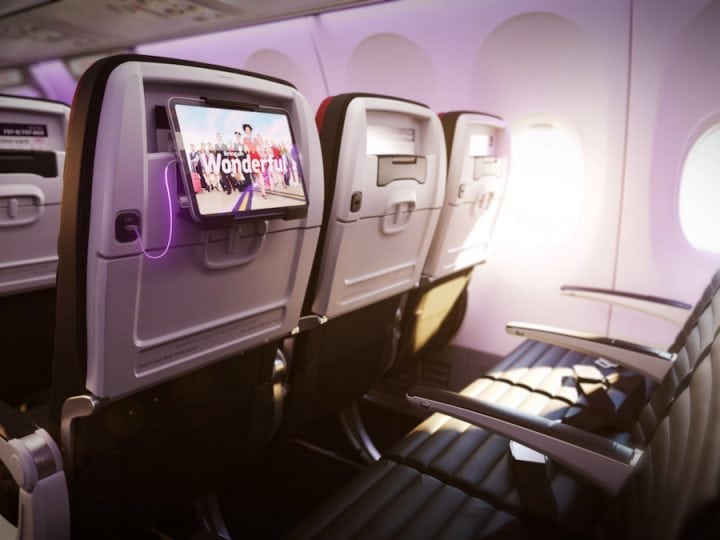
Immanuel Debeer | 20/03/2024
Score 10% OFF Your Next Virgin Australia Flight With This Discount
- Travel Hacking 101: 9 Critical Tips to Know
by Nichole | Last updated Sep 4, 2023 | Travel Hacking
Travel hacking 101. Sounds complicated, but it’s not. With a couple of a few pointers, you will be well on your way to earning points and miles to cash in on free flights and hotels. Suddenly that 2-week trip to Africa or exotic vacation to the Maldives becomes obtainable. No more dreaming. I will warn you though travel hacking can become addicting and super thrilling when you score that amazing redemption.
* Some of the links in this post contain affiliate links. If you make a purchase through these links, we may receive a small commission at no extra cost to you. All recommendations are from first-hand experience that I feel will deliver value to you! Thank you for your continued support.
FOLLOW & SHARE WITH A FRIEND!
01- Pick an Airline Alliance & Stay Loyal
Three airline alliances, #1- free flights, #2- airline perks, how to pick an airline alliance, #1- home airport, #2- where you like to travel, which airline alliance we use, 02- pick a travel credit card, chase vs. amex, sign up when there's a big bonus offer, join forces with your partner or spouse, 03- maximize points with the chase trifecta, chase sapphire reserve, chase freedom, chase freedom unlimited, 04- double dip, #1- shopping portals, #2- dining rewards programs, #3- rakuten, #4- amex offers, 05- know the partnerships , uber & marriott, lyft & delta, american airlines & world of hyatt, british airways & airbnb, 06- lookout for mistake fares, 07- always check the redemption value, redemption value formula, points guy calculator, 08- airlines miles are more valuable , 09- redeem at chase travel portal, final thoughts, related content.
What is travel hacking?
Travel hacking refers to using travel credit cards and airline miles to collect points, so you can cash them out on free flights and hotels, upgrades, airport lounge access, and other perks.
Where do you even begin?
There are many advanced techniques, but these are the 9 steps to get you well on your way to free travel. Let’s dive in.
American Airlines plane
What you need to know is there are 3 airline alliances:
- Star Alliance
An airline alliance is a group of partner airlines that span the entire world. If you have status on one airline, then its partner airlines will also recognize you and give you priority treatment.
Pick one alliance, and stick with it for 2 reasons.
The miles you accumulate can be redeemed for free flights. The number of miles needed for that free flight will vary based on the destination and the fare class you want (economy, business, first-class).
Flying is not the only way you obtain airline miles. You can also transfer your Chase and American Express credit card points into airline miles.
Another way to obtain airline miles quickly is by signing up for a big bonus offer with an airline co-branded credit card.
For example, the United Explorer card offers 50,000 United bonus miles after spending $3,000 in the first 3 months your account is open.
As you accumulate points and gain status, the airline’s loyalty program will usually award you with perks like free checked bags, priority boarding, and lounge access.
* Note, not every airline is part of an alliance. For example, Southwest is not in an alliance.
This will depend on 2 factors:
What major airlines are at your home airport? This really is the main determining factor.
Do you live in Atlanta, Georgia? You will probably pick Delta.
What about Chicago, Illinois? You are probably going with United.
How about Charlotte, North Carolina? American Airlines will likely be your top pick.
Where do you like to travel? Europe? U.S.? Asia?
Which airlines fly to your desired travel destinations? If you only fly domestically or maybe to the Caribbean every now and then, you might not pick an alliance and just stick with Southwest. Your travel goals will help guide this decision.
If you live in the United States, your major airline choices are as follows:
- United (Star Alliance)
- Delta (SkyTeam Alliance)
- American (Oneworld Alliance)
Once you select your alliance, make sure to SIGN UP with your airline’s loyalty program and add that number to EVERY flight you book.
An airline alliance is like a marriage. For better or worse, you are in it. Make sure it is a good one and meets your needs, and you will be rewarded for that loyalty.
PRO TIP : Go to Wikipedia and type in your home airport. It will show all the main airline carriers and the main destinations. Use this information to determine your airline alliance.
Cathay Pacific The Wing Lounge in Hong Kong
Previously, we lived close to a United Airlines hub, so we initially chose Star Alliance and accumulated quite a few points (or I should say my husband did due to his business travel).
Star Alliance is one of the biggest airline alliances and has an incredibly robust network of flight options. You can basically travel anywhere using this alliance.
Now, we live close to an American Airlines hub, so we have switched to Oneworld . We love traveling to Asia.
Cathay Pacific has many routes to Asia and is one of American’s alliance partners. Because of my husband’s status with American, Cathay Pacific recognizes his status which allows access to their top lounges when we travel through Asia.
The Pier First Class Lounge in Hong Kong is probably my favorite lounge ever! Think free wagyu beef cheeseburgers, 15-minute massages, and a private shower after a long flight. Oh, yeah.
The downside to Oneworld is there are not nearly as many travel options as Star Alliance.
If you only can pick one, go with the Chase Sapphire Reserve hands down for two reasons.
The first reason is the $200 airline fee credit with Amex is very difficult to use because it only applies to incidental fees, checked bags, and in-flight refreshments on the one airline you select for the entire year.
You used to get around this by purchasing gift cards from the selected airline and using them to pay for flights, but they closed this loophole.
The second reason is there are many places internationally that do not accept Amex.
The big perks of using Amex are access to their Centurion lounges, their concierge service, and the Amex offers they send out for select retailers.
On the other hand, getting value out of the Chase Sapphire Reserve card is incredibly easy. The annual fee for Chase Sapphire Reserve is $550.
If you travel at all, you are going to be able to easily use the $300 annual travel credit. This drops it down to $250.
If you already enjoy DoorDash services every year, take another $60 off. Now, you are down to $190.
If you decide to take advantage of the Global Entry credit (which you should! if you love international travel), subtract another $100. You are left with $90.
Now you must decide if you will get more than $90 worth of Priority Pass access, car rental insurance, DoorDash delivery fees, and Lyft perks.
We use the Priority Pass lounges frequently, so for us, that alone adds up to way more than $90 a year. If you cannot tell, I love this travel credit card!
Plus, you can redeem your points through the Chase Travel Portal at 1.5x the rate, which will be explained later in this guide .
PRO TIP : Another consideration in the Chase vs. Amex battle is to consider your airline alliance. Chase and Amex have specific airlines they work with as transfer partners. Check to see which credit card partners with your airline alliance. That may help you decide which credit card is best for you.
Courtesy of Shutterstock: Travel hacking 101- pick a card with a big bonus offer
I would only sign up with a travel credit card WHEN there’s a nice welcome bonus offer.
For example, the Chase Sapphire Reserve is offering an 80,000 bonus point offer when you sign up and spend $4,000 within the first three months of the open account. At one point, Chase was offering a 100,000 bonus points offer. However, no one has seen that offer floating around for years.
Also, it’s important to know Chase has the 5/24 rule. You will be denied all Chase cards if you’ve opened 5 new credit cards in the last 24 months.
The standard welcome offer for American Express Platinum right now is 100,000 points, BUT you may be matched for even a higher offer of 125,000 or even 150,000 points!
You must spend $8,000 in the first 6 months to receive the points. If you are worried about hitting that minimum spend to get the bonus, time it around a big purchase (like a home renovation project or a new computer).
An easy way to see if you are matched for the lucrative Amex offer is to go to cardmatch.com and input your demographic information. It will not affect your credit score. It’s only a soft pull.
I’ll be honest. The American Express Platinum is not my favorite travel credit especially because not everyone accepts it when you travel internationally. I use it mainly for the Centurion Lounges, the Uber credits, and the occasional Amex offers.
The reason I signed up for it was because I was offered the high bonus offer. The 150K offer is insane. It’s worth roughly around $3,000! Here’s a snapshot of all the amazing free travel you can book with 150K Amex points .
PRO TIP : If you find that you are not getting value out of the travel credit card after a year, you have two options when it gets close to your card renewal date. Call customer service and let them know you are considering canceling. Oftentimes, they will offer a retention offer in the amount of credit or points to keep you. If there’s no retention offer, another option is to downgrade the card to one with no annual fee.
Do NOT add your spouse or partner to your travel credit card as an authorized user.
It’s best to have your spouse/partner open up their own card, so they can also hit the bonus offer.
This assumes that you are able to spend the minimum required for the welcome offer AND you are still paying off your credit card balance in full every month.
Never pay cash for travel
Never pay cash or use a debit card for purchases.
Use your travel credit card for EVERY purchase.
It all adds up. You always want to earn points. Yes, I am guilty of even charging $1 for a gas station donut. Never lose out on points.
Travel hacking 101: Use the Chase Trifecta Travel Credit Cards
I use this credit card for all travel-related expenses (flights, hotels, rentals, Uber/Lyft, parking, etc) and dining purchases to get 3x points . $550 annual fee.
This card has rotating 5x quarterly bonuses. For example, one quarter Chase may give you 5x points on all grocery and gas purchases. Then all of my grocery and gas purchases for those 3 months go on this card. I only put the 5x categories on this card. $0 annual fee.
This card will give you 1.5x points on all purchases. If my purchase does not fall in the travel or featured 5x quarterly bonus category, then the purchase goes on this credit card. $0 annual fee.
You can see how easily the points add up.
When I redeem those points, I transfer all the points from Chase Freedom and Chase Freedom Unlimited to my Chase Sapphire Reserve credit card.
Then I redeem those points through the Chase travel portal for hotels (or flights if you choose) at 1.5x the rate .
Say you have 200,000 Chase Ultimate Rewards points, which is equal to $2,000 USD. If you redeem those same 200,000 points through the travel portal, they are now worth $3,000 USD. Incredible value!
1 transaction. 2 types of points.
This is my favorite way to accumulate more points and miles. There are four easy ways to double dip when you are first starting out: shopping portals, dining programs, Rakuten, and Amex/Chase offers.
We are all shopping online now from groceries to clothing to home goods. I don’t know about you, but I rarely go to actual stores now.
In addition to the points you receive on your credit card, what if I told you if you take one extra step you can collect even more points to go towards that free vacation?
Welcome to shopping portals!
These portals offer hundreds of different merchants that you are likely already buying from. Think Apple, Home Depot, Sephora, etc.
Many airlines ( American Airlines and United ) and banks (Chase) offer shopping portals. You must log in to the portal’s website, select the merchant you want, and click the link through the portal to direct you to the merchant’s website.
Once you complete the purchase, it will take a few days or weeks to see the points in your account.
How do you know what shopping portal to use? Go to Cashback Monitor . Type in your merchant, and see which portal is offering the most amount of points or cash back.
Cashback Monitor screenshot
For example, say you need to purchase a cute sundress from Macy’s for that wine vacation you are planning to Portugal this summer.
Type Macy’s into Cashback Monitor’s search box. You find American Airlines Advantage is offering up to 4 miles/$ spent. See the screenshot above.
Log into your American Airlines account and select Macy’s in the shopping portal. American Airlines will take you directly to Macy’s website.
Complete the purchase with your Chase Freedom Unlimited card and receive 4 miles/$ PLUS the 1.5x Chase points! Cha-ching.
Love dining out or grabbing takeout when you don’t feel like cooking?
Here’s yet another opportunity to double dip.
Certain airlines (American, Alaska, Delta, Spirit, JetBlue, Southwest, United) and hotels (Hilton, IHG, Marriott) offer dining rewards programs, which are operated by the Rewards Network.
Most points experts agree airline miles are more lucrative than hotel points.
All you need to do to get started is sign up for the program, register your travel credit card, and pay for your meal at a participating restaurant. Check which restaurants participate by typing in your zip code on the program’s website.
For example, if you join the AAdvantage Dining Program , you’ll get 1 mile per dollar paid, 3 miles per dollar if you agree to receive emails from the program, or 5 miles per dollar if you receive emails AND make 11 transactions in the calendar year.
Now you’ll get extra miles per dollar spent PLUS 3x the points with your Chase Sapphire Reserve card for a lovely meal out.
My Rakuten membership
I have been a member of Rakuten since 2010! It used to be known as Ebates. It’s a rewards program, where you can get cash back or extra Amex points for purchases you were going to make anyway.
To date, I have earned a total of $3,696.76!
Not bad considering there is little extra effort involved.
Go to Rakuten’s website and type the merchant you are looking for in the search box. The merchant will pop up if it’s a participating retailer with Rakuten.
For example, we recently booked a hotel through booking.com. I first went to Rakuten and typed booking.com in the search box. The current offer is 4% cash back.
I clicked on the “shop now” link, which directed me to the booking.com website. Once I complete my stay at the hotel in the next coming months, I will receive a check for 4% cash back.
Not bad for taking that one extra step.
PRO TIP #1 : Always check for mobile-only pricing on travel booking websites. When I recently went to booking.com through Rakuten’s website on my cell phone, I was shocked to see the cost of my hotel was $447 cheaper for a 4-night stay in the Maldives!! Not only am I getting 4% cash back with Rakuten but an additional $447 simply because I made the reservation on my phone instead of my desktop.
PRO TIP #2 : Reach the required amount of stays with booking.com and become a Genius member for even deeper discounts (10-20%)!
Screenshot of mobile-only pricing on booking.com
Travel hacking 101: Take advantage of Amex offers
Amex Offers are another great way to double dip. Amex will periodically offer you additional discounts at select retailers. The offers will be listed on your Amex’s home page after you log in.
The Amex Offers will list what you need to spend to get the offer and the expiration date. You have to select “Add to Card” next to the offer to get the discount when you use your Amex card.
Remember these offers are in ADDITION to the points you will already be receiving on your Amex card for the purchase.
Chase has started a similar program, but I haven’t found the offers to match as well to my personal shopping habits.
There are certain partnerships you need to remember to keep banking more points. Here are examples of a few of them.
Link your Uber and Marriott Bonvoy accounts and get 3x hotel points per dollar spent on Uber rides and 2x hotel points per dollar spent on Uber Eats.
Link your Lyft and Delta SkyMiles accounts and get 1 mile per dollar spent on Lyft rides. If you use your Chase Sapphire Reserve card to pay for the ride, you can double dip and get 10x the total points!
Link your American Airlines and World of Hyatt accounts . Earn 1 Hyatt point per dollar spent on American Airlines flights. Earn 1 American Airline mile per dollar spent on Hyatt stays.
Sign up for a British Airways account. Book your Airbnb stay or Airbnb experience through this British Airways’ link . Then collect 3 Avios miles per £1/€1/$1 spent with Airbnb. These miles can be used later for reward flights.
Courtesy of Shutterstock: Travel hacking 101- look for mistake fares
I haven’t taken advantage of a mistake fare yet but can’t wait until I do!
A mistake fare occurs when there’s an airline price glitch resulting in a massively cheap flight. This mistake can be due to technology issues, human error, or communication problems.
Think like a $63 roundtrip flight to Chile from The United States.
Now, you could just get lucky and happen to come across one, or you can constantly search specific routes. Who has the time for that?
A better way to stay informed if a mistake fare does occur is to join a subscription like Scott’s Cheap Flights . Add your home airport, and their expert team will continuously scour the internet to find you the best flight deals.
If you do find a mistake fare, act quickly because normally it only lasts a few hours before the error is corrected.
Remember the 24-hour rule. Any flight that touches United States soil allows you to cancel your flight for free within 24 hours of booking as long as it’s not too soon before the day of the flight.
Book the mistake fare, figure out the details, and cancel for free in 24 hours if it’s not going to work.
We love getting good value for the money.
I am always looking for a good coupon or promotion before I make a purchase or going back to get a price adjustment on something I just purchased if the price drops.
Once you have accumulated all those airline miles or hotel points, you will want to start cashing them in for free flights or hotels. You will need to know if you are getting a good redemption rate for all those hard-earned miles and points.
There are two ways to figure this out. One requires a little math, and the other is plug and chug.
Travel hacking 101: Redemption Value formula
Plug in the information using the formula above. Then go over to the Points Guy’s estimated Monthly Valuations of some of the top hotel brands and airlines.
- If my redemption value is < the estimated Monthly Valuation of that particular airline/hotel, then BOOK WITH POINTS/MILES.
- If my redemption value is < the estimated Monthly Valuation, then PAY CASH. It’s not worth the points.
- If it’s equal, then it’s your call but some factors may lean you in one direction than the other. For example, some locations add an occupancy tax to the hotel rate. But if you pay with points, you may avoid that dreaded tax.
Alternatively, use the Points Guy’s Calculator to quickly determine if you are getting good value if you redeem those airline miles or points.
Courtesy of Shutterstock
You put all these tips into practice, and now you have accumulated a bunch of points on your travel credit card.
Now what? How do you start redeeming this travel currency into free flights and hotels?
Chase and Amex allow you to transfer your points to airline partners and hotel chains.
Chase has 11 airline partners and 3 hotel chains, and Amex has 17 airline partners and 3 hotel chains. When you are ready to redeem your points, transfer your Chase Ultimate Reward (UR) points or your Amex Membership Reward (MR) points to your selected airline or hotel.
Occasionally, Chase and Amex will offer a bonus for point transfer. For example, Chase Sapphire Reserve is currently offering 30% more bonus points if you transfer your credit card points to Virgin Atlantic Flying Club.
Once the points are transferred, complete the booking. Always check your redemption value to make sure you are getting good value out of your points.
In general, airline miles are more valuable than hotel points. The redemption values can be pretty incredible. Of course, this all depends on your personal travel needs and goals.
We used airline miles on our Africa trip to get us from the United States to Zimbabwe and from Johannesburg back to the United States. This saved us an incredible $3,296 on flights between the two of us!
Don’t miss my article on how we used airline miles and Chase points to save over $6,800 on our dream Africa trip!
The other way you can redeem points is through the Chase travel portal.
If you have the Chase Sapphire Reserve Card, your points get boosted from 1 cent per point to 1.5 cents per point .
For simple math, let’s say you have 200,000 Chase points sitting in your account. Those points are worth $2,000. However, if you go through the Chase travel portal to book that cute little boutique hotel in Aruba , the value gets boosted 1.5x to 300,000 points. A $3,000 value!
Here is an example of how we put our Chase points into practice.
We enjoyed an epic 2-week trip to Africa that would have cost a small fortune. However, our Chase UR points erased most of our hotel costs. We used 239,138 points to save us a whopping $3,587.07 on hotels! Here’s proof below.
Airline and Credit Card Points Used for Africa Trip
I hope this travel hacking 101 guide gets you well on your way to the world of accumulating miles and points toward free travel!
Pick your airline alliance, get the Chase Trifecta with a big bonus offer, start double dipping, and cash in those points if you’ve got a good redemption value.
You will be earning that free vacation before you know it!
Couples Bucket List: 77 Ideas for Exceptional Travel Experiences
by Nichole | Last updated Mar 15, 2024
Are you and your partner looking for extraordinary travel...
Chalkley Treehouse in South Africa + Video: On Your Bucket List?
by Nichole | Last updated Apr 2, 2024
Get ready to experience one of the most romantic, unique...
South Africa Shark Cage Diving: 10 Things to Know Before You Go
by Nichole | Last updated Apr 7, 2024
There are only a handful of places in the world that allow...
Devil’s Pool Victoria Falls Review: 9 Things to Know
Victoria Falls, one of the seven natural wonders of the...
REACH OUT, FOLLOW, OR SHARE THIS POST WITH A FRIEND!
Questions about my travel hacking 101 tips?
Let me know in the comments below!
Submit a Comment Cancel reply
Your email address will not be published. Required fields are marked *
Submit Comment
Where should you travel next? Take the free quiz!

How to Travel Hack: Travel Hacking 101
This post may contain affiliate links, which means I’ll receive a commission if you purchase through my links, at no extra cost to you. Please read full disclosure for more information.
You might have heard of people “hacking” their way to free business-class flights or swanky hotel stays—and you might have thought it sounded too good to be true. But travel hacking is a legitimate (and fun) hobby that can save you serious money on everything from luxurious beach getaways to backcountry road trips.
Travel hacking can seem daunting at first, but the good news is you can make it as simple or complex as you want. In this guide to travel hacking for beginners, we’ll cover the basics of how to travel hack your way to free trips.
Table of Contents
The Basics of Travel Hacking

There are two basic tenets to becoming a travel hacker. No matter how detailed you want to go, whether you just want to give it a whirl or you’re hoping to become a Jedi Grandmaster Yoda-level hacker, it all boils down to this:
- Earning the most points and miles possible, and
- Finding creative ways to redeem your points and miles to get the most value out of them.
FREE TRAVEL QUIZ
Step 1: Earning Points and Miles
The best place to get started travel hacking is learning how to maximize the points you earn. The faster you rack up points, the sooner you’ll have enough for your dream vacation. Here are some of the simplest ways to accrue points as you learn how to travel hack.
The obvious way to earn points and miles is by traveling. Airlines, hotels, and rental car companies all have membership programs to encourage you to stay loyal to them, so every time you fly or spend the night, you get points.
This doesn’t mean you need to go signing up for a hundred accounts as soon as you start travel hacking. But every time you fly a new airline or stay in a new hotel chain, be sure to join their program so you can score those points. This is an important lesson for travel hacking beginners: Never leave points on the table!
Feeling overwhelmed already? I was too, even when I used to only fly one airline—because I could never remember my login info. Once I started travel hacking and got a few frequent flyer numbers, I made a spreadsheet to keep track of my login info. It’s made the whole process so much easier.

Airlines and hotels often run promotions, like “Book a flight in the next two months and get 5,000 bonus points” or “Stay two nights and earn double points.” These can be very useful to travel hackers.
You usually have to register for promotions, which just means clicking a button. It’s helpful to log in to your loyalty accounts every couple of months to register for any promotions that have popped up, in case you end up booking something in the near future.
Last February I booked seven nights at a Hyatt in Maui using points. It totally slipped my mind that I had already registered for their 2022 New Year promotion. After my trip, I was surprised to find 2,022 bonus points for every two nights deposited in my account, which amounted to over 6,000 free points—for a stay that didn’t cost me a penny.
Dining Portals
Contrary to popular belief, you don’t need to be on the road (or in an airport) every weekend to score serious points and miles. That’s because there are lots of ways to earn points other than traveling. For instance, many major airlines and hotel chains have dining “portals,” where you can earn extra miles or points when you eat out.
Not all restaurants are on the portal, but for the ones that are, you can usually earn a few points per dollar. All you have to do is make an account for free and add your credit card information to link your card. Then when you visit one of the restaurants on the list, be sure to pay with your linked card to earn points.
Keep in mind these points are separate from any travel points your credit card earns (we’ll get to those in a minute).
The best part of dining portals is their promotions. Most will have one when you first sign up—for instance, when you join Southwest’s Rapid Rewards dining program, you’ll get 500 bonus miles the first time you dine as long as it’s in the first 30 days. Besides earning some extra points, it’s a fun way to discover new restaurants in your area.

Shopping Portals
Most airlines also have online shopping portals, which work a little differently. Once you’ve set up your account with your frequent flyer number, you click through the portal’s link to the online store you want. Then when you make a purchase, you earn extra points.
The number of points per dollar varies depending on the retailer and the day. For instance, right now on United’s MileagePlus shopping portal, you can earn 1 mile per dollar at Groupon and 5 miles per dollar at Sephora. Petsmart usually earns .5 miles per dollar, but they recently had a special where it increased to 10. I was almost out of dog food anyway, so you can bet I stocked up.
Travel Credit Cards
I saved the best—and trickiest—for last. If you live in the US, credit cards are the biggest avenue to earning points when you become a travel hacker.
But in order for them to be worthwhile, you have to use them wisely. This means following the two cardinal rules of travel cards:
- Thou shalt not carry a balance on thy credit cards.
- Thou shalt not spend more than thy normally would just to earn points.
If you have or expect to have credit card debt, this particular travel hacking method isn’t for you (yet). This is because travel credit cards have sky-high interest rates, so whatever points you earn will be offset by the interest you end up paying.
If you’re comfortable with using credit cards responsibly and paying your balance in full every month, you’re ready to learn how to travel hack with credit cards—so read on.
Choosing the Right Card
The good news is, there are so many travel cards out there nowadays, there’s bound to be at least one that’s a great fit for you. The bad news is, the options can be overwhelming at first.
For travel hacking beginners, I always recommend starting with a long-term strategy in mind. Find a card that’s a good fit for your lifestyle (more on that in a minute), and that you’ll want to keep in your wallet for years to come.
Advanced travel hackers are constantly adding new cards, and sometimes canceling old ones, and they might have as many as 30 cards at any given time. I’m not there yet—I have a grand total of five cards, and I started out with just one.

Choose one or two cards that make sense for you in the long run. Look at cards’ benefits, which include:
- Bonus points on certain categories of purchases, such as groceries, dining, or drugstores.
- Free travel. For example, the Southwest Priority card provides $75 in statement credits on Southwest purchases per year, while the World of Hyatt card provides one free night at a Hyatt hotel per year.
- Travel perks. Many cards offer perks that make travel more comfortable, like elite status at a hotel chain or access to airport lounges.
- Other perks. These are as varied as the credit cards that offer them, ranging from Peloton membership to statement credits on groceries. If you use them, these perks can save you some serious cash.
Don’t forget to look at cards’ annual fees, too. Many people shy away from cards with fees, but trust me: they can be worth it. Just be sure to weigh the fee against the perks and points to make sure it’s worth it for you.
When people ask me what the best travel card is, I say it depends. It’s all about finding the right fit for you when you start travel hacking. If you’re loyal to a particular airline or hotel chain, you should look into their cobranded credit card options. If not, there are plenty of great all-purpose cards like the Chase Sapphire Preferred or Capital One VentureOne.
My favorite resource for anyone who wants to learn how to travel hack is The Points Guy . They have a ton of information, including detailed reviews of pretty much every travel card on the market.
Scoring the Signup Bonus
Once you have an idea of the right card for you, the first thing to consider is its signup bonus. To try to win your business, credit card companies offer lucrative signup bonuses of tens of thousands of points. When redeemed for travel, these bonuses alone can be worth thousands of dollars.
But you have to make sure you can earn the signup bonus, which usually requires a certain amount of spending in a certain amount of time, such as $4,000 in the first three months. This might seem like a lot, but it’s attainable for most people with some planning.
Going back to the second cardinal rule, don’t buy something you don’t want just to get the signup bonus. However, if there’s a big purchase you’ve been considering, it’s a good idea to time your new credit card to coincide with it. I’ve timed past credit cards with booking big trips, buying new furniture, and even getting LASIK in order to put these high-dollar purchases toward the signup bonus.
If you aren’t redecorating your home or getting eye surgery anytime soon, the holidays are a good time for many people to get a new card. Wait until you’ve got that card in hand before buying gifts for your whole family.
If that’s still not enough to reach your signup bonus, there are more creative ways to “inflate” your spending. Ask family members if you can buy their new furniture/Xbox/plane tickets and have them pay you back. When you go out with friends, pay the tab with your new card and have everyone Venmo you.

Which Card to Use?
When you become a travel hacker, you learn the importance of staying organized. It’s essential to keep track of your credit card perks and points, especially once you have two or three cards in your wallet.
I have a spreadsheet summarizing each card’s point structure, so I know which card to use for which purchases. For instance:
- I use my Chase Sapphire Preferred at restaurants and to book flights and hotels, because it earns 3 points per dollar on dining and 2 on travel.
- I use my Chase Freedom Flex at drugstores, which earn 3 points per dollar.
- I use my Southwest Priority card on Southwest purchases, which earn 3 miles per dollar, and on cable and internet bills, which earn 2 per dollar.
- I use my World of Hyatt card for Hyatt purchases, which earn 4 Hyatt points per dollar, and for gym memberships, which earn 2 per dollar.
- For everything else I use my Capital One Venture One, which earns a flat rate of 1.25 points on all purchases.
The goal is to get as many points as possible on stuff you’d be buying anyway. Of course, you want to make sure the points are points you can actually use. For example, If you always stay in AirBnBs when you travel, it makes no sense to earn Marriott Bonvoy points on a cobranded Marriott card.
If this sounds too complicated, I get it. I was overwhelmed at first, but after a while it started to make sense—and it started to be fun . You might hear some travel hackers referring to “the points and miles game,” because that’s what it feels like. It should be fun, so go as in-depth (or not) as you want.
Now that you know how to accrue points, the next step in learning how to travel hack is making the most out of them when you redeem them. We’ll cover this in the next blog post. Until then, happy earning!
Step 2: Redeeming Points and Miles
If the first step of learning how to travel hack is earning as many points and miles as possible, the second is redeeming them. There are as many ways to redeem points as there are to earn them, so we’ll start with the heavy hitters to kick off your travel hacking journey.
Credit Card Portals
Most travel card companies nowadays have their own travel “portal,” a website where you can book flights, hotels, rental cars, and more—and a place where you can spend the points you’ve earned on your card.
Sometimes you can book travel on these portals and pay directly with your points; other times you’ll pay cash and then get reimbursed as a statement credit. Either way, it comes out to free travel!
Usually the rate is one point to one cent. So for instance, a $500 flight would cost 50,000 points, giving you a value of 1 cent per point. Sometimes it’s a little higher—like on the Chase portal, where you can redeem Chase Ultimate Rewards points at a value of 1.25 cents per point, lowering the cost of your $500 flight to 40,000 points.
This is the easiest way to redeem your miles, but not the most valuable. Since the second step to becoming a travel hacker is getting the most value from your points, you want to aim for more than 1 cent per point.

The Points Guy regularly updates their points and miles valuations , which you can use as benchmarks for your redemptions. For instance, Chase Ultimate Rewards points are currently valued at 2 cents per point. So most travel hackers would consider a “good” redemption one where you get at least 2 cents each out of your points.
However, as with credit cards, it all depends on what works for you. If you just want the simplest way to spend your points, there’s no shame in using the portal—and you’re still getting free travel that you otherwise would have to pay for.
But if you’d like to go a little deeper into how to travel hack, here are some other ways to get even more value from your points.
Travel Partners
Generally the best, or most lucrative, way to spend your points is by transferring them to travel partners. This can send the value of your points skyrocketing—but it can also get complicated pretty fast. Let’s walk through the basics.
Credit card companies like Chase, Capital One, Amex, and Citi all have a roster of travel partners, including airlines, hotel chains, and sometimes rental car companies. This list varies from company to company, and new partners are added fairly often. You can transfer your credit card points to your membership account on one of these transfer partners.
For example, since United is a transfer partner of Chase, you can go into the Chase website, type in your United frequent flyer number, and tell Chase to deposit some of your points into your United account. (Typically you must deposit them in increments of 1,000.)
Then when you go into your United account, you’ll suddenly have miles—even if you’ve never flown United in your life. You can then use these points to pay for award flights on United.
Returning to our earlier example, the $500 flight we looked up on the Chase portal might only cost 20,000 United miles when booked through the United website. This comes out to an excellent value of 2.5 cents per point.
Transfer partners are a great way to use your points, but there are some things to consider. First of all, you’ll need to set up a loyalty account with the airline or hotel you want. You often need to do this just to search for award flight/night availability, so it’s helpful to set up those accounts early.
Also, keep in mind that once you transfer credit card points to travel partners, you can’t transfer them back. Only transfer them once you know that partner has the flights/nights you want, and make your award booking immediately after transferring the points—because the price could change at any time.

I used this technique for my first big hack, when I was still a beginner to travel hacking. I had just gotten my Chase Sapphire Preferred card and earned a whopping 100,000 points for the signup bonus, plus a few thousand more from the first few months of spending. I found a Hyatt hotel in Maui that cost only 15,000 points per night when booked using Hyatt points. I had just enough Chase points to cover seven nights.
I had never stayed at a Hyatt in my life. But I made a loyalty account, transferred 105,000 Chase points to Hyatt, and a few minutes later had booked a week in Maui entirely free of charge. To book this hotel in cash would have cost over $300 per night, plus taxes and fees (which Hyatt doesn’t charge on award stays). I ended up paying exactly zero and getting a value of 2.2 cents per point—not bad!
Free Travel or Better Travel?
If you ask the experts how to travel hack, the answers will be mixed because there are a couple of different approaches. One is to get as much free stuff as possible so you can stretch your dollars over more trips.
Another is to use points and miles to elevate your travel experience. This means relaxing in airport lounges, getting more comfortable airplane seats, or enjoying the perks of elite status at hotels for much less than these things would normally cost.
When I was first learning how to travel hack, I was in the first camp. But I’ve recently started to understand why so many travel hackers are prioritizing travel luxury over savings when harnessing their points and miles.
On a recent trip to Paris, I wanted to pay for my and my partner’s flights with points. I had a stockpile of Capital One miles, and Air France is one of their travel partners. I found economy seats for around 60,000 Air France miles round-trip, for flights that normally would have cost upwards of $1200. This came out to a value of around 2 cents per point, compared to the valuation of 1.85 cents for Capital One miles.
With free plane tickets in hand, we’d cut the cost of our Paris trip down by over half. But when we checked in for our flight the night before, we started exploring seat upgrade options. We thought we might spend an extra $50 per person to get a little extra legroom. Then we saw that we could upgrade to business class—including lie-flat seats—for $400 per person. We’d never flown business class, and a business-class flight to Paris would normally cost over $3000, so we decided to splurge and try it.
After sleeping through the overnight flight in the comfort of my own personal pod, complete with three-course meal and hot towels, I was hooked. Now I’m planning to learn how to travel hack not just for free trips, but to make my travel experiences more memorable.
Final Thoughts: How to Travel Hack
If you want to become a travel hacker, you can choose whatever style works for you. When you start travel hacking, think about your travel and financial goals and how you can use points and miles to achieve them. There’s no right or wrong.
But I think I’ll add a third cardinal rule to my list: Travel hacking should be fun. Think of it as a game. You’re not competing with anyone else, just solving points and miles puzzles to go on whatever trip you want.
Don’t stress about learning all the ins and outs of how to travel hack just yet. Start with a couple of small steps, and go from there. Explore some travel hacking blogs and sign up for their newsletters (I read the Points Guy’s religiously). Learn at your own pace, and soon you’ll be hacking your way to your dream vacation.
Want to keep reading? Check out these posts next:
- 12 Delicious Food Tours in Munich to Book
- 13 Mouth-Watering San Francisco Food Tours
- 11 Tasty Food Tours in Chicago, Illinois
Rachel Craft started traveling after being cooped up for a year during the pandemic, and now she’s hooked. She loves hiking, biking, snorkeling, and discovering vegan eats in the places she visits. When she’s not busy exploring, she writes fantasy and sci-fi stories for children and teens. You can learn more about her writing at www.racheldelaneycraft.com.
Similar Posts

15 Best Countries to Visit in November for an Unforgettable Trip

25 Best Bookstores Around the World

How to See 8 Popular European Cities from Above | Budget-Friendly Tips and Tricks!

Where to go in February in USA: 15 US Destinations for a February Getaway

11 Cheap and Free Things to do in Warsaw, Poland

13 Best Free Things To Do in Lee Vining, California
Leave a reply cancel reply.
Your email address will not be published. Required fields are marked *
Save my name, email, and website in this browser for the next time I comment.
This site uses Akismet to reduce spam. Learn how your comment data is processed .
Privacy Overview
What is travel hacking and how do I start?
Advertiser disclosure.
We are an independent, advertising-supported comparison service. Our goal is to help you make smarter financial decisions by providing you with interactive tools and financial calculators, publishing original and objective content, by enabling you to conduct research and compare information for free - so that you can make financial decisions with confidence.
Bankrate has partnerships with issuers including, but not limited to, American Express, Bank of America, Capital One, Chase, Citi and Discover.
- Share this article on Facebook Facebook
- Share this article on Twitter Twitter
- Share this article on LinkedIn Linkedin
- Share this article via email Email

- • Personal finance
- • Credit cards

- • Rewards credit cards
- • Travel credit cards
The Bankrate promise
At Bankrate we strive to help you make smarter financial decisions. While we adhere to strict editorial integrity , this post may contain references to products from our partners. Here's an explanation for how we make money . The content on this page is accurate as of the posting date; however, some of the offers mentioned may have expired. Terms apply to the offers listed on this page. Any opinions, analyses, reviews or recommendations expressed in this article are those of the author’s alone, and have not been reviewed, approved or otherwise endorsed by any card issuer.
At Bankrate, we have a mission to demystify the credit cards industry — regardless or where you are in your journey — and make it one you can navigate with confidence. Our team is full of a diverse range of experts from credit card pros to data analysts and, most importantly, people who shop for credit cards just like you. With this combination of expertise and perspectives, we keep close tabs on the credit card industry year-round to:
- Meet you wherever you are in your credit card journey to guide your information search and help you understand your options.
- Consistently provide up-to-date, reliable market information so you're well-equipped to make confident decisions.
- Reduce industry jargon so you get the clearest form of information possible, so you can make the right decision for you.
At Bankrate, we focus on the points consumers care about most: rewards, welcome offers and bonuses, APR, and overall customer experience. Any issuers discussed on our site are vetted based on the value they provide to consumers at each of these levels. At each step of the way, we fact-check ourselves to prioritize accuracy so we can continue to be here for your every next.
Editorial integrity
Bankrate follows a strict editorial policy , so you can trust that we’re putting your interests first. Our award-winning editors and reporters create honest and accurate content to help you make the right financial decisions.
Key Principles
We value your trust. Our mission is to provide readers with accurate and unbiased information, and we have editorial standards in place to ensure that happens. Our editors and reporters thoroughly fact-check editorial content to ensure the information you’re reading is accurate. We maintain a firewall between our advertisers and our editorial team. Our editorial team does not receive direct compensation from our advertisers.
Editorial Independence
Bankrate’s editorial team writes on behalf of YOU — the reader. Our goal is to give you the best advice to help you make smart personal finance decisions. We follow strict guidelines to ensure that our editorial content is not influenced by advertisers. Our editorial team receives no direct compensation from advertisers, and our content is thoroughly fact-checked to ensure accuracy. So, whether you’re reading an article or a review, you can trust that you’re getting credible and dependable information.
How we make money
You have money questions. Bankrate has answers. Our experts have been helping you master your money for over four decades. We continually strive to provide consumers with the expert advice and tools needed to succeed throughout life’s financial journey.
Bankrate follows a strict editorial policy , so you can trust that our content is honest and accurate. Our award-winning editors and reporters create honest and accurate content to help you make the right financial decisions. The content created by our editorial staff is objective, factual, and not influenced by our advertisers.
We’re transparent about how we are able to bring quality content, competitive rates, and useful tools to you by explaining how we make money.
Bankrate.com is an independent, advertising-supported publisher and comparison service. We are compensated in exchange for placement of sponsored products and services, or by you clicking on certain links posted on our site. Therefore, this compensation may impact how, where and in what order products appear within listing categories, except where prohibited by law for our mortgage, home equity and other home lending products. Other factors, such as our own proprietary website rules and whether a product is offered in your area or at your self-selected credit score range, can also impact how and where products appear on this site. While we strive to provide a wide range of offers, Bankrate does not include information about every financial or credit product or service.
Key takeaways
- Travel hacking can help you score free or discounted flights, hotel stays and more by strategically using rewards earned from credit cards.
- To get started, set a travel goal for yourself and investigate various airline rewards programs. You'll then want to choose a travel credit card based on factors like your credit score, interest rates and the ability to transfer rewards to partner programs.
- Using shopping portals and dining rewards programs is another way to score extra points, along with taking advantage of card-linked offers from programs like Amex Offers and Chase Offers.
- Stay on top of "mistake fares" by signing up for notifications from airfare deal sites, and consider booking travel during award sales or off-peak travel seasons.
Over the last decade, travel hacking has become a mainstream phenomenon. That’s largely thanks to social media, with influencers showing off exotic destinations on Instagram, reached through the clever use of rewards.
And the appeal is widespread. Families can significantly bring down the cost of a Disney vacation , while the aspirational crowd can book first-class tickets for pennies on the dollar.
As someone who has been travel hacking for over a decade, I’ve seen and done it all. It’s a rewarding hobby that can open up a world of travel opportunities. By hacking flights and hotels, you can save substantially on these expenses.
What is travel hacking?
Travel hacking typically refers to the variety of ways you can earn points and miles toward future travel, often without flying or staying at hotels. It involves strategically using credit card points or miles, or those earned with airline and hotel programs, to score discounted (or free) travel and other perks.
How to start travel hacking
If all of that sounds exciting and you’re eager to get going, here are some tips to help you get started:
The first step in your travel hacking journey is to set a travel goal. Earning points without knowing what you’re working toward can be an exercise in futility. When I started back in 2011, I made the mistake of mainly accruing Delta SkyMiles and American AAdvantage miles for a trip to Europe. I learned pretty late that American Airlines had a weak route network to Europe at the time, and that United MileagePlus miles would have been a much better option back then.
Think about where you want to go well before you start focusing on how you’re earning points. Then, research the best rewards programs to get you there. Bankrate’s travel toolkit highlights a variety of credit card, airline and hotel rewards programs to help you make the best choice.
Find the right rewards credit card
The easiest way to boost your points balance is with a rewards credit card . After you sign up and get approved, you can typically earn a welcome bonus of 50,000 or more points after completing a spending requirement over three or more months. While welcome bonuses are a significant draw, you can also take advantage of category bonuses and annual spending bonuses to maximize your everyday spending long-term.
Those ongoing rewards should be an important factor in your travel rewards card decision . Most people will benefit from credit cards that earn transferable rewards like these:
- American Express Membership Rewards
- Citi ThankYou points
- Chase Ultimate Rewards
- Capital One miles
These currencies offer flexibility because you can transfer them to several airlines or hotel programs at a 1:1 ratio. If one transfer airline doesn’t have award space on your desired travel dates, then you can transfer them to one that does. You’ll have options and stay protected against possible program devaluations as well.
Once you have a general sense of which credit cards to apply for, make sure you qualify and prepare to meet any application requirements. Here are a few things to consider:
- Your credit score . As you might expect, the best travel rewards cards require good credit . To incorporate credit cards into your travel hacking strategy, you’ll need a score of at least 700. If you’re still working on it, consider waiting to apply when you have a better chance of approval.
- The application rules . Every bank has its own rules pertaining to credit card approvals. Chase has the infamous 5/24 rule that restricts welcome bonuses if you’ve applied for five or more credit cards in the last 24 months. Amex’s once-per-lifetime restriction means if you’ve earned a welcome bonus for one card, you likely won’t be able to earn the same bonus again. There are many more credit card application rules to be aware of. Knowing them before you hit “apply” improves your chances of being approved for a travel rewards credit card.
- How much you’ll pay . If you struggle with paying your credit cards off every month, travel hacking with credit cards is probably not for you. That’s because the interest rates on these credit cards are generally high and will negate any rewards you earn. If you’re not confident you can pay off your balances, you’re better off skipping these credit cards and using alternate methods to earn points and miles .
Use shopping portals
Shopping portals are the way to go if you want to further maximize your points and miles earnings. Nearly every major loyalty program has a shopping portal you can earn rewards with, whether it’s your card issuer or your airline of choice. You’ll earn at least one extra point per dollar spent, plus the points from your credit card.
You can even more easily ensure you’re earning the most points possible with a shopping portal aggregator like Cashback Monitor . Type the name of an online merchant, and you’ll get a list of shopping portals alongside their earn rates.
Many shopping portals also offer spend-based bonuses around the holidays and right before the school year starts. These can be pretty lucrative and help you reach your travel goals faster.
Sign up for dining rewards
Dining reward programs are similar to shopping portals in that they require minimal effort to earn extra points. You can join one of seven airline and three hotel-affiliated dining programs to earn up to 8 additional points per dollar spent, including:
- Alaska Airlines Mileage Plan Dining
- American Airlines AAdvantage Dining
- Choice Hotels Eat & Earn
- Delta SkyMiles Dining
- Hilton Honors Dining
- IHG One Rewards Dine & Earn
- JetBlue TrueBlue Dining
- Spirit Airlines Free Spirit Dining
- Southwest Airlines Rapid Rewards Dining
- United Airlines MileagePlus Dining
These programs can even offer first-dine bonuses and extra points when you write reviews or meet certain spending thresholds every year.
You can join all of these programs, but since they’re all part of the same network, you can’t register the same credit card with more than one program at a time. That shouldn’t be too challenging, even if you only have one credit card. Simply register your card with the program of your choice, earn the first-dine bonus and repeat with the other nine programs until you’ve earned them all. Don’t forget to use a credit card that earns bonus points on dining to maximize your earnings.
Get creative with earning rewards
Once you’ve gotten into the habit of maximizing your everyday purchases, it’s time to get creative. What else can you charge to your credit card while still maintaining a balance that you know you can pay off at the end of the month? I once convinced my boss to let me pay a $35,000 supplier invoice with my credit card. I’ve earned thousands of points on rent and mortgage payments through Plastiq . I’ve also used retail arbitrage to flip dresses worn by Kate Middleton and earn spending requirements.
Think outside the box and you could be well on your way to discovering new ways to boost your points.
What are the best travel hacks?
There are countless travel hacks out there, and the best ones are top secret (for good reason). But if you’re just getting started and want to keep things simple, here are the most valuable hacks to know:
Card sign-up bonuses
Credit card sign-up bonuses are by far the best way to get a lot of points within a short time frame. You may even piece together a luxury vacation by strategically applying for credit cards .
Just make sure you’re aware of any issuer rules that take into account how many cards you’ve applied for in the past. You should also be careful when applying to more than one card in a short time frame. Not only will you need to spend even greater amounts to get more than one bonus, but you can hurt your credit score and make yourself look risky to potential lenders.
Double (and triple) dipping
Double- or triple-dipping is one of the best travel hacks out there. Stacking travel hacking methods can help you earn significantly more miles. For example, let’s say you’re in the middle of a home renovation project — you’ve got expenses, and they’re big. If you can do some shopping online for your project, you can double-dip by earning rewards on your credit card and through an online shopping portal.
If you happen to have an Amex card, you could triple dip by taking advantage of Amex Offers . I’ve managed to do this for large expenses like travel bookings and furniture purchases. Before you buy, think about all the possible ways to earn points and find opportunities to combine them.
Mistake fares
There’s more to travel hacking than just earning and redeeming points. One of my favorite ways to hack travel is through mistake fares. Sometimes airlines mess up and publish fares well below market value. I’m talking about a $450 round-trip business class ticket to Shanghai or a $120 economy class ticket to Abu Dhabi. Over the years, there have been dozens of great mistake fares that travel hackers have taken advantage of.
In most cases, airlines have honored these mistake fares, which has been great for savvy travel hackers who managed to book them. Just know that you may need very flexible travel plans and dates to take advantage. A great way to stay on top of mistake fares is to sign up for alerts with Airfarewatchdog and The Flight Deal . These sites parse the web for amazing deals and share them on social media and their websites when they come around.
Maximizing award redemptions
When you’re ready to book that dream vacation you’ve been saving for, there are three types of awards you should look into: Sweet spots , off-peak award charts and award sales. Sweet spots, in particular, can help you save significantly on award flights.
Many airlines and hotel chains offer peak and off-peak award pricing. By being flexible with your travel dates, you can stretch your hard-earned points further.
How can I travel for free?
Despite what travel influencers like to put into their photo captains, there’s no such thing as free travel. You will almost always pay a fee to earn or redeem points. Whether it’s your credit card annual fee, award flight taxes or resort fees , there will always be costs.
But by leveraging credit cards, points and loyalty programs, you can book incredible travel experiences at a fraction of the cost.
The bottom line
Travel hacking can allow you to travel further and in bigger ways than booking with cash. From hotel, airline and transferable points currencies, you can travel for little to no relative cost by using credit cards to pay for your everyday expenses.
If you’re thinking about opening a travel rewards credit card, keep in mind your travel goals, the card’s sign-up bonus and benefits and how you plan to redeem the rewards you earn. From there, you can try more advanced methods of earning points such as through shopping portals or dining programs.
Don’t forget the responsibility that comes with credit card usage. Travel credit cards have higher interest rates, so be sure to pay your card off in full each month as often as you can.

How much are points and miles worth in 2024?

8 of the best ways to use points and miles for travel

Why you should use your issuer’s travel portal

How to earn elite airline status with credit cards
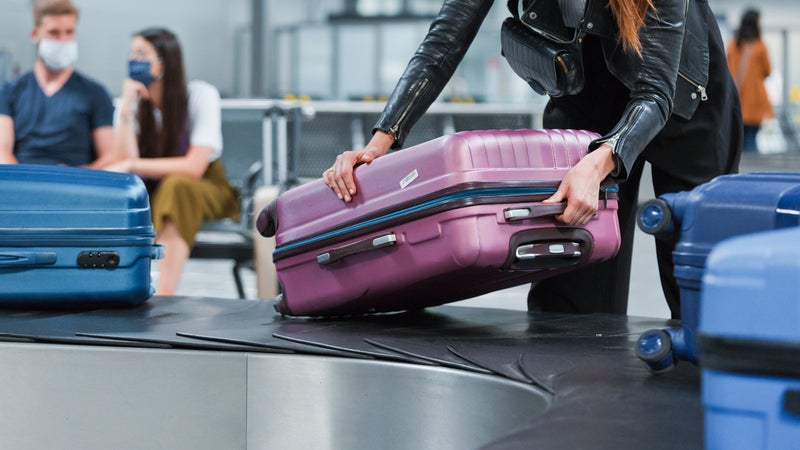
Annoying travel fees you can avoid with the right card lineup

How to get free breakfast at hotels
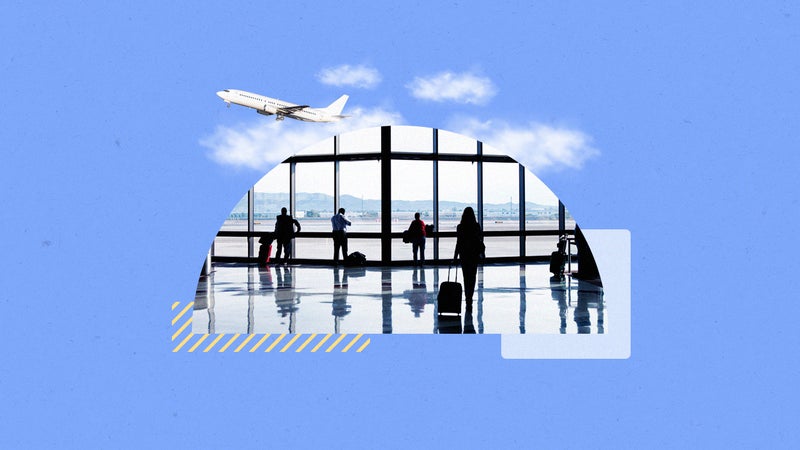
Traveler’s guide to the best frequent flyer programs
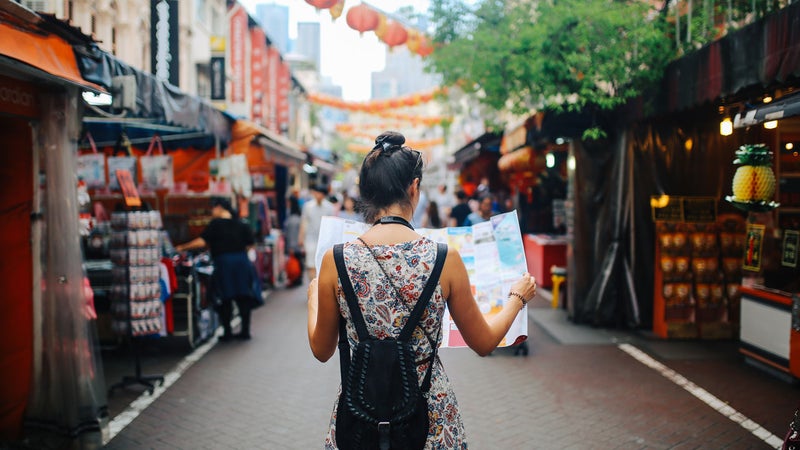
Traveling around the world with credit card points

Bankrate's Travel Toolkit
We've detected unusual activity from your computer network
To continue, please click the box below to let us know you're not a robot.
Why did this happen?
Please make sure your browser supports JavaScript and cookies and that you are not blocking them from loading. For more information you can review our Terms of Service and Cookie Policy .
For inquiries related to this message please contact our support team and provide the reference ID below.
Advertiser Disclosure
Many of the credit card offers that appear on this site are from credit card companies from which we receive financial compensation. This compensation may impact how and where products appear on this site (including, for example, the order in which they appear). However, the credit card information that we publish has been written and evaluated by experts who know these products inside out. We only recommend products we either use ourselves or endorse. This site does not include all credit card companies or all available credit card offers that are on the market. See our advertising policy here where we list advertisers that we work with, and how we make money. You can also review our credit card rating methodology .
46 Amazing Airplane Hacks To Boost Your Flight & Travel Experience
Katie Seemann
Senior Content Contributor and News Editor
343 Published Articles 50 Edited Articles
Countries Visited: 28 U.S. States Visited: 29
Keri Stooksbury
Editor-in-Chief
33 Published Articles 3142 Edited Articles
Countries Visited: 47 U.S. States Visited: 28

1. Be Flexible To Save Money
2. stay alert, 3. use points to book your flight, 4. get help finding award availability, 5. don’t leave miles on the table, 6. choose your seat wisely, 7. book a flexible ticket, 8. keep your suitcase organized, 9. bring the ultimate travel accessory, 10. pack vacation essentials in your carry-on, 11. don’t dry out, 12. pay attention to your toiletries, 13. know where you’re going, 14. stay entertained, 15. charge up, 16. be ready to write, 17. think about meals ahead of time, 18. book a bassinet seat, 19. pack snacks, 20. bring lollipops to help pop ears, 21. keep them entertained, 22. use up energy before the flight, 23. remember where you park, 24. skip the long tsa security line, 25. a “touchless” and even faster way to skip long security lines, 26. go left, 27. be ready for the security line, 28. don’t pay for checked luggage, 29. don’t buy water, 30. stay active, 31. get the right size carry-on bag, 32. know how to access a lounge, 33. know your luggage, 34. put your bag in the right spot, 35. block everything out, 36. brush your teeth, 37. be nice, 38. clean your tray table, 39. choose your drink wisely, 40. sleep like a pro, 41. dress in layers, 42. bring socks, 43. find your luggage quickly, 44. late bags earn points, 45. speed through customs, 46. save money on transportation, final thoughts.
We may be compensated when you click on product links, such as credit cards, from one or more of our advertising partners. Terms apply to the offers below. See our Advertising Policy for more about our partners, how we make money, and our rating methodology. Opinions and recommendations are ours alone.
Love it or hate it, flying on an airplane is a common part of travel. So, if you have to fly, you might as well make the experience as enjoyable as possible.
We’ve compiled this list of 46 of our best airplane and travel hacks to elevate your flight experience, including everything from flight booking hacks and packing hacks to airport hacks and inflight hacks.
We hope you’ll be able to use some of these flight tricks to make your next travel experience as awesome as possible.
Flight Booking Hacks
A great flight starts with a great booking experience. Try these tricks the next time you have to book a flight.
If you want to find cheap flights , it’s best to be flexible. When your dates aren’t set in stone, you can use the flexible date search option in Google Flights to see what dates offer the cheapest tickets. Just visit Google Flights , enter your origin and destination cities, then click on the travel dates.

You’ll see the prices for your flight every day on the calendar. Use the trip duration settings at the bottom to choose your desired trip length or play around to see if the trip length affects the ticket price. The lowest-priced tickets will be shown in green.
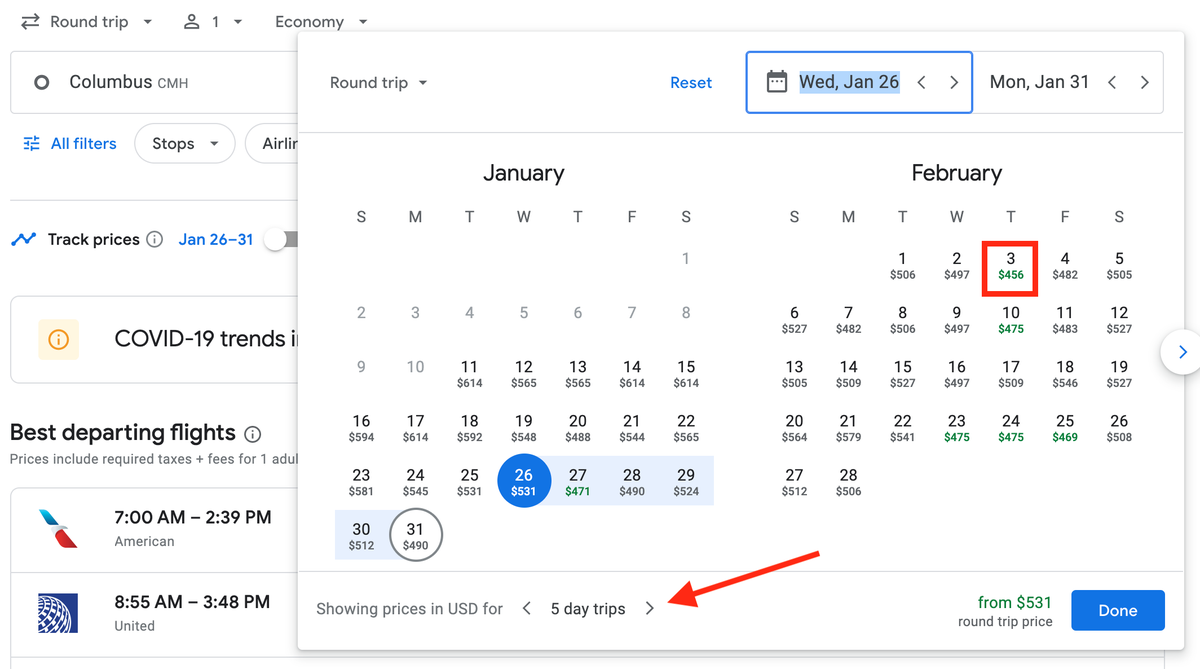
Another way to keep an eye out for the lowest price tickets is by signing up for flight deal alerts . Websites like Google Flights, Kayak , and Skyscanner allow you to sign up for fare alerts on your chosen route so you know if and when the price drops.
We couldn’t write a flight hack post without mentioning points and miles, could we? Of course not, since that’s our specialty! Using points to book your flight is an easy way to save on the out-of-pocket expense of travel. Plus, using points to book business and first class flights is a great way to make your entire flight experience so much more comfortable than flying in the back of the plane.
Hot Tip: If you’re brand new to the points and miles game, start with our beginner’s guide to bring you up to speed.
Using miles to book a flight is a great way to fly, but finding award availability can sometimes prove to be difficult. If you need help, look at a tool like ExpertFlyer , Award Nexus , or Seat Spy . These websites can help you find award seat availability without spending all day searching.
Whether or not this is your first trip on a specific airline or your fiftieth, sign up for the airline’s frequent flyer program and make sure your frequent flyer number is attached to your reservation. If you never plan on flying the airline again, you can credit the miles you’ll earn to a partner airline.
No one wants to get stuck in a middle seat in the back of the plane next to the bathroom, right? That one is obvious, but there are pros and cons to other seats as well.
- If you get motion sickness, choose a seat over the wing so you’ll feel less turbulence .
- Choose a seat in front of the plane if you’ve got a short connecting time.
- If you’re traveling with another person, choose a window and aisle seat toward the back of the plane. Unless the flight is sold out, you’ll have a decent chance that no one will choose the middle seat between you.
- If you want to sleep during your flight, go with a window seat.
- If you’re more comfortable having easy access to the bathroom, an aisle seat toward the back of the plane will be your best bet.
- If you definitely need a small bag with you during the flight, don’t choose a bulkhead seat because they don’t have anywhere to store a carry-on other than the overhead bins.
Use a tool like SeatGuru to find seat maps for your flight, along with notes about the pros and cons of every seat. This website is a must if you want to find the perfect seat on your next flight.
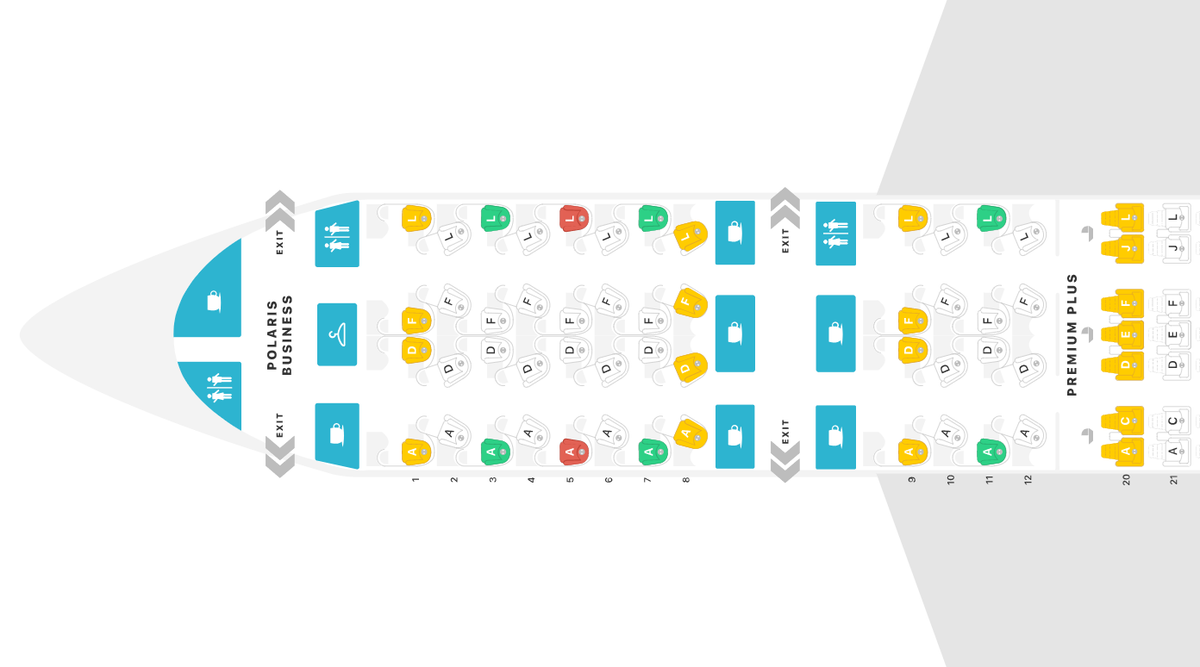
Thankfully, many airlines are offering flexible cancellation and change policies these days, but be sure to read the fine print. These policies often don’t apply to the cheapest basic economy fares. If you want flexibility, you might need to pay a little more upfront.
Packing Hacks
Packing a suitcase is an art, but it doesn’t have to be difficult. These easy packing hacks will help you save space and ensure that you’re prepared for anything.
A packing tip that many can agree on is that packing cubes are a must. These zippered bags come in lots of different sizes and colors to keep your clothes organized. When you arrive at your destination, just move the packing cubes to the drawers, unzip, and you’ve unpacked in an instant.
If you’re packing for multiple people in 1 bag, assign everyone a different color packing cube to keep everything organized.
A large scarf is a versatile item that is the perfect travel accessory. When you pack one in your carry-on bag, you can use it as a blanket to stay warm or for lumbar support to stay comfortable on the plane. Then use it as a scarf in cold weather destinations or as a beach cover-up for tropical vacations.
Picture this: your flight arrives at your vacation destination and you’re so excited to hit the pool at your resort — but your luggage didn’t make it yet! What could be a wasted vacation day for others is no big deal for you because you’re prepared. You packed an extra set of clothes in your carry-on , including important vacation items like a bathing suit, sunscreen, and flip-flops, so you can wait for your delayed luggage while sipping a tropical cocktail by the pool instead of being grumpy in your hotel room in the jeans and sneakers you wore on the plane.
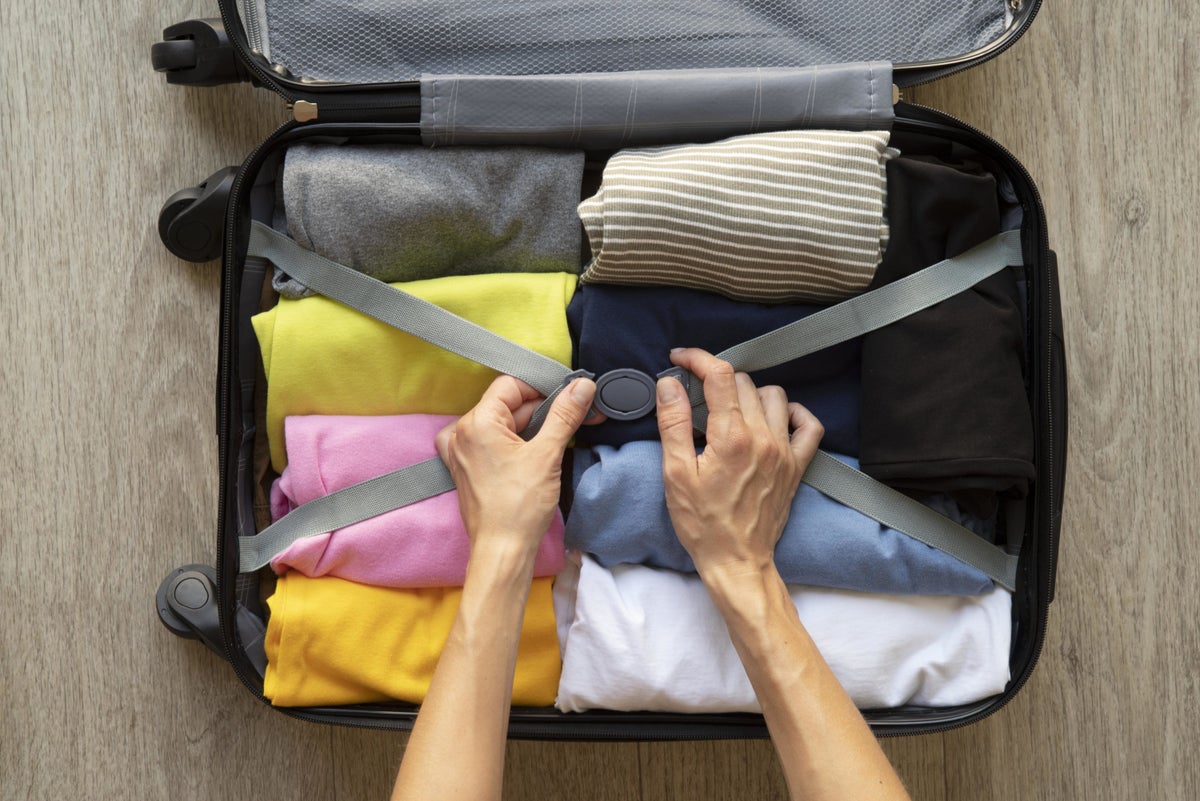
Dry airplane air can easily dehydrate your body. In addition to drinking plenty of water on your flight, don’t forget to pack lip balm and hand lotion in your carry-on bag to combat uncomfortable dry skin. If you typically wear contact lenses, opt for glasses on your flight since the plane’s dry air can make wearing contact lenses uncomfortable.
Make sure your toiletries are in travel-sized containers if you’re planning on using carry-on luggage only. You can invest in a good travel toiletry bag to keep everything organized, or opt for the budget route and put travel-sized containers in a Ziploc bag to keep them from leaking on your clothes.
Pre-flight Hacks
These tricks of the trade are things to think about before you get on your flight.
If you’ll be traveling somewhere where Wi-Fi might be spotty or unavailable, it’s a good idea to download offline maps of the areas you’ll be visiting so you can access them even when you can’t access the internet.
To download a Google Map for use offline, just type in your destination. Then click on the destination name at the bottom of your screen.
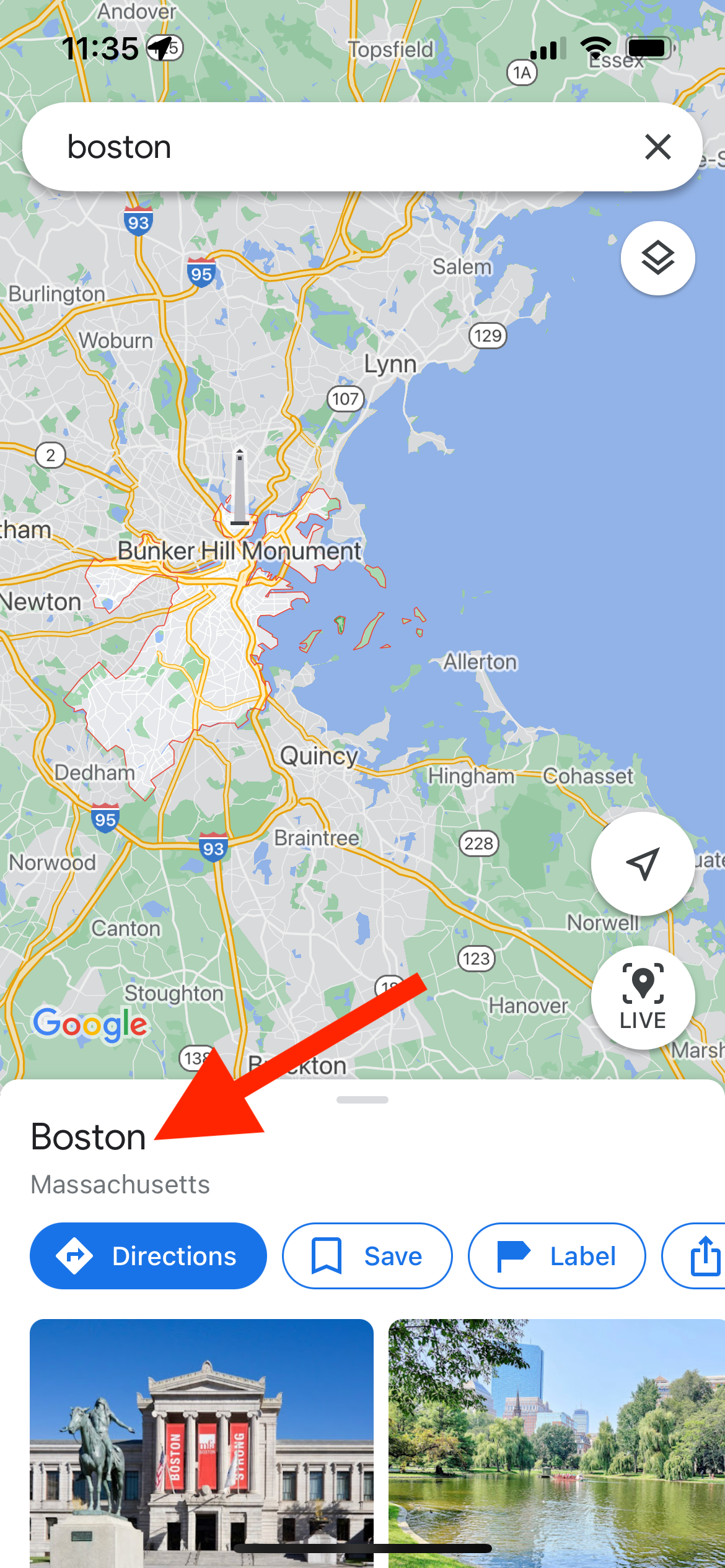
Then click on the 3 dots in the upper right-hand corner and select Download offline map .
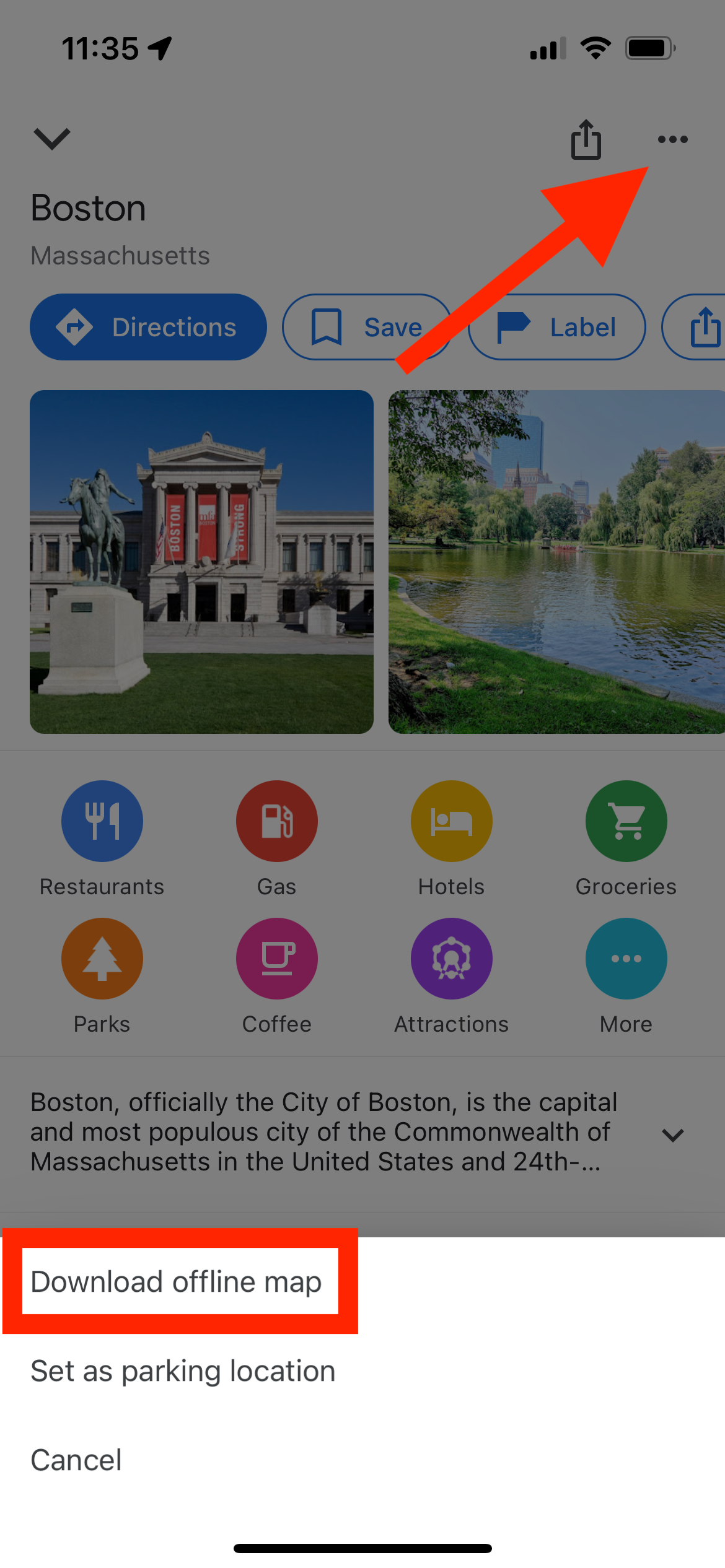
While many airlines offer inflight entertainment, there’s nothing better than knowing you’ve got plenty of your favorites ready to go. Download podcasts, music, audiobooks, or Netflix shows before you take off to ensure you have plenty to keep you occupied during your flight.
If you’re planning on watching movies or shows on your phone, bring a small stand or mount to set up on your tray table so you don’t have to hold your phone for the whole flight.
Be prepared. Charge all of your electronic devices the day before you leave so they are ready to go for your flight. Keep all of your charging cords handy in your carry-on bag in case you need to charge up at the airport, or bring a portable charger if you think you’ll need more battery power during your flight.
If you’ll be traveling internationally, bring a pen . This will save you from having to rely on your fellow passengers to borrow a pen on the flight to fill out customs forms.
If you’re on a long-haul flight that will be serving a meal and you’ve got dietary restrictions, be sure to order a special meal before your flight. If you wait until you’re on the plane, you’ll be stuck with the standard options.
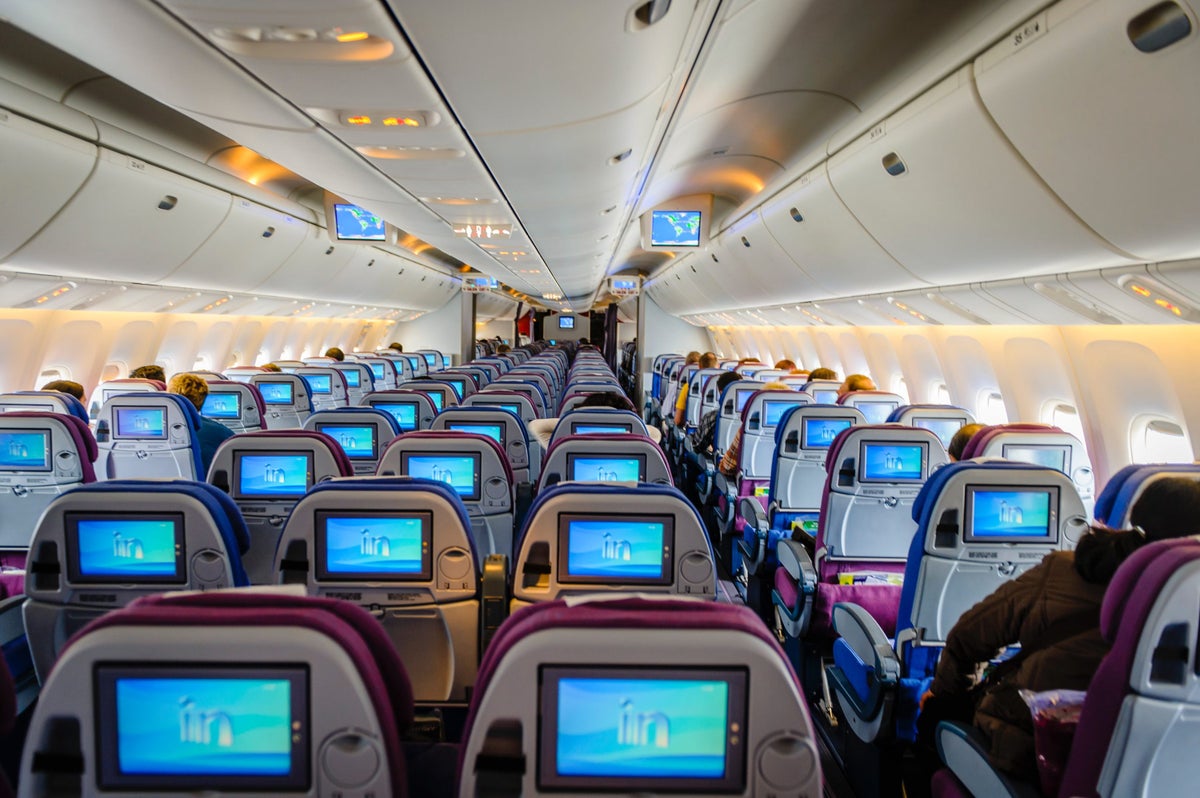
Flying With Kids Hacks
Flying with kids can be an adventure, but with these pro tips, it will be as stress-free as possible.
Did you know that many airplanes (especially on long-haul international flights) have a few seats that can accommodate a bassinet on board (usually the bulkhead seats)? If you’re flying with a baby , book early and call the airline to reserve one of these seats.
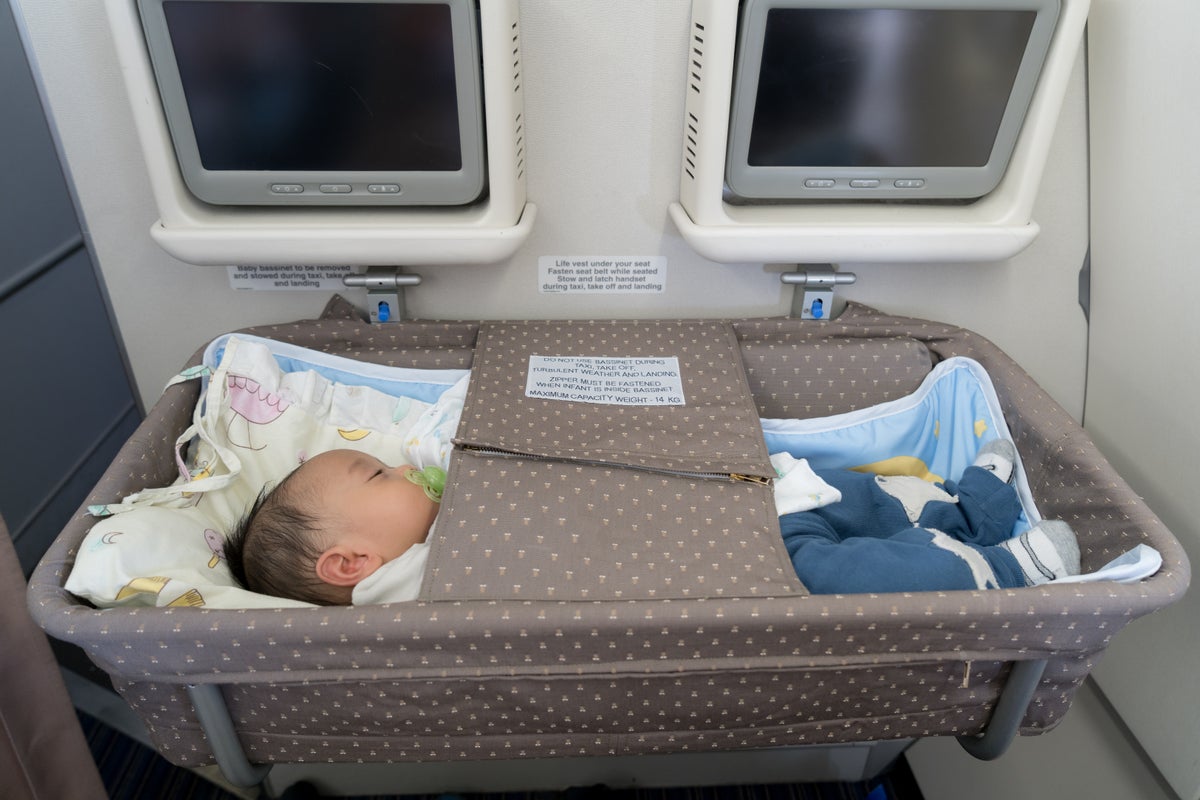
If you’re a parent, you know that snacks are the answer to about 85% of your kids’ problems. This is no different on a flight. Pack snacks and everything will be okay.
Air pressure changes can affect kids’ ears more than adults’ ears. To help your little one pop their ears, give them a lollipop.
We aren’t saying you should always bribe your kids with new toys, but a long flight is a great time to go ahead and bribe your kids with a new toy ! Having something new will help keep them happy and entertained for longer.
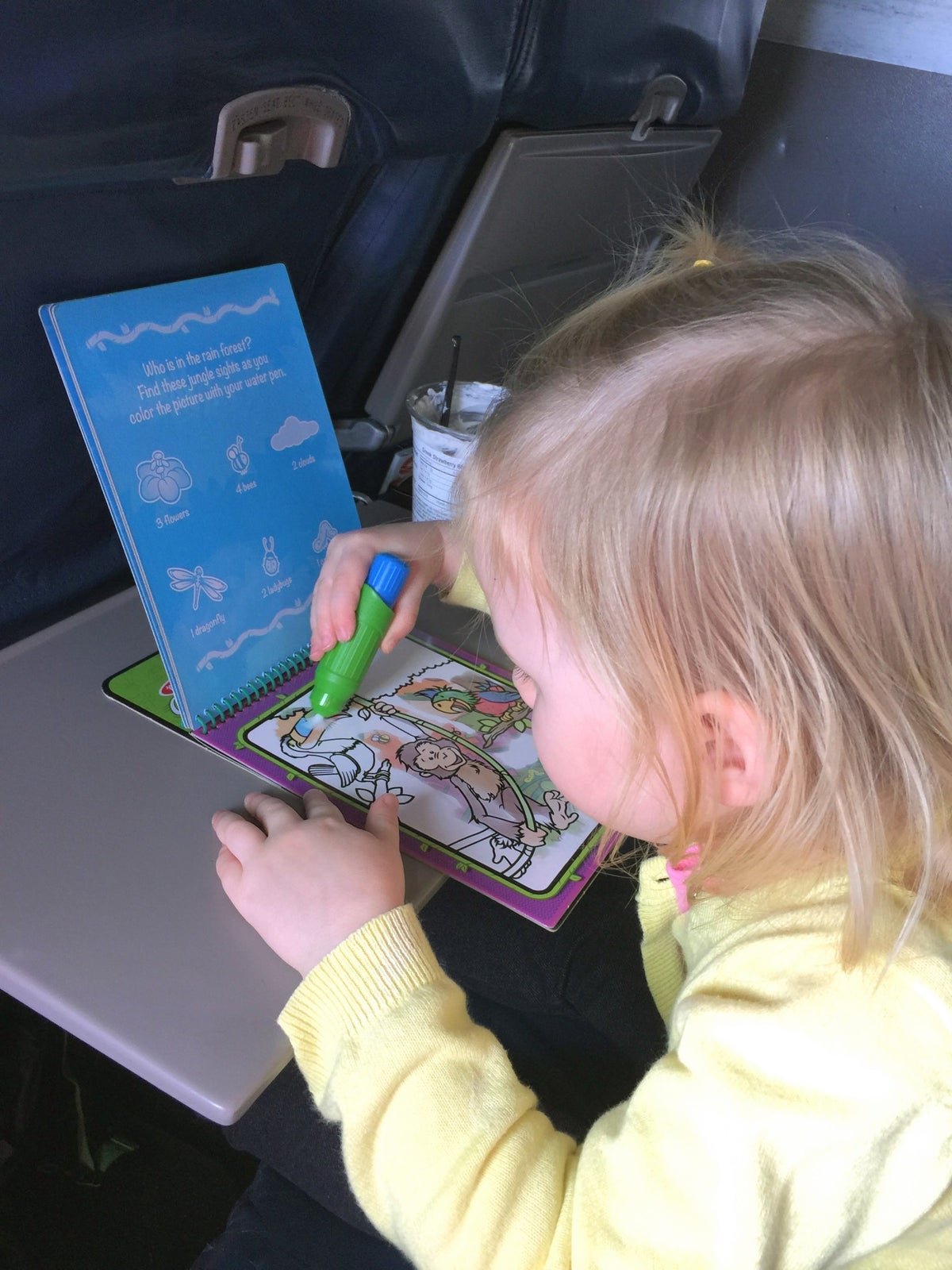
If your child is sitting in the window seat, give them a package of gel window clings to play with, or try an airplane toy for a child’s first flight. The toy itself doesn’t matter as much as the novelty of having a new toy.
If all else fails, or even if you just want to keep things simple, bring a tablet with plenty of shows or games downloaded, along with child-friendly headphones . Most adults use screens for the whole flight, so why not let your kids do the same?
Kids have a ton of energy, and it’s a great idea to get rid of as much of it as possible before you board the plane. Many airports these days have specially designed kids’ play areas for this exact purpose.

If your airport doesn’t have a play area, take kids on a walk and let them ride the people movers (making sure they don’t get in the way of others trying to quickly make it to their gate, of course). When all else fails, try to find an empty area (the far end of the terminal is probably your best bet) and let them run wild.
Pre-flight Airport Hacks
You can make the time you spend in the airport before your flight as comfortable and stress-free as possible with these airport hacks.
While you think you’ll remember where you parked, it’s not quite so easy to remember after a week-long vacation. To help your memory out, take a picture of your parking space with any recognizable features and the parking row number so you can find your car easily when you return.
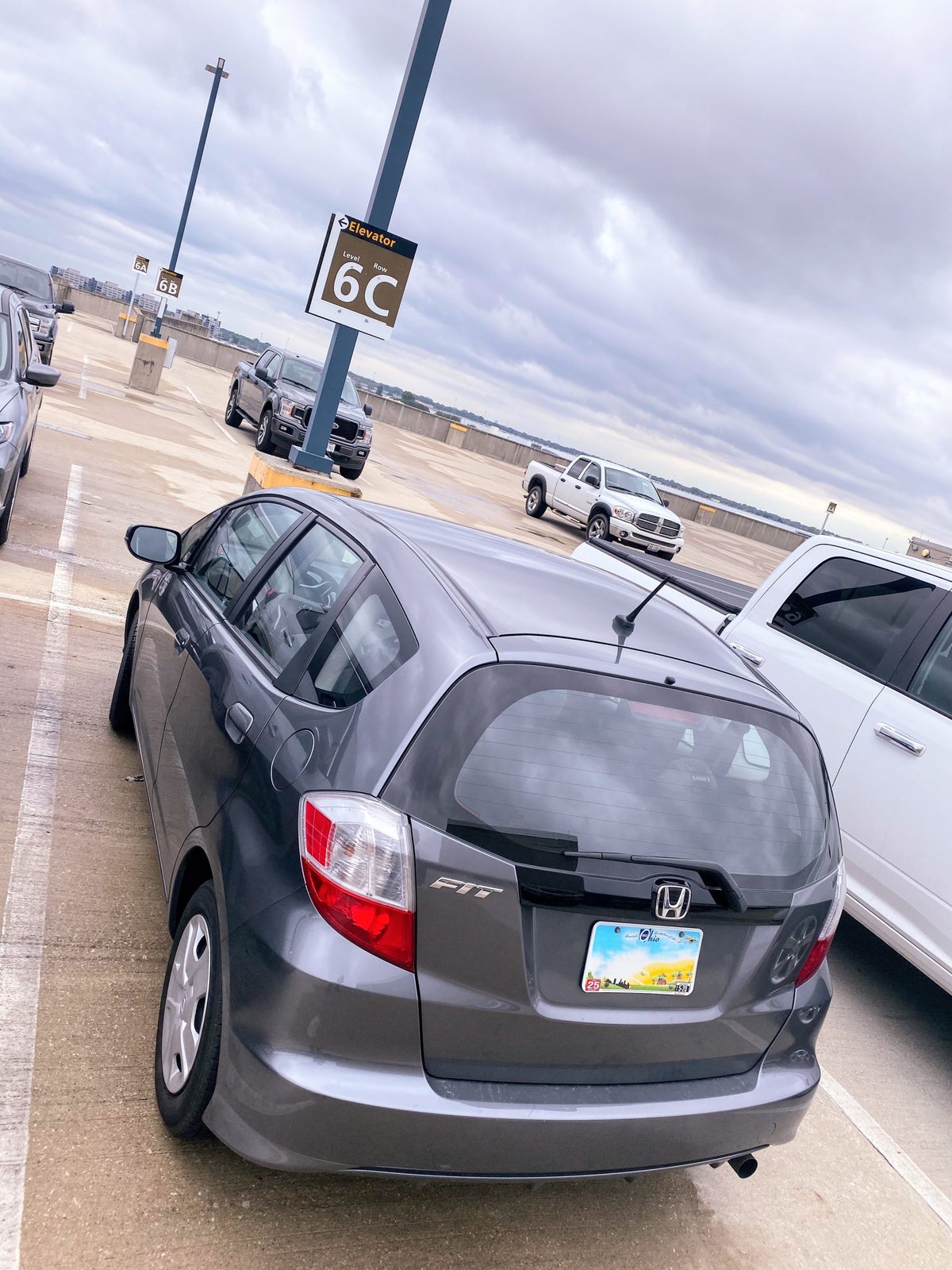
How would you like to breeze through the TSA security line — without taking your shoes off ? That can all be achieved when you have TSA PreCheck . This program essentially gives you access to shorter security lines and the ability to pass through without taking your shoes and jacket off and without having to remove your laptop and toiletries from your bag. It’ll save time and hassle each time you fly.
According to the TSA , the majority of TSA PreCheck passengers wait less than 5 minutes in security lines.
Hot Tip: While TSA PreCheck costs $78 for a 5-year membership (and many would argue it’s absolutely worth that price), you can get it for free with many credit cards .
Breeze through the security lines without having to even take your ID out of your wallet. CLEAR is a program that allows you to do just that because it uses biometrics to verify your identity. After your identity is successfully confirmed (through an eye scan), you’ll be escorted to the front of the security line.
CLEAR costs $189 annually and is available in select airports across the country. Several credit cards include a discounted or complimentary CLEAR membership as part of their benefits.
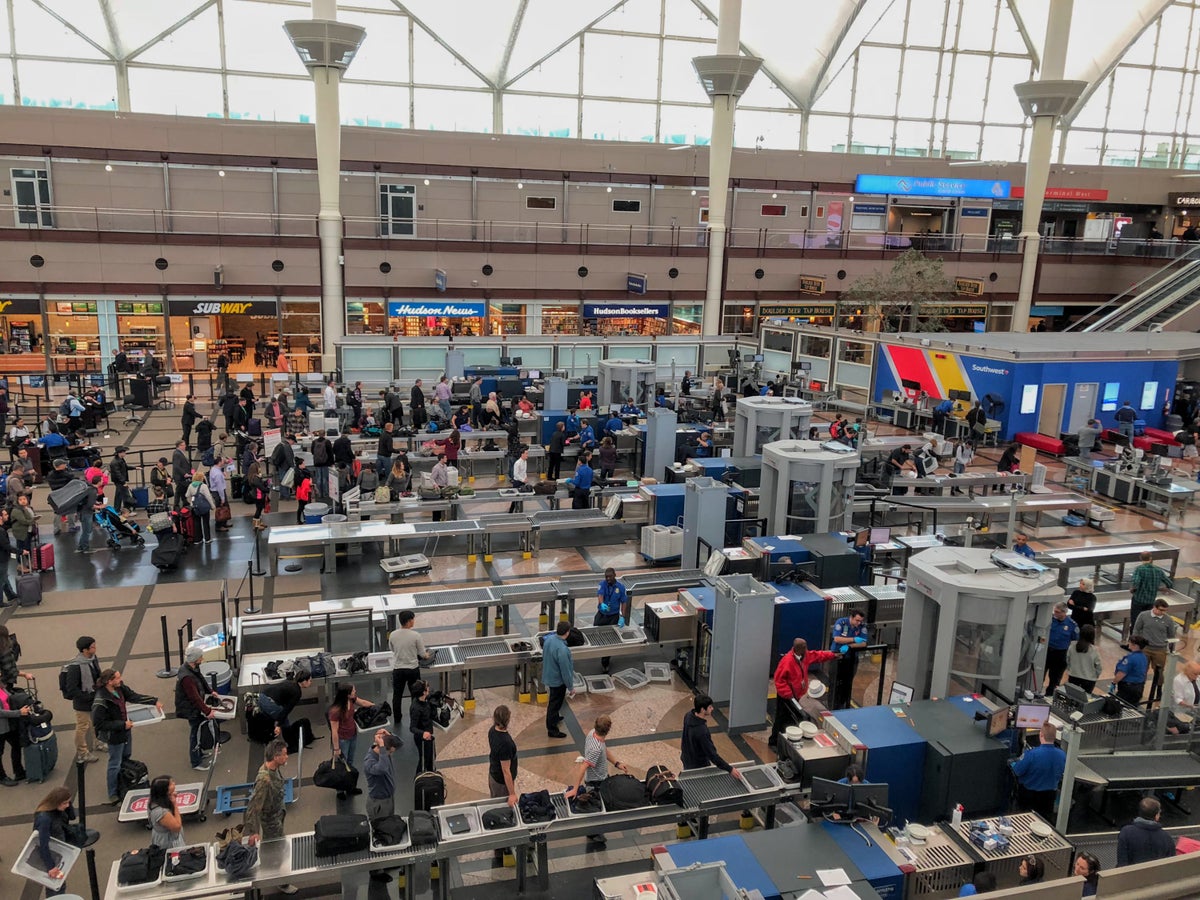
If you have a choice, choose the security lines to the left — people tend to naturally go right more often than not, so the left lines may be shorter.
Regardless of whether or not you have TSA PreCheck, be ready to get through the security line quickly . Have your ID and boarding pass ready to go — do not wait until you’re at the front of the line to get these things out. If you don’t have TSA PreCheck, make sure you have your liquids and laptop easily accessible so you can remove them quickly without holding up the line.
Hot Tip: Be prepared before your flight. Know what you can and can’t bring through TSA security and check these TSA security FAQs for the answers to some common questions.
Checking your luggage can be expensive these days. While it might be easy to just bring a carry-on bag for some trips, many of us will still need to check a bag from time to time. You can avoid paying crazy baggage fees by choosing an airline that doesn’t charge for bags, like Southwest, by having airline elite status, or by having an airline credit card. Many airline credit cards come with free checked baggage , which can save you lots of money, even if you only fly a couple of times a year.
Buying water in an airport gift shop is expensive and isn’t great for the environment. Instead, bring an empty water bottle through security and then fill it at the filling station or drinking fountain after security. You’ll save money and reduce your plastic usage at the same time.
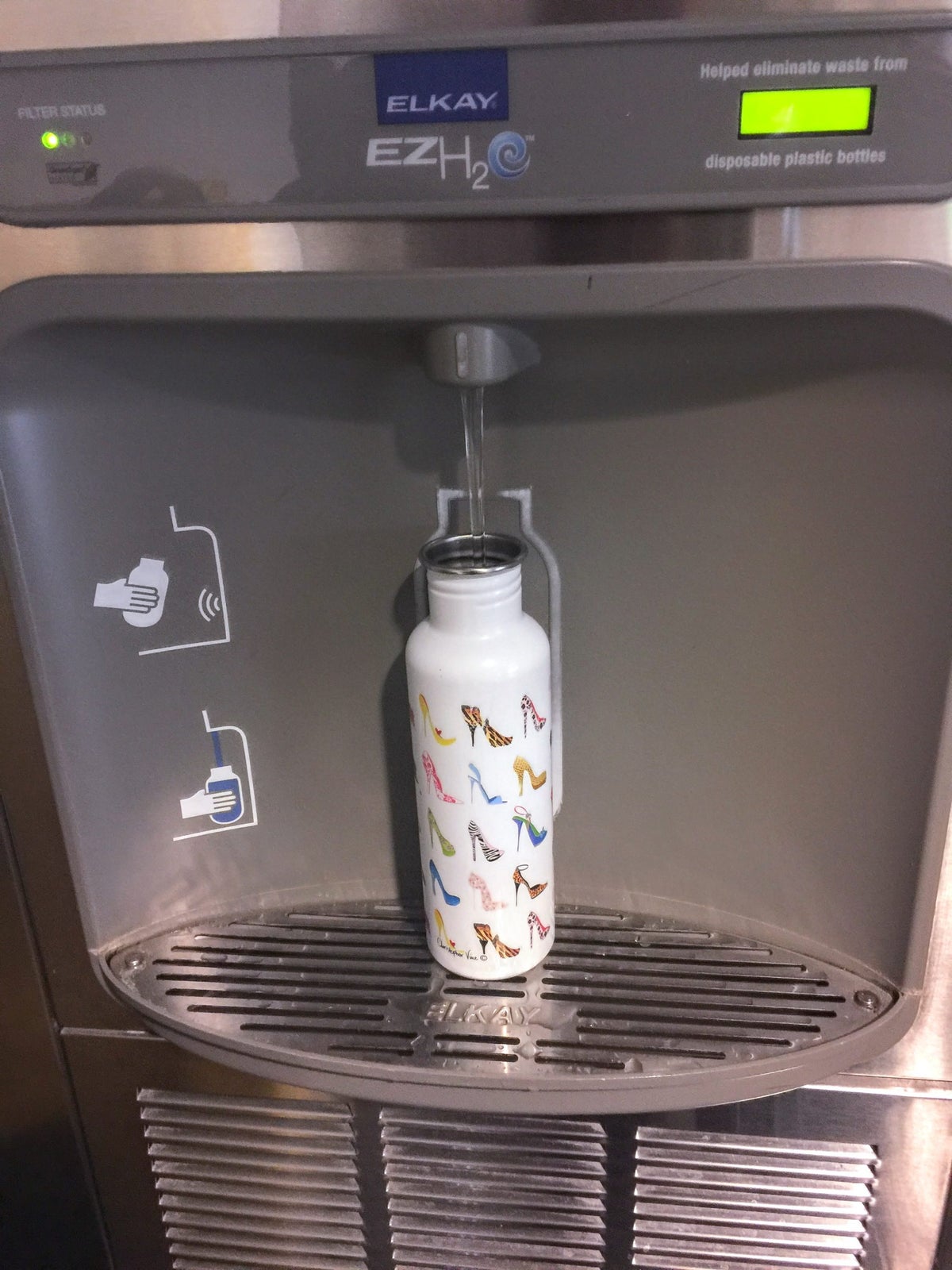
With many of us using fitness trackers and smartwatches these days, getting a recommended number of daily steps or movement time has become commonplace. To balance out sitting on an airplane for hours at a time, take the time before your flight to walk. Getting a few laps in around the terminal before you board your flight is a great way to stay active, even on travel days, and it provides great people-watching, too.
Before you attempt to pack for a week-long trip in 1 carry-on bag, make sure it’s the right size for a carry-on , and make sure you can lift it up to get it in the overhead bin. While other passengers will often offer to help lift heavy bags into the overhead bins, savvy travelers can manage their bags on their own.

Hot Tip: Need a new bag? Check out some of our favorite carry-on luggage bags for any traveler.
Airports are places we all spend a lot of time just waiting. So, next time you fly, plan to wait in style in an airport lounge . Lounges offer quieter places to get work done or to grab a snack and drink before your flight. Some even offer luxury amenities like showers and massages.
Having a Priority Pass membership allows you to access over 1,400 airport lounge locations in over 600 cities across the world. The best part is that there are many credit cards with Priority Pass access.
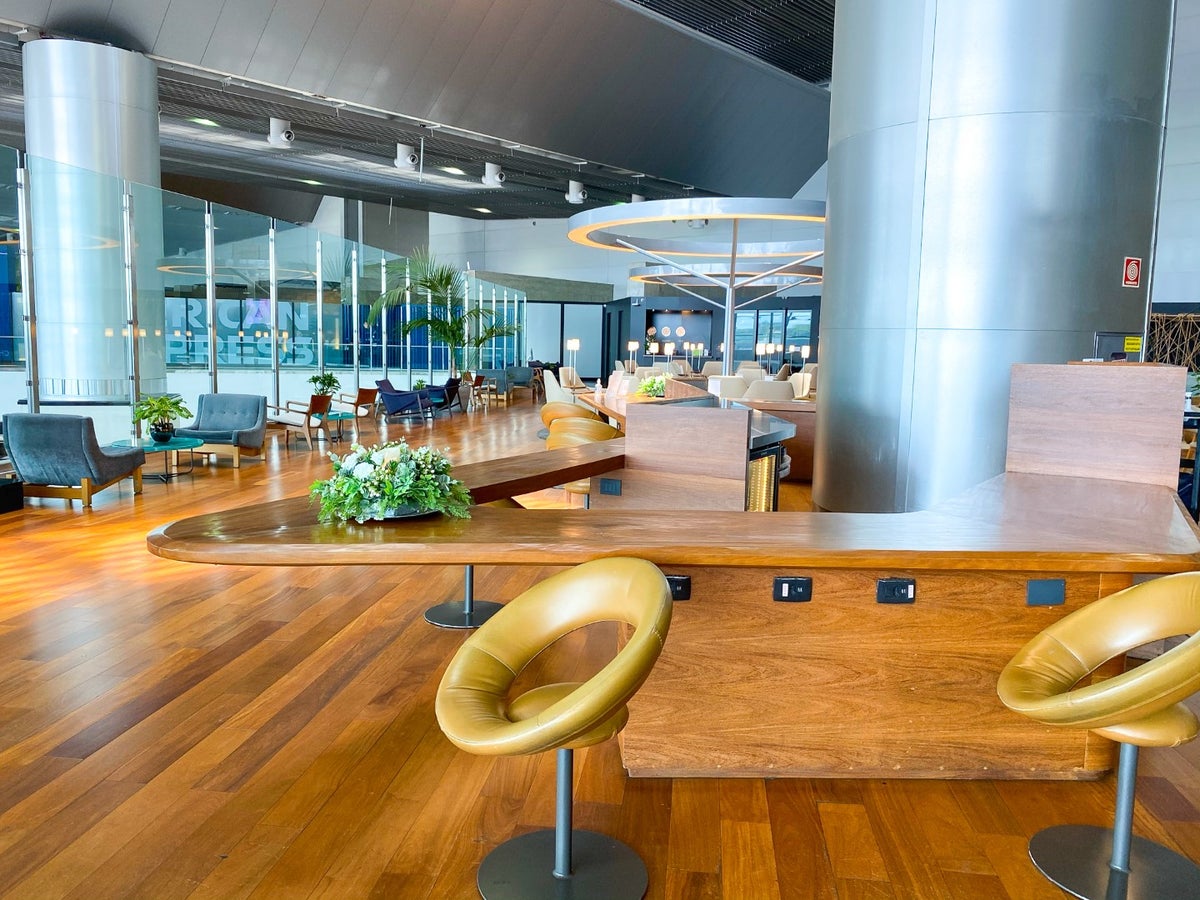
While it’s not inevitable, sometimes your luggage doesn’t make it onto the same flight as you. When this happens, you’ll most likely need to fill out lost/delayed luggage paperwork that will include an area for you to describe your luggage. A description of “black suitcase” isn’t going to cut it, so make sure you know exactly what your luggage looks like. When in doubt, take a photo of it before you fly, for reference.
Airplane Hacks
We love traveling here at Upgraded Points and have picked up lots of tricks along the way. These airplane hacks will help make your flight as comfortable and as fun as possible.
When choosing a spot for your carry-on bag in the overhead bin, go for the space on the opposite side of your seat, directly across from or slightly in front of your seat (never put your bag behind you). That way you can see your bag from your seat and you’ll easily be able to grab it after the flight without having to wait for the people behind you to deplane before you can grab your bag.
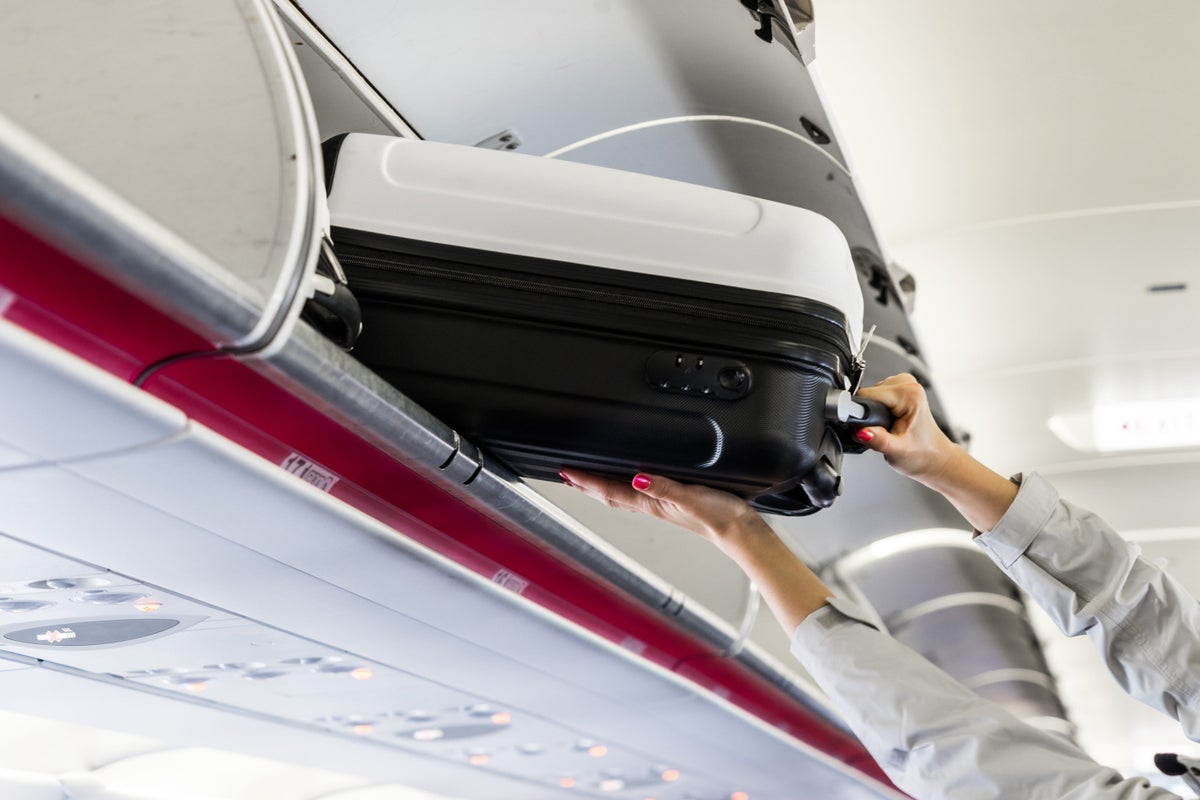
One of the keys to really relaxing and enjoying a flight is the ability to block out airplane noise to enjoy your podcast, music, or movie. Because of that, having noise-canceling headphones is a great way to make your flight more enjoyable.
No, we aren’t suggesting you need to brush your teeth on that quick flight from Chicago to New York City, but brushing your teeth on long-haul flights or flights where you’ll be sleeping can really make a difference in how refreshed you feel. Be sure to pack your toothbrush and travel-sized toothpaste (or even a disposable product like Colgate Wisp ), and don’t forget to use bottled water.
While this should come easily to many people, it bears repeating. Be polite and respectful to the flight attendants. They are there to ensure your safety and to help you have a comfortable flight and they deserve your respect. If you’re having a bad flight or don’t like a policy, don’t take it out on them.
If you think you’ll need extra attention from the flight attendants during your trip, consider bringing a small, edible gift like a piece of chocolate or a cookie (prepackaged, store-bought) as a gesture of thanks.
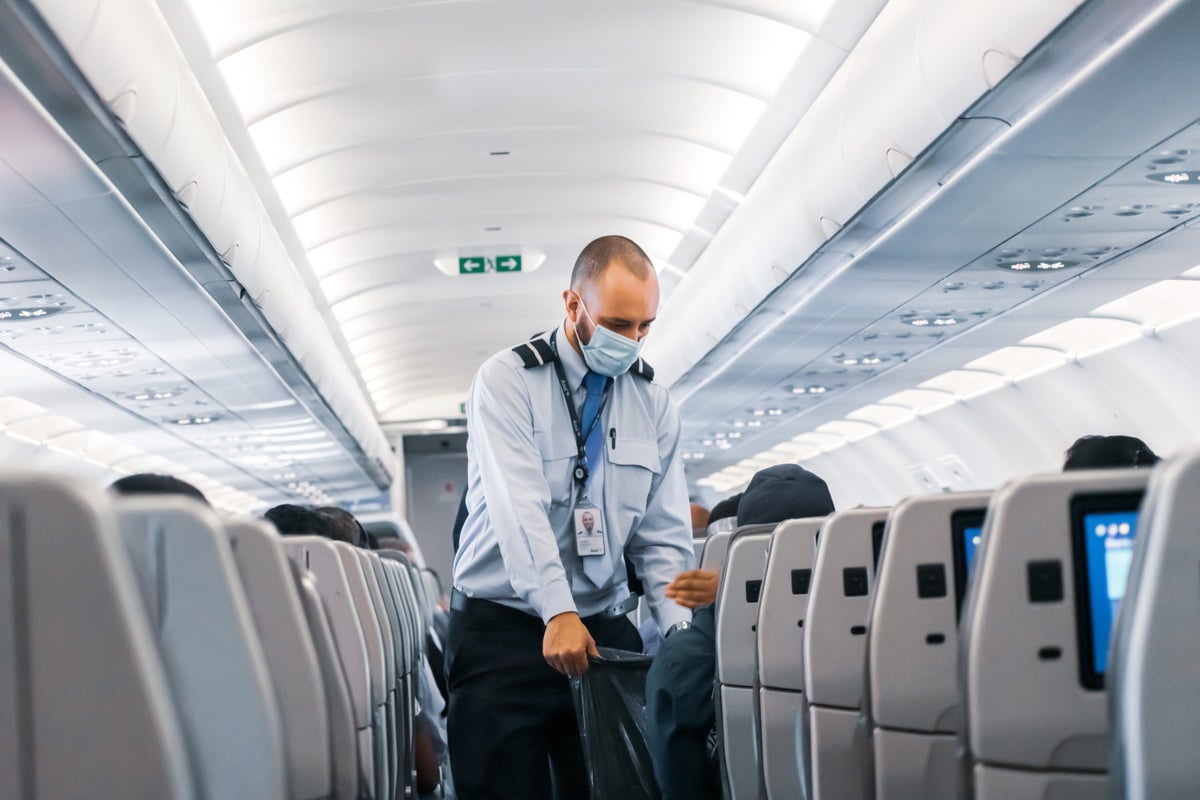
While airplane cleaning standards have increased since the COVID-19 pandemic began, things like tray tables are not necessarily cleaned between each flight. According to Forbes , airplane seatback tray tables are the dirtiest part of the airplane , so be sure to pack some disinfecting wipes and clean your tray table before using it.
Be sure to drink plenty of water during your flight to stay hydrated. While you might not like it, it’s best to avoid alcohol on planes, since it can speed up dehydration and could lead to a fuzzy start to your vacation. It’s also best to avoid carbonated drinks as the bubbles combined with changes in air pressure can cause discomfort for some people.
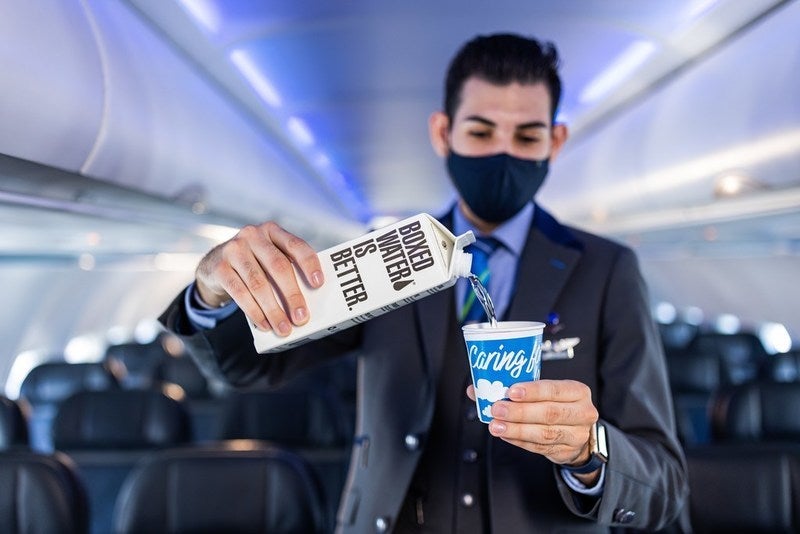
There’s a definite art to sleeping on a plane, and unless you’re one of those lucky people that can fall asleep anywhere, you’ll need all the help you can get. Use a sleeping mask and earplugs to block out light and sound, and bring along a comfortable travel pillow to give your head and neck some support. Choosing a window seat can also make sleeping easier since you can lean up against the side of the plane.
Another trick to help you sleep on airplanes is to wear a jacket or sweatshirt with a hood . Putting up the hood will help keep you warm but will also cover your ears and part of your face, giving you more of a sense of comfort and privacy. Some hoods are big enough to pull down to cover your eyes, too.
Airplanes can often be freezing… unless they are way too hot. The problem is, you never know which temperature extreme your plane might suffer from until you are on it, so it’s best to dress in layers so that you’re prepared for anything. Always bring a jacket in the summer and wear a t-shirt under your sweater in the winter.
Hot Tip: If you bring a jacket but don’t need it on the plane, you can roll it up and use it as extra lumbar support.
If you’re wearing sandals on your travel day, bring a pair of socks to wear on the plane. Your feet will stay warm and your seatmate will appreciate not being up close and personal with your bare feet.
If your feet and legs have a tendency to swell, consider bringing compression socks onboard to wear during your flight. They will help reduce fluid retention and swelling, and may even reduce the risk of deep vein thrombosis (DVT).
Post-flight Airport Hacks
The travel hacks don’t stop when your flight lands. Use these tips to travel like a pro.
Many bags can look the same, so it’s smart to use a unique luggage tag or tie a brightly colored ribbon around your checked bags to make them easily identifiable in the baggage carousel. Alternatively, you can buy luggage in a variety of colors and patterns that are easy to pick out of a crowd.
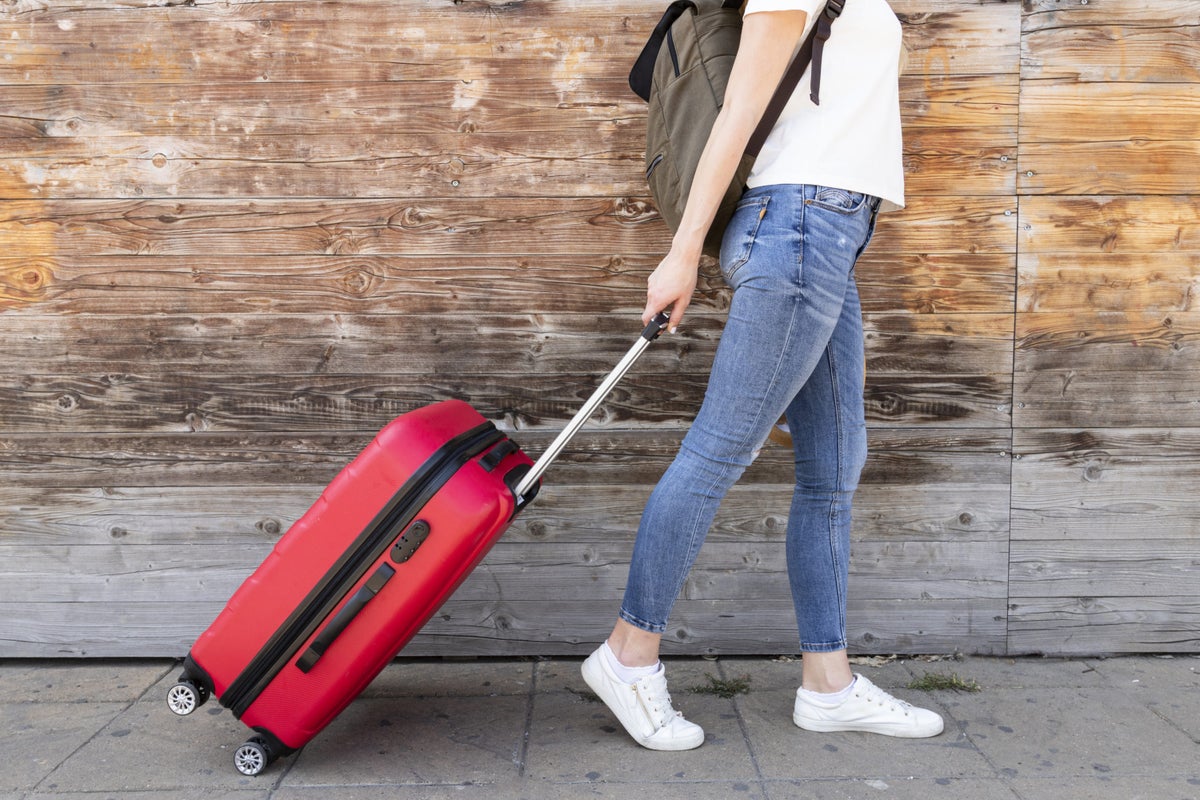
Did you know that some airlines offer bonus points if your bags are late ?
Delta Air Lines offers the “Bags On Time” guarantee. If your bags take more than 20 minutes to reach the baggage carousel after any domestic flight, you’re eligible for 2,500 bonus miles by completing this form .
Alaska Airlines offers a $25 discount code for future travel or 2,500 bonus miles when your bags take more than 20 minutes to reach the baggage carousel. To make a claim , you need to visit the Alaska Airlines baggage desk at the airport within 2 hours of your flight’s arrival.
If you travel internationally even just once or twice a year, Global Entry can save you tons of time. This program allows members to speed through customs upon re-entry back into the U.S. Instead of waiting in the long customs lines, Global Entry members scan their passports and enter customs information at a kiosk before heading to baggage claim.
Bottom Line: Global Entry is a great program that will help you speed through the airport after international flights. It costs $100 to apply and the membership lasts 5 years. The great news is that many travel rewards credit cards come with a credit for the Global Entry application fee .
If you’ll be taking a rideshare service like Uber or Lyft from the airport, make sure you download the app before you need to use it. It will be easier and quicker to get a ride if your account is already set up, and you’ll have time to see if any of your credit cards offer discounts or bonus points . Be sure to add your credit card to your account and activate any bonus offers, if needed.
We think flying is fun and we hope that by using some of these amazing plane and flight hacks, you will, too! Also, be sure to check out our best hotel hacks to get the most out of your next hotel stay. If you’ve got additional travel hacks ideas, share them in the comments below.
Frequently Asked Questions
What are the best airplane hacks for sleeping.
If you want to sleep on your next flight, here are a few hacks that can help you out:
- Book a window seat so you can lean on the side of the plane
- Pack a neck pillow
- Bring earplugs and a sleeping mask to block out light and sound
- To stay warm, bring a jacket or large scarf that can be used as a blanket; wearing a hooded sweatshirt or jacket can also help cover your ears and eyes and keep you warm so you can catch some shut-eye
What are the best airplane hacks for toddlers?
If you’re traveling with a toddler, be sure to bring plenty of snacks and things to keep them entertained. A new toy is a great way to keep them occupied as are gel window clings if they’re sitting in the window seat. If all else fails, bring a tablet and kid-friendly headphones to keep them entertained and quiet for the trip.

What are the best airplane hacks for comfort?
There are a few things you can do to make your next airplane flight more comfortable. Wear comfortable clothes in layers so you can adjust based on the temperature of the plane. To help ease back pain, you can use a rolled-up jacket or scarf for extra lumbar support. If you’re wearing sandals, bring socks to keep your feet warm, and consider compression socks for long flights to help reduce swelling.
What are the best airplane hacks for long flights?
To make a long flight more comfortable, try these hacks on your next trip:
- Wear comfortable clothes that you can sleep in
- Dress in layers so you never get too cold or too hot
- Wear compression socks to help reduce swelling
- Brush your teeth before you go to sleep and once you wake up (but be sure to use bottled water)
- Download plenty of entertainment before the flight and bring a portable charger so your devices don’t run out of batteries
- Use airline miles to book a business or first class flight
What are the best packing hacks for flying?
To pack like a pro, you’ll want to follow these simple tips. Keep your luggage organized by using packing cubes. If you’re packing more than 1 person in a single suitcase, get a different color of packing cube for each person to keep everything separated. Use a toiletry bag or a simple Ziploc bag to pack your bathroom essentials. If your products leak, the spill will be confined to the small bag and won’t get all over your clothes. If you’re checking suitcases for vacation, always pack what you’ll need for the first day in your carry-on so you can start your vacation right away, even if your bags are late.
Was this page helpful?
About Katie Seemann
Katie has been in the points and miles game since 2015 and started her own blog in 2016. She’s been freelance writing since then and her work has been featured in publications like Travel + Leisure, Forbes Advisor, and Fortune Recommends.
INSIDERS ONLY: UP PULSE ™

Get the latest travel tips, crucial news, flight & hotel deal alerts...
Plus — expert strategies to maximize your points & miles by joining our (free) newsletter.
We respect your privacy . This site is protected by reCAPTCHA. Google's privacy policy and terms of service apply.
Related Posts
![travel hacks with points The 8+ Best Credit Cards for Travel Accident Insurance [2023]](https://upgradedpoints.com/wp-content/uploads/2018/11/Airport-Boarding-Line.jpg?auto=webp&disable=upscale&width=1200)
UP's Bonus Valuation
This bonus value is an estimated valuation calculated by UP after analyzing redemption options, transfer partners, award availability and how much UP would pay to buy these points.
- Share full article

Travel 101: Our Favorite Hacks, Hints and How-Tos
Successful trips take thorough preparation, from picking the right destination to nailing down all the details. We’ve done the homework so you don’t have to.
Credit... Dani Pendergast
Traveling is exciting, fulfilling and even life-changing. Planning to travel can be stressful, confusing and overwhelming. What should you pack? How can you arrange that big trip with friends and not end up enemies? How do you get to your destination when cancellations and delays conspire against you?
This new series, Travel 101, is designed to help. We’ve talked to the experts, read the fine print and dived deep into the details to offer actionable, practical solutions that will help you maximize the joy and minimize the headaches. We’ll be adding to this guide regularly to create a compendium of advice you can turn to at each step along the way. Bon voyage!
Tips for Parents on Kids Flying Unaccompanied

For many parents and guardians, putting a child on a flight alone may seem terrifying. Belligerent passengers, delays, turbulence: All loom large in a caregiver’s imagination.
Life sometimes leaves no other option. Hudson Crites , 17, of Marshall, Va., was 10 when he started flying unaccompanied to visit his father in Kansas and later Georgia, said his mother, Chelsea Tippett. But the extra attention from airline staff made Hudson “feel special,” Ms. Tippett recalls. Other than a single tarmac delay, he has had no problems.
On rare occasions, children have had troubling experiences. In December, Spirit Airlines accidentally flew a 6-year-old to Orlando, Fla., instead of the intended destination of Fort Myers. Spirit apologized, fired the gate agent responsible and offered reimbursement to the boy’s grandmother for her travel to Orlando. But while the boy was unharmed, his grandmother expressed worry that he had been kidnapped .
If you decide to fly your child unaccompanied, you’ll discover that each airline has its own procedures, fees and routes open to children. While some may find the process complicated, flying alone may be exciting for your child, instilling some independence. Here’s what you need to know.
Before you book, know the process
Regardless of the airline or route, flying an unaccompanied minor differs from an adult or a family catching a flight. Airlines require a trusted pre-authorized adult to be at the departure and arrival gates, and will ask you at booking to provide contact information for those adults. They will also need to present identification at the terminals.
The journey begins at the originating airport’s airline ticket counter. There, airline staff will check your identification and check in the child, perhaps handing them a lanyard or wristband to wear. The agents will provide you with a pass to get through security with your child. You will accompany them to the gate, where you will hand them off to a gate agent. You must stay at the gate until the plane takes off.
In the air, the flight crew will keep watch — but will not babysit, or sit with, your child. If the flight has a connection, a crew member will walk your child off the plane and a gate agent will take him or her to the next gate.
At the arrival airport, the child will be handed off by staff to the authorized guardian or parent who should have already checked in at the ticket counter with proper identification, gone through security with their gate pass and be waiting at the gate.
To learn more about this process, read the Department of Transportation’s online guide, “When Kids Fly Alone,” followed by the website of your selected carrier.
Choosing an airline and paying an extra fee
Before purchasing a ticket, experts advise you to consider an airline’s on-time performance. “Solid on-time performance is hard-earned, and signals a carrier that has tight control of its operation,” said the Ask the Pilot author, Patrick Smith. The Bureau of Transportation Statistics has those numbers.
Booking procedures vary. Delta Air Lines and American Airlines require you to call. United Airlines allows bookings online. JetBlue Airways does online bookings, too, but asks for three printed copies of its forms upon arrival at the airport.
International flights may call for a notarized consent letter describing where the child is traveling, with whom they’ll stay and how long they’ll be there.
On top of the ticket fare, flying an unaccompanied minor can be pricey.
Southwest Airlines charges $100 one way for each child, regardless of distance. Alaska Airlines charges $50 per child if the flight is nonstop; a connection adds $25. On Delta, one $150 fee will cover up to four children, and American’s $150 covers all siblings, with no cap on number. United charges $150 for one child, or two children flying together.
Restrictions: There are plenty
U.S. carriers allow children to fly as unaccompanied minors once they turn 5 and before they turn 18. But regardless of your child’s age, make sure he or she is ready by discussing the trip details and your expectations of their behavior. No policy can replace your judgment.
The low-cost carriers Frontier Airlines and Allegiant Air don’t allow unaccompanied minors, Other airlines have restrictions that, in the broadest terms, differentiate between young children and teenagers. American and Delta restrict children under 8 from routes requiring connections. Both airlines allow children between 8 and 14 to take some connecting flights.
On American, no unaccompanied minor is allowed to take an overnight flight requiring a connection, or a flight that includes a connection on its final leg that also happens to be the last such flight that day (“unless it’s the only flight,” the company adds). Minors are not allowed on code-share flights.
United and Delta have similar rules. Southwest, JetBlue and Spirit don’t allow unaccompanied minors on connecting flights.
JetBlue prohibits minors from flying to Europe, and limits the number of unaccompanied minors in one party to three. Spirit does not allow children on flights to Central or South America. Southwest doesn’t allow children on any international flights. American, United and Delta let minors fly abroad, but restrictions on connections, code-shares and overnights limit options.
American and Delta allow children to opt out of flying as unaccompanied minors once they turn 15 — that is, the child can fly without the assistance of airline personnel. JetBlue ends unaccompanied minor service at 14, while Alaska has an opt-out option at 13. Southwest boasts the lowest opt-out age: 12.
However, you should be able to accompany your child to the gate even if they’re not flying unaccompanied. American requires that you do so for teens between the ages of 15 and 17, even if they’ve opted out.
What to pack
Have a plan to head off your child’s hunger, boredom and thirst. If they are older, make sure they have emergency money and a charged phone.
When her two daughters, then 9 and 11, flew to Denver, Joey Conover of Charlottesville, Va., had a long list for their carry-ons.
“Pack a backpack with iPad, headphones, lightweight book to read, a pad of paper and colored pencils (markers might smear), a small travel game, water bottle (bring empty and fill in airport), snacks, some kind of surprise fidget or animals to play with, hoodie, and a lovey,” she wrote in an email.
“Write your name and phone number on the inside of their arm in Sharpie and put a parent’s business card in a luggage tag on both suitcase and backpack,” Ms. Conover said. (A sheet of paper with all their identification, and their guardian’s contact information, also works. Simply stick in an easy-to-access pocket.)
Vacation Rentals: How to Shrink Your Carbon Footprint

Travelers choosing to stay in a vacation home instead of a hotel may have to spend more time searching for sustainable lodgings, but ultimately they will have more control over their environmental impact. The following are steps short-term renters can take to shrink their carbon footprint.
Search for sustainable rentals
The company Sustonica validates short-term rentals based on sustainability standards, including conserving water and minimizing waste. But it does not act as a search engine. Instead, travelers will find its logo on certified listings on platforms like Airbnb and Booking.com.
Airbnb’s rental categories can help travelers find off-the-grid options, highlighting more than 9,000 listings that rely on renewable energy sources or have no electricity, and Earth Homes , a set of accommodations built with organic materials such as mud or rammed earth.
Booking.com, which lists vacation homes as well as hotels, allows travelers to search for listings with sustainability certifications from more than 65 organizations doing third-party reviews of practices ranging from renewable energy sourcing to recycling.
The company said that more than 16,500 properties, a combination of hotels and rentals, have separate, third-party sustainability certification.
The vacation home rental platform Vrbo does not have an eco-friendly search filter, citing the lack of industry consensus on what makes a rental more sustainable. Properties listed by its sibling agency Expedia may say they are “eco-certified” and users can search using that filter. But read the results carefully; some listings lack information on their sustainable features.
Wherever you search, scrutinize the listings, said Bob Garner, the founder of EnviroRental , a service that works with short-term rental owners on sustainability practices. Do bathroom photos show shampoo in large, shareable dispensers? Does the description mention recycling? If the host has a separate website, look for press links or blog posts related to sustainability.
Talk to the host
According to Airbnb, more than 80 percent of its hosts say they incorporate at least one sustainable feature, such as composting, minimizing single-use plastics and providing guidance on using public transportation. The platform maintains a guide for hosts on sustainable tourism practices, with tips on things like creating a manual to direct travelers to local shops, restaurants and markets.
“When you think you’ve found the right property, ask some questions,” Mr. Garner said. “If they can’t answer them, then there’s a red flag.”
Just the act of asking about environmentally friendly features can have a lasting effect.
“If they think you care, there’s a greater chance of moving the needle,” said Diane Daniel, the founder of Vacation Donations , a nonprofit that encourages short-term renters to donate leftover food in the Tampa, Fla., area.
Consider a pedestrian- or public-transit-friendly location
Even if you can’t find a solar-powered stay, you can choose a location that allows you to get around with minimal emissions.
Connect your “environmental consciousness with the idea of being a good traveler,” said Beth Santos, the chief executive of Wanderful , a global women’s travel community, and the author of “Wander Woman: How to Reclaim Your Space, Find Your Voice, and Travel the World, Solo.”
She recommends travelers live like locals, including taking public transportation, visiting neighborhoods beyond city centers and patronizing small businesses. Take a “day zero,” or a single unscheduled day to walk the neighborhood to find nearby shops as well as transportation options.
Conserve energy
Conserve energy by turning air conditioning off or down when you’re out, switching off lights when you leave and turning off the tap while you brush your teeth.
“This could be one area where you say, ‘I don’t care, I’m on vacation,’” Ms. Daniel said. But travelers should stay vigilant, she said. “Short-term rentals are the easiest places to regulate your footprint, because it’s really up to you.”
Plan meals, reduce waste
Renters usually have the option of cooking meals. To avoid food waste , plan meals and shop for them as you go — and as plans change — rather than buying everything at once. Bring staples like salt and pepper and ask the host if the kitchen is stocked with other supplies like cooking oil and coffee.
“Buying slowly over the week as you need things is a really nice experience if you’re in a location where they’ve got some nice delicacies and interesting farm shops,” Mr. Garner said.
Ms. Santos of Wanderful recommends packing a collapsible food container. “You can throw it in your luggage, take home leftovers and have a place to reheat them,” she said.
Donate leftover food
Take as much leftover food home as you can and look for food pantries that accept donations for whatever you can’t take.
“Perishables are very challenging unless you’re near a pantry that takes them and is open when you’re checking out,” said Ms. Daniel of Vacation Donations.
Don’t assume the cleaner wants your food. In a pinch, Ms. Daniel recommends knocking on neighbors’ doors if you’re staying in an apartment building, or searching Facebook for local groups seeking food donations.
Consider ‘community offsets’
Carbon offset programs invest in activities like tree farming that reduce carbon in an amount matching the emissions generated by a trip. But it’s a controversial practice that has led to inflated, if not bogus, claims of carbon mitigation.
Instead, consider donating your time to a local cause in the area where you’re renting.
“Community offsets or volunteering work are opportunities to spend two hours one morning of a holiday to help in whichever volunteering work there is in this local area, from picking up trash to feeding homeless people,” said Vanessa de Souza Lage, the co-founder and chief executive of Sustonica.
Advertisement
Travel Advisers: When to Let a Professional Plan Your Trip

Decades ago, your vacation most likely began with a visit to a travel agent, who relied on a combination of expertise and connections to find the best deals on plane tickets, hotels, tours and more. Since then, the internet has turned most of us into our own travel agents, and artificial intelligence software is making research and self-booking even easier. But for some trips, that special insider knowledge can still make a big difference.
So when should you hire a professional, and how does it all work? Here are some tips.
Why should I consider a travel adviser?
It’s easy for a traveler to do the research for a standard trip, said Chris Anderson, a professor at the Cornell University School of Hotel Administration, “so they should look for a specialist for the type of tour they are looking for, say a bike trip in Ireland, who can really add value.”
The insider knowledge offered by a travel adviser can add the most value to trips that have multicity itineraries, involve a wide age range of travelers , are very significant (like an anniversary vacation) or are to destinations you are unfamiliar with, said Gary R. Johnson, who has run the travel agency Woodside Travel in Seattle for nearly 30 years. An adviser could help you decide, for instance, in which order to visit European cities based on local events and transportation options.
What can an adviser give me that a booking site can’t?
Travel advisers can help you research the best destinations, lodging, or activities for your particular group and travel goals, offering up specific advice that might be hard or time-consuming to find yourself. Those specializing in cruises might know which cabin to choose if you are prone to seasickness, while a safari planner could help you decide which park would be best for bird-watching or seeing specific animals, like rhinos.
Travel advisers typically have relationships with tour companies, hotels and cruise lines, sometimes through networks. Those connections can allow advisers to offer extra perks such as late checkout, free breakfast, airport transfers, a welcome basket or a credit to spend on a cruise ship.
“A good travel agent will be a better steward of your travel budget than you are,” said Guy Rubin, managing director of Imperial Tours , which arranges travel in China.
When bad weather or other circumstances disrupt your itinerary, travel advisers often have direct lines of communication with providers and can do the work of rebooking and changing plans, saving you time and stress.
OK, let’s say I need help. How do I find an adviser?
Networks like the American Society of Travel Advisors and Travel Leaders have websites that can help you start your search for a travel adviser by answering a few questions about your desired trip. Once you have a handful to choose from, get on the phone with them to talk about what they might do for you, how they charge and the level of service you can expect. Special trips can cost thousands of dollars, so it’s worth investing time up front, Mr. Rubin said.
Make sure to read over the travel agent’s reviews and any user-generated social content that mentions them, Dr. Anderson said. “If there is no external validation, that’s a red flag.”
How do advisers get paid, and how much will it cost me?
Advisers receive commission from suppliers, typically 10 to 15 percent of the price, when selling cruises, lodging and tours. They also sometimes charge travelers a planning fee, from a few hundred dollars, which may be credited to the final bill if the booking is completed, all the way up to tens of thousands of dollars annually for a luxury concierge travel planner they can call on all year. Mr. Johnson said that he charges a planning fee the first time he works with customers. If they return for other trips, he waives the fee.
Advisers may be tempted to sell you something that will earn them a higher commission, Dr. Anderson said. But, he points out, the same is true for the large online services, which promote hotels that pay them larger commissions. Travelers can ask advisers about specific commissions they receive or how they are affiliated with the products they are recommending, he said.
Sometimes a local tour company will package transportation, lodging and experiences for an adviser, who tacks on a percentage before passing it along to a client. But a bill that is not itemized can make it harder to make trade-offs — between a more expensive hotel and a special experience, for example. If pricing transparency is important to you, discuss it with the adviser up front.
How are A.I. and other technologies affecting travel advisers?
While new technologies are allowing do-it-yourselfers to create their own itineraries online based on individual preferences, and to type questions directly into travel websites, advisers are also taking advantage of those technologies to improve their services. Joan Roca, chief executive of the upscale travel planning company Essentialist said his team “uses technology to enhance the human touch,” employing artificial intelligence to choose options from a database of travel offerings selected by a human team. If a couple wants to take an after-dinner stroll, for example, Essentialist’s app will offer up ideas of where to go, based on what part of the city the travelers are in and conversations they’ve had with their travel adviser.
Drone Photography: How to Take Better Pictures

Before the advent of drones, people had to rely mostly on airplanes or helicopters to take aerial photographs. Now, thanks to increasing availability and decreasing price points of drones, as well as advances in obstacle avoidance technology, GPS navigation, battery life and camera stabilization, it certainly seems easier to take photographs from higher elevations.
But that doesn’t mean anyone with a drone can make excellent photographs. Here are some practical tips on the logistics of drone usage and suggestions to make better photos while traveling.
First, know the rules
In the United States, the Federal Aviation Administration oversees drone regulations, and FAADroneZone is the country’s official website for understanding drone requirements and managing drone services. If you are a recreational flyer, you must pass an aeronautical knowledge and safety test, called the Recreational UAS Safety Test , before flying your drone.
The drone company DJI also has a detailed website that instructs drone users on local rules and regulations.
The basic rules for flying a drone as a hobbyist — that is, recreationally using a drone — are to fly the unmanned aircraft only at or below 400 feet, always keep the drone in sight, do not fly in restricted airspace and do not fly over groups of people. If you are flying your drone commercially, you must become a certificated remote pilot by passing the F.A.A.’s Part 107 test . This is a more extensive test and covers additional drone rules, airspace regulations and weather conditions.
Be aware that many countries may have different regulations. Anywhere you go, you may be fined or your aircraft may be confiscated if you do not adhere to the rules.
Understand what your drone can do
Drones are incredibly fast, maneuverable and precise. You can fly up to 400 feet and move laterally in an infinite number of directions to get the perfect shot. But first-time drone flyers often fly as high as possible and take pictures that lack a point of focus or a strong composition.
In order to get photos with the most detail, set your drone to the lowest ISO, usually 100. This is the feature that sets the camera’s sensitivity to light and was known as the film speed back in the days of film. To achieve the best quality pictures, it’s best to shoot in RAW format, which is a digital image file that is unprocessed and contains the most amount of data. When processed, this will produce photographs with the most detail.
After you have purchased your drone, it’s good practice to regularly update the firmware, which is software that provides basic instructions for the craft’s hardware to function successfully, like the drone and remote controller working together.
Use maps and the weather forecast, and time it right
Whether you consult an atlas or follow your car or phone’s navigation, maps are very effective tools for seeing the shape of a river, lake or pond and provide ideas for good aerial subjects.
Once you have a location, shoot during the “golden hours” — taking photos around sunrise and sunset will often produce the most dramatic pictures with warm light and shadows. It’s a good idea to keep an eye on the weather forecast to know the sunrise and sunset times and also what the weather will be. High winds and rainy or snowy weather make flying a drone much more difficult.
Look for patterns, lines and light while flying
Many times a drone photographer will make discoveries from the air. You might launch with the idea of photographing one thing and, while in the air, you might discover something more compelling. Rivers, solar arrays, farm fields and trees can provide engaging patterns and lines.
And don’t forget the light and shadows, either. Good light can make or break a photo. Sometimes the best light means a golden sunrise, as we said earlier, but sometimes it means an overcast day with diffused light. On cloudy days, shooting straight down on a subject can be very effective.
Taking drone photos at twilight can also be very captivating. This is the time after sunset and before nightfall. Set the drone to manual exposure, set the ISO to 100 and experiment with long exposures. Some drones can take up to eight second exposures and maintain sharp focus.
Study an expert’s work
One of the great ways to make your photos better is to study the work of a professional photographer.
The photographer George Steinmetz has been making aerial photographs for decades — even before the rise of affordable drones — while working with publications like National Geographic and The New York Times. He has published five books on aerial photography.
“For intimate aerial photography, a drone is exceptional,” he said, but adding that any type of aerial photography can be transformative.
“You see the world in a way you’re not accustomed to,” he said. “It adds context and a new perspective.”
Renting a Car Abroad: Don’t Get Taken for a Ride

“Throw the keys through the kiosk’s open window. We’ll get the car when we open later”: Those slightly unorthodox drop-off instructions I once received from a Hertz manager in Croatia illustrate some of the differences U.S. travelers might encounter when renting a car abroad.
It pays to familiarize yourself with the local policies and protocols ahead of time. Here’s what you need to know before you accept the keys.
You may need an international driver’s license
If you have a U.S. driver’s license, an international driving permit is officially required (along with your state-issued license) in Australia, Austria, Bulgaria, the Czech Republic, Estonia, Italy, Japan, Poland, Romania, Serbia, Slovenia, Slovakia, Spain and Thailand, although its use is not universally enforced. It’s also a good idea to carry an I.D.P., a booklet — slightly bigger than a passport — that translates a U.S. license into 10 languages, when renting a vehicle in a country whose language is not written in Roman letters.
An I.D.P. costs $20, is valid for one year and is issued to any applicant by a local AAA office (the only issuer in the United States authorized by the State Department). You must apply for one in the country that issued your regular driver’s license.
Familiar brands may be franchisees
Car rental brands familiar to Americans operate throughout the world; those include Alamo, Avis, Hertz, National, Sixt and others. You can reserve a vehicle through a company’s U.S. website or through a rental aggregator such as Autoeurope.com , to compare rates.
The overseas branches of U.S. companies may not always be owned by the parent company. The discussion boards on websites like Tripadvisor abound with commenters calling out franchise operations of major chains for not providing the service they expect from a U.S. operation.
Franchise or not, disputes with a foreign branch should always be directed to the U.S. customer service operation, according to Hertz and Autoeurope.
Check minimum (and maximum) age requirements
The minimum age to rent a car varies by country and company, and it’s indicated on each rental agency’s website. Most countries charge a “young driver” surcharge for renters under 25. Some countries, such as France and Germany, allow (but do not require) companies to rent to 18-year-olds, but 21 is the typical minimum rental age for most.
At the other end of the spectrum, Hertz won’t rent a vehicle in Northern Ireland to anyone older than 79; those from 75 to 79 must have a doctor’s letter stating that they are in good health, as well as a letter from their insurance company proving that they haven’t had an accident within the past five years.
Cut costs with a stick shift
Cars with manual transmissions are still popular in many European countries, so if you’re comfortable driving one, select that option. Renting a car with an automatic transmission can typically cost an additional 30 percent or more.
Check your credit card’s rental insurance coverage
Many U.S.-issued credit cards cover damage to your international rental car if you’re in an accident, as long as you charge the entire rental fee to the card. Some issuers also require that the same card be used to make the reservation for the insurance to be valid. That collision coverage is primary, unlike in the United States, where your personal vehicle insurance would cover the costs while your rental insurance would pay for any deductible amount. Even if your credit card covers damage to your rental vehicle, you will be responsible for the cost of damage to any other vehicle if the accident is deemed to be your fault.
Be warned that standard rental insurance for American Express cardholders is not available in Australia, Italy and New Zealand, and other cards may have different restrictions.
Familiarize yourself with local driving and parking laws
Before you go, learn each country’s rules , including the meaning of various road signs and markings. For instance, simply because you see other vehicles parked with their wheels on the sidewalk — common in European cities with narrow streets — that does not mean that it’s legal to do so.
Autoeurope.com has driving tips for dozens of countries, not all in Europe, and Britain’s Automobile Association lists road rules for six European countries. Don’t forget that many places besides Britain drive on the left (including Japan, Australia, New Zealand, South Africa and numerous Caribbean islands). And if you get a ticket, don’t ignore it. The rental agency will eventually collect from you, along with an administrative fee .
Seatbelt laws are often strictly enforced, with a separate fine — sometimes issued on the spot — for each occupant not wearing one.
Finally, many European cities restrict driving in central or historic areas to residents only or those driving low-emission vehicles. Entering these limited-traffic zone areas can incur heavy fines, plus an added fee from your rental company. Watch for signs and gates (commonly marked “ZTL” in Italy ).
Know your fuels
Diesel engines are very common in other countries; putting diesel in a gas engine or vice versa can cause serious — and costly — damage .
While fuel pumps are color-coded to indicate what they dispense, those colors vary by country and region. Fuel requirements are listed on a sticker on the inside of the filler door.
In the United States, black indicates gasoline while green designates diesel. In Iceland and other European countries, it’s the opposite: green for gasoline and black for diesel.
Cellphones: Go Abroad Without Racking Up Big Fees

The horror story goes something like this: A family returns from a trip abroad, and the glow from the vacation has barely begun to fade when a cellphone bill with hundreds — or even thousands — of dollars in international charges arrives. The phenomenon even has a name: bill shock .
Smartphones have become an indispensable part of international travel. You can use them to check in at the gate, go through borders, find your way around a foreign city and pay for breakfast at a sidewalk cafe. Now, it’s easier than ever to use your phone just as you would at home without getting a big hit to the wallet.
There are two major options: You can get a data plan directly through your phone company or you can swap out your phone’s SIM card, a small chip that stores data about you and your carrier — on newer phones, you can use an app that does the same thing. Here are some tips:
Pick the right plan
The three biggest U.S. carriers all offer some version of an all-inclusive international data plan. The prices and countries covered vary. Some take effect automatically when you cross a border, and others require you to sign up before your trip. Almost all of them send a text message detailing your options when your phone connects to a foreign network.
AT&T offers the International Day Pass for $10 a day, allowing travelers to use their phones much as they would in the United States. AT&T automatically adds a day pass when customers with unlimited plans connect to the network in a foreign destination.
Customers with this plan can use their phones for as many days as they want, but they’ll be charged only for a maximum of 10 days per billing cycle. The plan covers about 210 destinations. (Canada and Mexico are included in unlimited plans.) Some exceptions: Cuba and the Maldives.
Verizon has a similar offer: TravelPass , which gives customers who have Unlimited Plus, Unlimited Welcome and other unlimited plans the ability to talk, text and use data for $10 per day (there is no cap on how many days you can be charged in a billing cycle), or a monthly $100 pass . The first 2GB of high-speed data each day is included; after that, travelers get unlimited data at a slower speed.
Unlimited-plan customers heading to Canada or Mexico do not need to buy TravelPass, but for all other plans, a day pass for those countries costs $5. TravelPass covers about 210 international destinations. Exceptions: Cuba and the Maldives.
T-Mobile automatically includes international coverage at no extra cost in its most popular plans, said Mike Katz, president of marketing, strategy and products. Depending on the plan, it includes unlimited texting in over 215 destinations worldwide and 5GB of high-speed data per billing cycle (but most phone calls cost 25 cents a minute). As with AT&T and Verizon, Cuba is not covered, but the Maldives is.
T-Mobile travelers needing more high-speed data or free calling can upgrade with day passes , starting at $5 (unlimited calling, and up to 512MB of high-speed data). For longer stays, a 30-day plan with up to 15GB of high-speed data costs $50.
Swap your SIM
Subscriber identity module cards — tiny, removable chips that link a phone to its owner’s network and phone number — offer another way to save money while you’re traveling , especially if you’re taking an extended trip or using a large amount of data. Instead of signing up for a U.S. provider’s international calling plan, you can buy a local SIM card, usually as part of a pay-as-you-go or prepaid package, usually at a cheaper rate. Rates vary depending on the provider, country and offerings.
If you have a newer model of phone, you probably don’t even need to swap out — and keep track of — physical SIM cards: You may have built-in eSIM capabilities instead.
Apps like Airalo provide affordable eSIM options for hundreds of destinations around the globe. Airalo’s options include Discover Plus , a global plan that includes 10 text messages, 10 calling minutes and 1 GB of data, starting at $15 for seven days. There is also a regional plan (covering places like Europe), starting at $5 for seven days, and a local plan (for only one country), as low as $4.50 for seven days.
Two caveats to SIM swapping: Your phone generally must be unlocked (not tethered to a specific carrier), and you will usually receive a foreign phone number when you set up the new SIM card, so make sure to share that number with anyone who needs to contact you. (Your regular phone number will go to voice mail.) If you use an eSIM and your phone has Dual SIM Dual Standby technology, you may still be able to use your regular number .
Tailor the technology
There are a few technological precautions travelers can take to avoid bill shock.
First, control your data use by turning off data roaming in your phone’s settings when you don’t need it. You can also download maps when you have Wi-Fi and then use apps like Google or Apple Maps in offline mode. You can also squelch data-gulping apps individually by toggling off their access to cellular data in your phone’s settings.
Finally, consider using secure Wi-Fi (be wary of public networks) to make calls on services like FaceTime or WhatsApp to avoid voice or long-distance fees.
How to Survive Long-Haul Flights

Long-haul flights are generally considered to be those eight hours and over, while any that stretch past a grueling 16 hours are nicknamed “ultra long-haul.” The longest nonstop commercial flights currently available include New York to Singapore (18 hours and 50 minutes; 9,530 miles) and Perth, Australia, to London (17 hours and 45 minutes; 9,010 miles). Qantas Airways, Australia’s national airline, plans to operate two even longer direct flights in 2025: Sydney to London and Sydney to New York — routes that will take up to 20 hours.
For travelers, flying at 35,000 feet for an extended period of time comes with its own set of challenges, including little space for movement, dry cabin air and time zone changes.
Though extreme long-haul air travel never gets easier, there are some things you can do — before, during and after your flight — to make it slightly less terrible.
Jennifer Bagnall, 40, a communications executive who often flies between her home in Los Angeles and Sydney, believes reframing the experience in your mind is an essential first step.
“Instead of approaching it as a long stretch of time in a confined space without escape, I think about how it’s a long stretch of uninterrupted time with no responsibilities and where I can’t be contacted,” she said. “It’s so rare you get that.”
Pack your carry-on smartly and strategize early
You’ll most likely be checking your luggage, so your carry-on bag will need to be well equipped. As well as any items you’re going to use for entertainment, think ahead to what will help you feel the most comfortable. Packing a change of clothes (if there is a stopover, you may be able to find a shower in the airport) as well as a toothbrush and toothpaste will go a long way to helping you feel fresher during your journey. Make sure you’re wearing comfortable clothing and a pair of compression socks to combat swollen feet from so many hours with little physical activity.
“Wear a hoodie,” recommends Nikki Greenberg, 40, a futurist and innovation strategist from Sydney who frequently travels internationally for work. “It is cozy, warm, covers the ears (less noise) and eyes (less light for sleep), and creates a private cocoon environment.”
Find a way to sleep as much as possible
Do anything and everything you can to make sure you spend a large chunk of the time onboard asleep. Some travelers consider sleeping pills or melatonin supplements as must-haves, while eye shades and noise-canceling headphones can reduce cabin lighting and help to dull the roar of the plane. A travel pillow like the Trtl Pillow , which supports your neck, can help when trying to sleep in the upright position.
Mapping out your sleep schedule ahead of time can also be useful, depending on when your flight or flights are departing. Vanessa Quincey, 33, an advertising director from Melbourne, Australia, who has lived in New York for the past decade, stays awake for the shorter leg of her journey — New York to Los Angeles — to ensure she’s extra tired for the long second leg to Melbourne.
“Purchase a ‘Do Not Disturb’ eye mask if you plan on sleeping through meal service,” she said. “The mask will block out the overhead lights, and the ‘do not disturb’ will let the cabin crew know not to wake you.”
Save up entertainment
Plan how you will fill the rest of the time onboard: A 10-episode narrative arc of a TV series will stretch out a lot longer than one movie. You can look ahead on the airline’s website to see what in-flight entertainment will be available on your flight. Be sure to download TV shows, movies, podcasts and music onto your devices before you get to the airport and have to rely on spotty Wi-Fi. Bring a good book you’ve been meaning to read. Have some offline games you can play on your phone or iPad. And don’t forget a backup portable charger.
Patrick Quade, a 52-year-old tech founder from New South Wales in Australia, has done the trip between the United States and Australia more than two dozen times. He recommends setting a goal that takes longer than 20 hours: “Learn Adobe Premiere well enough to make a three-minute short with edits and sound track.”
Never stop hydrating
The air onboard is extremely dry. Pack a decent moisturizer, lip balm, lubricating eye drops and a small nasal spray. Try to avoid alcohol and drink as much water as you can throughout the flight: Bringing your own empty water bottle to fill up at the airport after customs can help with this goal. Powdered vitamins or electrolytes can be added to your water to maximize hydration.
Move when you can
Many people prefer an aisle seat so they are able to get up frequently without disturbing their seat neighbor. Ahead of booking, research the layout and model of planes on websites like SeatGuru to find the most legroom. Do some stretches while you’re waiting in line for the bathroom and walk a few laps of the terminal during a layover to get your blood moving.
Think ahead to your final destination
Without a doubt, the most important thing is to never, ever take a nap if you land during the day, as tempting as it is after a grueling flight. “This is really tough flying to Australia because you usually land early in the morning,” says Nathan Weinrich, who has been traveling home to Australia from New Jersey for eight years. “But it makes a huge difference to how quickly you adjust to the new time zone.”
Tips for First-Time Cruise Passengers

You’ve picked a ship, booked an itinerary and chosen your cabin, but even with the hardest part done, figuring out the ship’s layout and how to get a spot on a popular outing can be daunting. Here’s how to prepare for a smooth first sailing.
Familiarize yourself with the ship, even before you board
Ocean cruise liners are big, and each ship is unique, so get familiar with deck layouts and features before you board. Most cruise companies have detailed plans and videos on their websites and there are virtual ship tours by cruise enthusiasts on YouTube and social media.
Once you’ve checked in and found your cabin, go on a scouting mission, identifying key areas like the main dining room, pool and lounge area while keeping an eye out for hidden nooks. “The crowds are fun, but there’s going to be moments when you want to escape them and find a quiet corner to relax,” said Mandy Holden, a retired teacher from Florida who takes an average of five cruises a year. “Take time to explore the ship, you don’t want to find the best spots on your last day.”
Bring a carry-on
After you check your bag at the terminal, it may take several hours before it’s delivered to your stateroom. “Be sure to pack a carry-on with all of the essentials you might need during that window of time,” said Colleen McDaniel, editor in chief of the cruise news site Cruise Critic , who suggested including “medication, sunscreen, a bathing suit, a phone charger and other essentials that you’ll need as soon as you board.”
Sign up for activities in advance
Popular onboard restaurants, shore excursions and spa treatments can fill up quickly so book ahead. Many companies will let you book in advance through their website or app, but if not, head to excursion and activity desks soon after you’ve boarded.
“The theater productions are incredible and produced at a very high quality,” said Chris Thompson, an avid cruiser of 35 years based in London. “You can usually reserve a seat in advance for free, but if it’s booked up, try showing up 15 minutes before the start of the show when seats often become available.” Mr. Thompson also suggests going to a specialty restaurant on the first night when there is likely to be more availability. “Most people eat in the main dining room while they settle in, so chances are you’ll find a nice table at one of the special restaurants,” he said.
Bring your own drinks
Beverages are expensive on cruises and can add up. Many lines offer all-inclusive food-and-drink packages for a flat fee, which can save money, particularly for those who enjoy alcohol, but it’s also worth bringing your own. Be sure to check your ship’s policy as the rules vary from line to line, and passengers may be limited to a quota of beverages they can bring onboard. Many cruise lines have apps where you can check on your daily charges and make sure they are accurate. Taxes and service charges are usually added automatically.
Switch your phone to airplane mode
During your cruise, you will likely be crossing through several international telecom networks and could rack up significant roaming charges as your phone automatically downloads data. It’s best to keep your phone in flight mode and connect to the ship’s Wi-Fi if it’s included or if you decide to purchase a package, which usually ranges from $15 to $40 per day.
Catch a deal during a port stop
On longer cruises with several stops, it can be worthwhile to stay on board and make the most of the ship’s offerings during an excursion day. Many lines will offer deals on spa treatments, restaurants and activities during port calls and it’s a good opportunity to use the ship’s facilities when they are less crowded.
Know that your itinerary may change
Itinerary changes are common on cruise ships and could occur at the last minute. Factors like weather, wars and civil unrest can disrupt what ports you leave from or stop at, and cruise lines will either substitute a stop or spend longer at the next scheduled destination. Refund and cancellation policies vary between cruise lines, so read the fine print. Even if an itinerary change doesn’t result in a refund, some companies may offer cruise credits as a courtesy.
To have your trip fully covered, consider taking out travel insurance. “A cruise is an investment of money and time and should be protected,” said Stewart Chiron, a cruise industry analyst and chief executive of the news site cruiseguy.com . “Besides providing protection for cancellation, policies also cover for interruption, medical, travel delays, property loss and are worth serious consideration,” he added. “If itinerary is a major determinant, consider a policy covering ‘cancel for any reason’ in case of major changes.”
Don’t be shy
The idea of being in the middle of the ocean with thousands of strangers can feel intimidating, but it’s a great opportunity to meet new people, particularly experienced cruisers who can offer tips in real-time.
Cruise Critic has Roll Calls for guests on a particular sailing to join and chat with one another in advance. Passengers have also used Roll Calls to form groups to plan independently booked shore excursions, which can be cost-effective.
“But be aware,” said Ms. McDaniel of Cruise Critic, “If you’ve booked an independent shore excursion that runs late, the cruise line does reserve the right to leave without you if you’re unable to return to the ship in time.” She notes that the ship will wait if you’ve booked an excursion through the line.
Follow New York Times Travel on Instagram and sign up for our weekly Travel Dispatch newsletter to get expert tips on traveling smarter and inspiration for your next vacation. Dreaming up a future getaway or just armchair traveling? Check out our 52 Places to Go in 2023 .
How to Avoid the Pitfalls When Renting a Car

From getting a good deal to figuring out insurance requirements, renting a car can be a complicated, pitfall-prone experience. Here are some best practices to follow, from reservations through returns.
Compare prices and convenience of airport vs. nonairport locations
Prices vary widely based on the vehicle model and the location of the agency. Airport rentals, subject to extra taxes and fees, are generally more expensive.
Some cities are now charging similar fees if an agency is within 20 miles of the airport, according to Jonathan Weinberg, the founder of AutoSlash , a car rental platform. “Always check both,” he said.
If you’re flying and choosing an off-airport rental location at your destination, factor in the cost and convenience of transportation to the agency. Most have more limited hours than airport-based outlets, which could be important if your flight is delayed.
Don’t prepay
Many agencies offer discounts for prepayment. But prepaid contracts often incur fees if you cancel.
Most unpaid reservations are flexible, allowing you to cancel anytime with no penalty. Experts advise reserving early and then using the time before your trip to check prices. If they go down, you can cancel and rebook at the lower rate. Many agencies, including Budget and Dollar , offer best rate guarantees, meaning if you find a better rate on their cars elsewhere and they can verify the claim, they will rent you the car for 10 percent below that price.
The website AutoSlash will track your reservation at no cost and alert you to any price drop.
Maximize your memberships
Use memberships at the retailer Costco or the organizations AAA or AARP to get a discount at specific companies. Payoffs vary. If you’re strictly joining Costco to rent cars, it may take a few rentals a year to recoup the $60 membership fee.
If you join loyalty programs at Avis, Hertz or other major rental companies, which are usually free, you are entitled to express pickups, which means you can skip the line at the counter and go directly to your vehicle.
Consider alternative companies
Turo and Getaround act like Airbnbs for rental cars: Owners offer their vehicles to rent through company websites or apps. Turo, available in 11,000 cities in the United States, Britain, Canada, France and Australia, requires renters to work out where and when to pick up cars from their renters, though some owners will bring the car to you.
Available in more than a dozen cities in the United States, the app- and internet-based rental company Kyte , which has no brick-and-mortar locations, will drop off and pick up its cars, which are competitively priced, wherever you specify, at no extra charge. The contactless and app-based UFO Drive rents E.V.s in more than 20 cities in the United States and Europe.
At the counter, understand upgrade policies …
At traditional agencies, when the car you’ve reserved is not available when you arrive, it’s a common practice to give you the next-best available car at no extra charge. This may not always be made clear, and agencies have been known to ask if you want to upgrade for a fee. Before accepting, request your original class of car. If it is not available, you are entitled to a free upgrade.
Watch out for “manager’s specials,” which tend to be bargain leftovers. As agencies transition to electric cars, renters have ended up with surprise E.V.s that they didn’t necessarily want, according to Mike Taylor, the managing director of travel, hospitality and retail at the market research company J.D. Power.
… and know your insurance coverage
If you already have auto insurance, in most cases that coverage extends to a rental. Many credit cards also provide coverage against theft and damage as long as you use that card for payment. Check on both before buying additional coverage at the agency.
“Credit card insurance is only collision, not liability,” Mr. Weinberg said, noting liability insurance will add roughly $20 a day.
If you do not have insurance and are relying on a credit card’s coverage, pay attention to exclusions of certain kinds of car and peer-to-peer rental agencies like Turo.
“You want to avoid duplication of coverage, but you don’t want to go in thinking you’re fully covered when you’re not,” said Chuck Nardozza, the managing director of sales at AAA Northeast.
Most personal auto insurance will not apply to driving abroad, with some exceptions for Canada and Mexico.
Before driving off, document the vehicle’s condition
Look for damage, including dings and scrapes and upholstery tears. Take photos or a video to establish the vehicle’s condition at pickup. If there is damage, ask the company to document it in your paperwork.
Take photos again when you drop off the vehicle. Even if an employee reviews the car and gives you a receipt, you’ll have a record of its condition should a deeper review find any damage.
Before returning the car, buy gas
Fuel options include returning the car with a full tank or having the company refill it at what may look like attractive per-gallon rates. However, in the second scenario, you must buy a full tank.
“If you use three-quarters of a tank, you’re giving the rental car company a quarter tank of free gas,” Mr. Weinberg said.
When you return the vehicle, take a picture of the gauge showing a full tank. Companies have been known to tack on extra gas charges, and photographic proof usually wipes those charges away.
Return the car on time
A rental car day is usually 24 hours from the time you leave the lot. Anything later might incur another full day’s charge.
Even if you reserved a car from noon on pickup day to noon on drop-off day, if you arrive early and take the car at 11:30 a.m., you’ll be expected to return it by 11:30 a.m. on the due date. “They might give you a little leeway, but that window tends to be short, like 60 minutes or less,” Mr. Nardozza said.
Bedbugs: Vacation Without an Infestation

Bedbugs don’t just live in beds. In hotel rooms, these apple-seed-size pests can hide out in furniture, waiting for their chance to come out, usually at night, to feed on humans’ (and pets’) blood while they sleep. Their bites, usually painless, often occur in clusters or lines.
Although bedbugs generally pose minimal risks to health, said Bryon Backenson, director of communicable diseases at the New York State Department of Health, their bites can cause allergic reactions for some and, of course, they are a source of discomfort and anxiety for pretty much everyone else.
Here are some ways you can prevent bloodsucking stowaways from sneaking home with you .
When you arrive
Check your hotel room before you settle in, even if the room is spotless. The warmth, blood and carbon dioxide of humans are far more important to bedbugs than an unsanitary environment, according to the Environmental Protection Agency’s bedbug myth website . But, the website adds, clutter can help them hide.
When you first enter the room, immediately put your luggage in the bathroom, then do your bedbug inspection, advises Jody Gangloff-Kaufmann, a senior extension associate at Cornell University who focuses on pest management and has a doctorate in entomology.
Adult bedbugs are wingless and have six legs and a flat, oval body. They’re about the size of Lincoln’s head on a penny, according to the Centers for Disease Control and Prevention . The eggs are pearl white and about the size of a pinhead, the E.P.A. website says.
Thoroughly check the bedding, box spring, bed skirt, side tables and even the alarm clock, anywhere the bugs can hide.
“The first thing you might notice is the fecal stains that they leave behind, which is kind of like magic marker dots in fabric,” Dr. Gangloff-Kaufmann said.
Also check the headboard; some can be popped off the wall. If there is powder behind the headboard, Dr. Gangloff-Kaufmann said, that may a sign that the room has been treated for bedbugs in the past.
Pack a small LED flashlight you can use as you do your inspection. It will help illuminate any eggs or shells discarded during molting. Finally, check the rest of the furniture and any nooks or crevices — think baseboards, moldings and floors — around the room. A sweet, musty smell may also indicate the presence of bedbugs.
Commercial bedbug tests such as the swab-based TruDetx , which promises “reliable detection in just five minutes” may work, but do not have enough scientific studies backing them up, said Dr. Gangloff-Kaufmann. They can also provide a false sense of security, Mr. Backenson said.
If you find any evidence of bedbugs, do not stay in the room. Instead, contact the hotel staff, leave the room with your belongings and request a room in another part of the hotel — not adjacent to the infested one.
During your stay
Minimize the places a bedbug could hide by storing your clothes in sealable plastic bags. Some travelers also bring large, airtight plastic bags for their luggage.
A hard suitcase, Mr. Backenson said, may be a safer choice than soft luggage because it has fewer crevices where bedbugs can stow away. Always keep your luggage on a rack, away from the wall, or in the bathtub.
Do not sprinkle diatomaceous earth — a white, silica-rich powder that some travelers have deployed to desiccate bedbugs — in a hotel room, Dr. Gangloff-Kaufmann said, because it may contaminate the room and potentially even cause a scare if a hotel worker sees it and doesn’t recognize it.
Blasting your luggage or clothes with a hair dryer or a portable steamer, another popular tip, may not work because the temperature may not be high enough for long enough to kill the insects, said James Mulloso, vice president of Northeastern Exterminating in Brooklyn. Their eggs may take up to 90 minutes at 120 degrees Fahrenheit to destroy, the E.P.A. says on a web page for bedbug control .
Wiping down your suitcase with rubbing alcohol, another popular bedbug-fighting strategy, can help kill the insects if done safely in a well-ventilated area, Mr. Mulloso said, but keep in mind that rubbing alcohol is flammable, and it could be dangerous.
After you return home
After your trip, unpack your bags in the bathroom against a light-colored surface, so you can spot any bugs, the New York City Department of Health advises, then shake out the clothing in a bathtub or shower and vacuum out your luggage. Don’t forget to empty the vacuum and dispose of its contents.
Put your clothes in the dryer as soon as possible, the experts agreed, and run it at the hottest setting for at least 20 minutes to kill bugs and eggs.
If you think an item has been exposed to bedbugs and it cannot go in the dryer, seal it in an airtight plastic bag and leave it in a warm area for six months — the time it takes for the bugs to die from lack of water, Dr. Gangloff-Kaufmann said.
Wildfires: Stay Safe in a Warming World

Climate change is warming up the spring, lengthening the summer, and drying out soil and vegetation , leading to more frequent , destructive wildfires . This year alone, wildfires have left at least 98 dead on Maui , forced mass evacuations from several Greek islands , and raged across Canada, forcing an entire city to evacuate and fouling the air across North America. If you’re traveling in this environment — especially if you’re planning a trip to the outdoors — how can you stay safe? Here’s how to prepare yourself, and what to do in case of an emergency.
Realize that every season is now fire season
In years past, travelers could plan around “fire season,” steering clear of the hottest, driest times of year. But — as evidenced by the Marshall Fire , which ignited Dec. 30, 2021, then burned more than 1,000 homes near Denver — when it comes to fire, season doesn’t really matter anymore.
What matters is weather. Heat, drought, low humidity and wind can signal fire danger, so the National Weather Service checks for these conditions year-round and issues red-flag warnings for places that are at high risk.
No matter the season, watch for those warnings. Lori Moore-Merrell, the United States fire administrator, whose agency supports and strengthens fire and emergency medical services, also recommends chatting with a local authority — for instance, a park ranger or a firefighter — “to kind of just say, ‘What’s going on today? What are you hearing? What are the conditions?’” That will help you gauge the risk level, and know what to monitor.
Check out the National Interagency Fire Center’s National Incident Map , FireWeatherAvalanche.org and CalTopo.com for real-time fire maps. You may also want to follow the social media accounts of the cities, counties and parks you’ll be visiting, as these accounts often deliver real-time information.
Prep your phone
Your device could save your life in a wildfire, but not if its battery is dead. Ensure yours works when you need it by bringing a charger that doesn’t need a wall or a car socket, such as one powered by the sun .
Both FEMA and the American Red Cross have free apps that you can customize to receive location-specific alerts. On the Red Cross app, there’s also an option to enable critical notifications to sound, even when the phone is on silent or in Do Not Disturb mode.
Candice Stevenson, a fire communication and education specialist for the National Park Service, advises signing up for emergency alerts for the area you’re visiting. These alerts might be shared via text, email or phone call, depending on where you’re traveling. “Sometimes,” she wrote in an email, “a text or alert can still work while in poor cell coverage.”
Another tool for low- or no-service areas is What3Words . The free app works by dividing the world into roughly 10-by-10-foot squares and assigning a unique three-word code to each square. (The geocode for the trailhead for the path leading to the top of Half Dome, in Yosemite National Park, for instance, is songbird.contraband.partly .) Because the service uses satellites, your phone can receive the three-word address corresponding to your location even without internet or cell service, which can help emergency workers find you when you do make contact with them.
“I can’t tell you how many times people will call and say, ‘I’m on fill-in-the-blank lake,’” said Alex Luscutoff, the deputy chief of law enforcement and emergency services for California State Parks. “When we get that information as first responders, sometimes it’s very difficult to distinguish what particular area of the park they are located.”
Use of the service is catching on. Besides the California State Parks, emergency responders in and around places like Austin, Texas; Niagara Falls, Ontario; Tucson, Ariz.; Los Angeles, Nashville and London have also adopted the app.
Bring analog backup
Phones are powerful tools, but they can also break, freeze up or get dropped in lakes.
Don’t underestimate the value of paper maps. Study them before you depart to familiarize yourself with your destination, and to find several evacuation routes. Then, keep those (preferably waterproof) maps handy.
Sherri McKinney, a national representative for the American Red Cross, also recommends bringing a lightweight hand-cranked weather radio , especially for backcountry travel, to listen for weather information and emergency announcements. A hand-cranked radio “can be the difference between life and death,” she said.
Be ready to evacuate
Once a fire starts, time is limited. “Fire is fast,” Dr. Moore-Merrell said. “It is fast when it is coupled with hurricane, gale-force winds as we saw in Maui; it is fast if it happens in your home.”
That means it’s critical to know your evacuation route before a fire starts. When you reach your destination for the night, Dr. Moore-Merrell said, look for exits, stairwells and any other escape routes. Better yet, Ms. McKinney advised, once you arrive and drop your bags, “take another drive after you’re checked in so that you can see what the exit route is, and practice that evacuation route.”
Above all, if and when you’re told to evacuate, don’t wait — get out.
Get to a safety zone
Maybe you’re too far from your car to reach it. Maybe you’re too deep in the backcountry to reach a road. Maybe the fire is blocking your only escape route.
If, for any reason, you cannot evacuate, look for a safety zone: a place where you could survive a wildfire and await help.
Ms. Stevenson of the National Park Service wrote that what constitutes a safety zone depends on a fire’s severity: “The larger the flame heights and the faster the wind speed, the larger the safety zone would need to be.”
If you’re on a hill, Drew Leemon, the risk management director for the National Outdoor Leadership School , advises going downhill. “Heat rises, so it’s going to go up the side of a valley faster than you can run,” he said.
Mr. Leemon also suggests heading for a body of water, ideally one deep enough to submerge yourself, if there is one nearby.
Fire needs fuel, so get away from as much fuel as you can. If you’re in the forest, he said, go to a meadow. Better yet, run to a place with very little vegetation, like a boulder field or a rocky area. If you’re in immediate danger, Mr. Leemon said, you can head into “the black” — the area that has already burned. That scorched zone presents its own risks — embers, hot ground and trees that might fall — but there is also much less left to burn there.
Foreign Exchange: Get the Best Rate

Using foreign money wisely requires understanding the going exchange rate with the U. S. dollar and practicing the following strategies to avoid excessive fees.
Take a card that doesn’t charge transaction fees
The primary rule of managing purchases abroad is ensuring you are not using a credit card that charges foreign transaction fees.
“Everything you buy will be 3 percent more expensive if you have a card that doesn’t waive foreign exchange fees,” said Nick Ewen, the director of content at the Points Guy , a travel website that focuses on maximizing credit card benefits.
You don’t need an expensive card with a $500-or-more annual fee to have foreign transaction charges waived. Capital One offers cards with no annual fees or foreign transaction charges. The personal finance website NerdWallet maintains a list of credit cards that don’t charge a fee for foreign transactions.
Credit cards are often safer than cash because fraudulent charges can be disputed. (But given high interest rates, use credit cards only if you regularly pay off the balance in full.)
If you are planning on paying primarily with credit, bring a second card as a backup in case the first is lost, stolen or declined.
Ask to be charged in the local currency
If you are offered the choice to be charged in U.S. dollars or the local currency, always go with the local option.
“People feel like they’re playing with Monopoly money so they will say yes to the U.S. price because they know what it is, but you should let the credit card company do the conversion,” said Sally French, a travel expert with NerdWallet.
Merchants offering to charge in the local currency or U.S. dollars are engaging in “dynamic currency conversion” or setting their own exchange rate, which is typically worse than the going bank rate. Mr. Ewen of the Points Guy has seen a markup of 3 to 10 percent for paying in dollars.
“The reason you get a favorable exchange rate with a credit card is the issuer is operating at much more scale and they’re able to do a large volume of transactions,” said Greg McBride, the chief financial analyst at Bankrate , a personal finance site.
Don’t exchange money at the airport
Though you may need cash upon arrival in a foreign country to pay for a cab or tip a bellhop, don’t get it at an airport.
“In general, the worst place to exchange currency is, in fact, the airport,” Ms. French said.
She advises ordering a small amount of foreign currency from your bank before you fly. This method may not deliver the best exchange rate, but it usually beats the airport currency desk, Ms. French said.
Other experts recommend holding out for foreign cash until you arrive and can use a local A.T.M., where you will most likely get a better exchange rate.
As with credit cards, if you’re given the option, always choose to have a withdrawal debited in local currencies. Some A.T.M.s will engage in dynamic currency conversion and dispense local currency but debit your account in a U.S. dollar amount; don’t fall for it.
Also, larger hotels will often convert small amounts of money for their guests.
Beware of A.T.M. fees
Expect to pay $2 to $6 to use a machine that is out of your bank’s network, plus an additional foreign transaction fee, usually 1 to 3 percent, according to NerdWallet. To avoid excessive fees, limit the number of times you use an A.T.M. by withdrawing larger amounts.
Check with your bank to determine whether it has a reciprocal relationship with a foreign bank that allows you to use its A.T.M.s without incurring out-of-network charges. For example, Bank of America has partnerships with a number of banks in Canada, Europe and the Caribbean, though it generally charges 3 percent of the amount withdrawn as a foreign exchange fee.
Citibank will waive out-of-network A.T.M. fees up to a certain number of monthly transactions, depending on the type of account. Charles Schwab Bank offers a checking account with unlimited A.T.M. fee rebates worldwide. Capital One offers a checking account with fee-free access to more than 70,000 A.T.M.s globally.
Use mobile payment for transit
Depending on where you’re going, check whether local transit systems accept mobile payments such as Apple Pay or Google Pay , which allow users to store a credit card in a cellphone app for contactless transactions. Transport for London , for example, allows mobile payments and will cap any charges once you’ve reached the price for a day pass.
The systems in Stockholm and Toronto also allow mobile transactions.
Don’t return home with coins
In countries like Canada and Australia, local currency commonly comes in high-denomination coins valued at $1 or more. When paying with cash, it’s easy to find your pockets weighted down with coins. Try to spend or donate them abroad, as it is harder to exchange coins for U.S. dollars once you are back stateside. Bank of America, for example, does not accept coins for conversion.
Rewards Cards: Put Those Points to Work

Sign-up bonuses, lounge access, cash rebates, free hotel rooms and plenty of fine print: The dizzying promotions and Byzantine rules on earning and redeeming points with rewards credit cards can make your head spin. Here are some ways to cut through the confusion and get the most out of them.
Rewards cards offer three types of value. There is typically a sign-up bonus, up to 120,000 points or miles after spending a minimum amount within a certain period. Then there are the points, miles or cash back you receive for spending with the card, sometimes multiplied for purchases in specific categories like travel, dining or fuel. Last, there are the benefits you receive as a cardholder, like credits for the Global Entry or TSA PreCheck application fees, access to airport lounges, and elite status at hotels.
Travelers should weigh the rewards against the annual cost of a card, which can range from zero to $695, and which airlines, hotels and other travel partners it works with. To get the best value, pay off the total balance each month to avoid interest charges. Autopay is your friend.
Make partnerships work for you
A co-branded card, like the Alaska Airlines Visa Signature (fee $95), helps you achieve status faster with that airline. Cards co-branded with airlines may also offer perks like priority boarding, free checked bags and lounge access — a plus if you tend to fly on one carrier. The Alaska card offers a $99 companion ticket (plus taxes and fees) each year when spending requirements are met. Hotel chains offer similar co-branded cards. The World of Hyatt Visa and Marriott Bonvoy Boundless Visa (both $95) give cardholders one free night, at their low- to midtier brands, on the anniversary of the customer’s sign-up.
If you choose a card that’s not co-branded, you can sometimes transfer your points to your preferred airline’s loyalty program. For cards that don’t have partnerships with certain airlines, you can often use code-sharing as a workaround. For example, Capital One does not allow you to transfer your points directly to Delta SkyMiles . To book a seat on a Delta flight, transfer your points to Aeromexico — which Capital One does have a partnership with — then use those points to book a code-share seat on Delta through the SkyTeam alliance .
Stretch points into pennies
Redemption values can change depending on how you use your points, said Gary Leff, of the travel site View From the Wing . His advice: Explore the variety of ways you can redeem them and aim to get at least one penny per point. Citi ThankYou points are usually worth a penny when buying gift cards from a variety of retailers. American Express cardholders will get 1 cent per point when they’re using their Membership Rewards balance to purchase an airline ticket or a hotel room on the Amex website — and some also earn five points per dollar spent. For example, a $500 room booking will cost 50,000 points, but earn 2,500 points, worth $25, for buying it through the website.
Those same Amex points are worth only about 0.7 cents if used to make a purchase on Amazon and 0.6 cents if used to pay for eligible purchases on your monthly statement. Credit card websites typically have a section detailing redemption values.
Sometimes, points can exceed 1 cent in value if you transfer them to an airline loyalty program to buy a ticket, Mr. Leff said. And keep an eye on travel websites, social media and your email inbox for temporary transfer bonus offers, which can give you an additional bump of up to 30 percent on points you are moving to a specific airline or hotel partner.
Save big expenses for new cards
Tempted by a hefty sign-up bonus? Wait until you’re planning a big vacation, doing a home renovation, or paying college tuition or another large expense, advises Kylie Queisser, who offers travel advice on TikTok . Then use that big expense to meet the minimum spending requirement for the bonus. The Capital One Venture X Visa card ($395) offers 75,000 miles after spending $4,000 in three months. The Citi AAdvantage Executive World Elite Mastercard ($595) was recently offering 100,000 points for spending $10,000 in three months.
Bonus amounts like those can be significant: 75,000 Capital One points can be redeemed for $750 in travel spending; 100,000 American Airlines miles could buy several cross-country plane tickets.
Play to each card’s strengths
If you don’t mind a little juggling, tailoring individual cards to specific purchases can maximize benefits. For example, pair a Chase Sapphire Reserve card ($550), which earns three points per dollar on travel and dining expenses, with a no-annual-fee Chase Freedom Unlimited card, which earns one and a half points per dollar, for everything else, Mr. Leff suggested. “There are similar ways to pair American Express cards and Citibank cards,” he said.
So how do you keep track of which one does what? Easy, Mr. Leff said: He puts little stickers indicating restaurants, gas, groceries or other categories on each of his family members’ credit cards.
Share your travel hacks
What’s your special trick for making every trip go smoother? Tell us about it.
Camping: A Beginner’s Guide

For first-time campers, spending the night outside presents a planning wilderness, including figuring out what to bring. The following are tips from experts in getting started.
Choose your camp style
Camping comes in many varieties, from car camping, meaning you drive to a campsite and pitch a tent, to overnight backpacking, in which you carry everything on foot.
Starter-friendly, car camping allows travelers to bring things like coolers and camp chairs, and most campgrounds maintain toilets.
Rental camper vans often come equipped with gear, including bedding, cookware and a camp stove. Companies such as Escape Campervans , Wandervans and Native Campervans rent modified vans that campers sleep in.
“My advice for a first-time camper is take small steps,” said Alyssa Ravasio, the founder and chief executive of Hipcamp , which lists campsites on private land such as farms and ranches. “Try a night or two. Go somewhere closer to home. And make sure the amenities that are important to you, such as a bathroom or shower, are there.”
Reserve in advance
Like hotels, many campsites can be booked online. Reserve your spot in advance, especially in peak seasons. At New Hampshire State Parks , for example, reservations open 30 days in advance with just a few campsites held back for day-of arrivals.
The federal website Recreation.gov offers campsite reservations across many government agencies, including the National Park Service.
If you aim to camp at a popular national park, plan well in advance and get familiar with its booking rules, which are not standardized, by searching park websites or Recreation.gov. Campsites at Upper Pines Campground in Yosemite National Park in California, for example, are available five months in advance. In contrast, sites at South Campground in Zion National Park in Utah are bookable up to 14 days before arrival.
If national park sites are booked, look for nearby state parks or alternative campgrounds. Hipcamp offers maps showing public lands, including national parks, and many places to camp around them.
Commercial campgrounds like KOA may offer amenities such as swimming pools or basketball courts. Websites like ReserveAmerica.com make it easy to find both public and private campgrounds. Booking platforms such as Hipcamp , the Dyrt and Pitchup.com are good places to look for off-the-beaten-path options or privately owned properties.
If a campground is booked, set up an alert with the Dyrt, which will text you if a site becomes available. The service starts at $9 for nonmembers.
Rent camping basics
When it comes to basic gear, rent before you buy.
“Gear can be pretty expensive,” said Ms. Ravasio, who recommends renting from an REI Co-op store. Other companies such as Outdoors Geek and Kit Lender will ship gear.
“With tents it is worth noting that a four-man tent won’t comfortably fit four men in reality,” said Dan Yates, the founder of Pitchup.com, noting that tent sizes don’t account for baggage. He recommends choosing a tent sized for two people more than will be sleeping in it.
Sleeping bags, rated for outside temperatures, are also often available to rent. Most guides recommend adding a sleeping pad or mat.
“We can deal with almost anything during the day if we get a good night’s sleep,” said Gary Elbert, who designs camping trips for REI Adventures . “If I’m investing money in something, it’s a sleeping kit.”
Plan the kitchen
With a vehicle, avoid buying specialty cooking gear and pack small pots, pans, plates and utensils from home. If you don’t want to cook over an open fire, rent a camp stove.
Food storage advice depends on where you camp. Where bears are not present, storing food overnight in your car deters animals such as raccoons. In bear country, follow campground requirements and use provided food storage safes. Depending on the location, the National Park Service recommends storing food in a locked car only during the day with food or food storage containers such as coolers covered and windows closed.
Water is a primary survival need. In its guide on what to bring , the National Park Service recommends two liters of drinking water a person a day and more if you are in hot places. The Green Mountain Club , a nonprofit that manages 500 miles of trails in Vermont, recommends adding two liters for cooking and another two for extinguishing a campfire.
“Most developed front-country campgrounds will have a potable water source, so be sure to check before you go,” said Emily Mosher, the visitor services manager for the Green Mountain Club.
Pack for problems
Pack and dress in layers to account for changes in temperature from day to night, and remember rain gear or a water-repellent outer layer. Avoid cotton, which absorbs water, including perspiration, and is slow to dry.
Bring a headlamp, which allows you to do things hands-free in the dark like unzip your tent. A utility knife or multi-tool device helps with chores. A first-aid kit should be stocked with bandages, antiseptic wipes and pain relievers.
To account for no or low connectivity, bring paper maps or download maps that you can review offline.
It’s not all defensive packing. Don’t forget cards, books and games.
Practice fire safety
One of the great joys of camping is sitting around a campfire. Campers should check with park or campground authorities to ensure fires are permitted; in drought conditions they are often banned.
Only burn wood that has been purchased or provided locally — firewood from other places risks transporting invasive insects or diseases.
There are several ways to build a fire, as covered in this guide from KOA. Using the basic tepee or cone structure, lean small sticks against a bundle of starter such as dry grass or birch tree bark. Once the tinder is ignited and the sticks catch fire, add increasingly larger sticks, working up to logs.
The most important step in breaking camp is to ensure your fire is out. According to the Department of the Interior, almost nine in 10 wildfires are caused by humans.
When you douse a fire, make “campfire soup” by drenching the fire pit in water and stirring it with a stick so that it reaches all the coals. The remains should be cool enough to touch before you leave.
Leave no trace
Collect all garbage and dispose of it or take it home. Strain gray water used to wash dishes and drain the water in collection areas.
The nonprofit conservation organization Leave No Trace offers a free 45-minute online tutorial in safe and eco-friendly camping basics.
Feel welcome
Outdoor lovers in historically marginalized communities have created organizations that encourage hiking and camping with events, trips and how-to videos. Look for educational resources at Black Folks Camp Too , Latino Outdoors and the Venture Out Project , among others.
Travel Photography: Make the Most of Your Cellphone

A cellphone allows travelers to have a camera always at the ready. The latest phones offer multiple lenses with better resolution and enhanced macro and telephoto capabilities, enabling virtually every moment to be captured for posterity. This can be both a blessing and a curse. When should we be taking a photograph and when should we simply be taking the time to look and wonder at the world around us? Here are a few tips on when and what to shoot, and how to better frame what we see when we travel.
Imagine your photos as an album
Try to capture a wide variety of images. While it is important to concentrate on classic landscape shots and portraits, also search for photographs with arresting colors and shapes, as well as the details of objects, works of art and food — the things that flavor a place and weave its visual tapestry. Imagine each picture as a jigsaw piece needed to complete an album’s puzzle. It’s useful to arrange these images in a separate folder on your phone, making one album for your favorites and another for the rest. That way you’ll be in better shape when it comes to the important task of editing.
Find your horizon
Steven Spielberg ends his autobiographical film, “The Fabelmans,” with a meeting with the legendary director John Ford. Ford’s main piece of advice? Place the horizon toward the top or bottom of the picture because the middle is “boring.” This idea — also known as the rule of thirds — divides the frame into thirds, horizontally and vertically. The concept is to find a more dynamic angle by visualizing the scene or subject not centered, but rather a third of the way up or down (or across) the frame. On most cellphones, you can set up a three-by-three grid for the screen in the camera settings.
Layer your picture with details
Successful landscape shots draw the eye across the whole frame, and for that you need to search for points of interest in the foreground, middle ground and distance. Find a vantage point that lets you see the different layers of a scene. Test different compositions by turning your cellphone both vertically and horizontally, and, if you have a choice of lenses, decide if the scene is best framed tightly or wide. Another way to enrich the landscape is to spot a person or an object and place them carefully in the frame as a focal point. It could be someone walking alone along a beach, or a tree on a hillside, or a horse in a field or a bicycle leaning against a wall. But look for something that catches the eye, giving scale and contrast to the scene.
For portraits, find the right backdrop
Look for a clean background — a natural canvas with relatively solid coloring or shape, like a wall, open sky or foliage. If that’s not possible, move around the subject to find a backdrop that is less cluttered. Also, check that there are no upright objects, such as streetlamps or thin trees directly behind people’s heads, or other unwanted items in the background that will distract from the subject.
Work the frame
It’s often helpful to have a portrait shopping list: headshot, half-body and full body frames (make sure not to cut off people’s feet), as well as horizontal and vertical ones. Having these frames in mind will help you choose the best shot. Many of the latest Apple and Android phones offer a choice of inbuilt lenses with different focal lengths, which help you do this quickly. You can also use the portrait mode on your cellphone’s camera, which shortens the depth of field, blurring the background and giving a portrait style that is similar to what you would get when using wide-open apertures on longer camera lenses.
Edit your photographs more than once
Choosing the best pictures is just as important as taking them. If you have been making a separate album of your favorites, you already have a base from which to start. Nonetheless, take your time and go through all the photographs you have taken, scrolling through the images at least twice. If possible, leave a day between doing so. The eye can get overwhelmed when looking at a large number of images, and it’s easy to overlook a good picture.
Go easy on post-production
Phone cameras, just like regular cameras, are not always able to read the light correctly. Often one needs to adjust a photograph’s exposure, shadows or color temperature. A lot of this can be easily done with a phone’s inbuilt software — though there are also plenty of specialist applications like Snapseed or Adobe Photoshop Express . What you can or should do is a personal decision. But, in general, spend as little time as possible working on a picture, and concentrate on balancing tone and lighting across your selection of images so they feel cohesive in style.
Have a hungry eye
Eve Arnold , the wonderful Magnum photographer, used to recount a story about walking with Henri Cartier-Bresson from the Magnum office in Paris to have lunch at his apartment on the Rue de Rivoli. During the 15-minute stroll home, as he kept telling her that he was no longer interested in photography, only drawing, he took three rolls of film on his Leica. The great photographers have an insatiable eye for images, and a cellphone allows one to be ready for everything. But it’s also necessary to understand the moment clearly. Everyone wants their memories of a journey to be captured so they can reminisce later. But it’s also important to see the world without feeling the obligation to take a photograph. Sometimes the eye just needs the pleasure of looking.
Travel Insurance: When and What to Buy

In the wake of Covid, travel insurance sales have spiked with the rebound in travel as people seek to protect their investments against flight delays and cancellations, extreme weather events and the persistence of the virus. But travel insurance is complicated with a range of benefits, inclusions and prices. Here’s what you need to know before you buy.
Know what’s covered
Generally speaking, travel insurance covers unforeseen events, like an illness in the family, the loss of a job or a natural disaster, that force you to cancel or interrupt a trip. It can also apply in the event of a strike at a transportation company, a terrorist attack in your destination or when your travel provider goes bankrupt. These are known as covered reasons . Most polices also include medical coverage, which is useful abroad where your health insurance may not cover you.
While policy prices vary based on age, length of travel and type of coverage, expect to pay between 4 to 10 percent of your entire trip cost to get insured.
Insure nonrefundable expenses
Travel insurance was designed to protect expenses you can’t get back any other way when things go wrong. Think of nonrefundable Airbnb reservations or the cost of a cruise to the Galápagos.
If your hotel is refundable and you can get the value of your flights back in credits, you can skip travel insurance.
Buy close to booking
Travel insurers say the best time to buy travel insurance — which usually takes effect within a day of purchase — is just after making your travel plans to have the largest possible coverage window. A lot can happen between booking a Christmas market cruise in Europe in June and going in December.
With many plans, purchasing travel insurance 10 to 14 days from your first trip payment entitles you to “early purchase” benefits such as a waiver for pre-existing medical conditions that impact travel. If such a waiver is included, it is usually prominent in a summary of benefits, so read it carefully.
“Not all plans have a pre-existing condition waiver,” said Suzanne Morrow, the senior vice president of InsureMyTrip.com , an online insurance marketplace. “If I have a heart condition and if something occurs, I don’t want it excluded, so I would need to buy a policy within 14 days of the first dollar spent.”
Hedge against the weather
You can’t control the weather, but you can insure against its unexpected disruptions. For example, if you’re ready to jump on great rates in the Caribbean during the height of hurricane season, buy your insurance immediately after booking so that if a hurricane develops and your destination is evacuated, you’ll be covered.
“That’s probably the biggest use case for travel insurance,” said Stan Sandberg, a co-founder of TravelInsurance.com , an online marketplace. He counsels travelers to buy early — if you wait and the storm is named it will be too late to insure against it, because it is no longer an unforeseen event.
Similarly, with winter travel, if you’ve purchased nonrefundable ski lift tickets and a storm prevents you from reaching the resort, you may be able to claim the unused portion of your ski pass.
This coverage may prove more valuable as climate change exacerbates weather events like hurricanes and tornadoes, which are considered “natural disasters” and are covered by most policies.
Pick up the phone
With the proliferation of automated insurance offers when you buy airline tickets or tours, travel insurance can feel like a one-size-fits-all product. It is not. Many policies, for example, exclude extreme sports like skydiving and mountain climbing, though there are specialty policies that include them.
If you have a specific concern — a family member is sick or you’re going heli-skiing — the best way to know if a travel insurance policy will cover you is to call an insurer or the help line at a travel insurance marketplace to get advice.
“Tell them the what-if scenario and then you can get professional and accurate advice,” Ms. Morrow said. “Thinking you’re covered and then having your claim denied is salt in the wound.”
Travel insurance does not cover ‘unpleasantries’
What if you’re dreading spending a week in an un-air-conditioned rental in England during a heat wave and decide you don’t want to go? Most standard travel insurance will not cover a change of heart.
“Travel insurance doesn’t cover you for unpleasantries,” said Carol Mueller, the vice president for strategic marketing at Berkshire Hathaway Travel Protection.
A policy upgrade, Cancel for Any Reason coverage, which is not available in every state, will cover a change of heart, usually up until a few days before departure. Most only reimburse 50 to 75 percent of your costs and the purchase must be made within weeks of your initial trip payment. It will bump your insurance premium up 40 to 50 percent, according to the insurance marketplace Squaremouth.com , which only recommends C.F.A.R. for travelers with specific concerns not included under covered reasons for trip cancellation.
A relatively new twist in trip protection, Interruption for Any Reason , works like C.F.A.R. in that it reimburses a portion of your expenses and can be invoked if you decide to bail while you’re on a trip for a reason that isn’t covered by standard trip insurance. Normally, you must buy it within weeks of your initial trip payment and be 72 hours into a trip before you can use it.
Keep records
If something goes wrong and you need to make a claim, you’ll need proof in the form of a paper trail. That could be receipts for clothing you purchased when your bags went missing, a hotel room required when your flight was canceled (along with flight cancellation notices from the airline) or a doctor’s note stating that you have Covid — or another illness — and are unable to travel. (With Covid, a positive test taken at home is not considered official documentation for the purposes of a claim.)
Resist pressure to buy flight insurance
When purchasing an airline ticket online, most carriers offer travel insurance to cover the cost with some version of vaguely menacing language like, “Do you really want to risk your investment?” when you decline.
Don’t fall for it. You may want to insure that ticket, but price out the policy elsewhere. A recent offer to insure a $428 flight for nearly $28 on an airline website cost $12 to $96 with a range of options at InsureMyTrip.com.
The $12 option was closest to the airline’s offer. Caveat emptor.
Jet Lag: Get Back in the Rhythm

You finally made it to Paris, but instead of running up the Eiffel Tower, you’re passing out in your soufflé. Blame jet lag, when your body’s circadian rhythm — its expected sleep and wake times — is out of sync with your new location, leaving you with brain fog at midday or insomnia in the wee hours. Not everyone has the same body clock, of course, and no two trips are exactly the same, but there are some tricks that could help you get your zip back quicker.
Shift before you go
The time differential and the direction you are traveling each contribute to jet lag, said Jay Olson, a postdoctoral fellow at the University of Toronto Mississauga who has studied the phenomenon. Dr. Olson said that traveling westward, when you need to stay up and wake up later to match the new time zone, is easier for most people than traveling eastward, when you are expected to do the opposite.
For shorter trips, make a gradual one-hour shift per day for the number of time zones you’ll cross, said Dr. Vishesh Kapur, founder of the University of Washington Sleep Medicine Center .
For example, if you are flying from California to Massachusetts — crossing three time zones — try progressively going to bed and waking up an hour earlier each day for three days before the trip. It’s usually not necessary to shift your bedtime before traveling less than three time zones west, he said.
Harness the power of light
Bright light helps keep our internal clock in sync with the outside world, traveling through specialized cells in the retina and signaling the part of the brain that sets the body’s master schedule. So, for longer trips, seek out or avoid bright light at specific times, said Dr. Olson. Starting a few days before your trip, gradually shift the light and dark times of your origin toward that of your destination, using dark glasses, sunlight or other light sources.
In the first few days of your trip, figuring out the best times to get light can be tricky. Let’s say you take an overnight flight from New York to London, arriving at 7 a.m. Your brain may still feel as if it’s 2 a.m., and getting bright light right away could confuse your internal clock. In this case, you may want to put on dark glasses for a few hours, then go out in the sun when it is closer to your waking time at home, extending your London day.
On long trips to Asia — when day and night are reversed — it is often easier to shift your cycle backward, said Mickey Beyer-Clausen, chief executive of Timeshifter , which makes a jet lag app of the same name. For example, when flying nonstop from New York to Tokyo, which is 13 hours ahead, think of it as being 11 hours behind (jet lag does not consider the international date line). That means if you land at, say, 2 p.m. in Japan — 1 a.m. in New York — you need to counter the fact that your New York brain is winding down for sleep. This means seeking out bright light all afternoon, especially in the evening, until bedtime in Japan. You can also get a head start on adapting to Japanese time if you go to bed and seek out light later than normal for two nights before you leave New York.
Online tools like Jet Lag Rooster and Timeshifter help create a customized schedule based on variables like time zone differences, departure and arrival times, and other factors.
Consider melatonin
If you are having trouble getting to sleep earlier in anticipation of traveling east, Dr. Kapur suggests taking one milligram of over-the-counter melatonin about four hours before bed, up to three days before the trip. (Melatonin is a substance that is produced naturally in the body as night falls, signaling that it is time to go to sleep.) This small dose is best for reducing jet lag, Dr. Olson said, because studies show a larger dose doesn’t necessarily work better and is more likely to produce side effects. Travelers should be aware that as a dietary supplement, melatonin is not regulated by the Food and Drug Administration .
Grab a quick nap
If you’re feeling drained as your body adjusts to the new time zone, curl up for a 20-minute snooze, said Dr. Kapur. If you nap longer than that, he cautions, the brain fog may worsen or you may have trouble falling asleep at night.
Refresh with a layover shower
A spritz at the airport between long flights can work wonders for a tired body. Airports with public pay showers include Tokyo Narita International Airport , Munich Airport and San Francisco International Airport . At some airports, only specific lounges — like the Delta Sky Club at Seattle-Tacoma International Airport — offer showers. If you’re not a member, don’t have access through a credit card and really need a boost, consider a day pass. The IGA Lounge in Istanbul International Airport, for example, costs $65. All offer towels, soap and shampoo.
Make the most of the lag
If you expect to be up super late or early as your body adjusts, plan ahead. Early in the trip, you may have the most energy for a visit to the Patpong Night Market in Bangkok , the early-morning tuna auction at the Toyosu Fish Market in Tokyo or a predawn excursion to see the sunrise at Haleakala volcano in Maui.
Delays and Cancellations: Know Your Rights

Flight delays and cancellations are unfortunate inevitabilities, especially in summer, when more people are flying and severe weather tends to occur more frequently.
How can you get your trip back on track when things go frustratingly wrong? Start by reading the fine print before booking, understanding what’s owed to you and being proactive at the airport in asking for what you want. Here’s how to do it.
Prep before you go
Download your airline’s app, which often shows an aircraft’s location and also posts timely updates on a flight’s status or gate changes. Updates may appear here before anywhere else.
The day of your flight, you can also scan FlightAware , a flight-tracking service accessible by app and website , to get a sense of delays and cancellations across major airports. Keep an eye on the weather, too.
It can help to know what airlines your carrier partners with, in case you need to be rebooked on another airline. In addition to partnerships like code shares, when an airline operates a flight on behalf of another, or alliances, most airlines also have relationships known as interline agreements that allow them to transfer passengers to flights on other carriers.
This information isn’t always readily available online; experts suggest calling an airline’s customer service for more guidance.
Be aware that if you have a ticket with a low-cost airline, like Frontier Airlines, Southwest Airlines or Spirit Airlines, you are most likely out of luck: They generally do not rebook on any other carrier.
Go deeper than the dashboard
The Transportation Department’s airline cancellation and delay dashboard is a helpful resource that spells out what 10 of the larger domestic airlines offer passengers. But this dashboard is not your only tool. Customer-service plans for specific airlines (located on their websites, and with links from the D.O.T. dashboard) have further detail about passenger entitlements.
For example, if your United Airlines flight is canceled because of reasons within the carrier’s control, such as understaffing, and you are rerouted to a flight that departs the next day, you are entitled to a voucher for food, a nearby partner hotel and transportation . If a room is not available at the airline’s hotel, and you must find another accommodation, United will reimburse you for “reasonable hotel costs.” There’s nothing on the United customer-service site indicating that food receipts or taxi receipts will be reimbursed.
If a delay or cancellation is the airline’s fault, most major carriers can also rebook you on another airline. A few have this ability regardless of what led to the disruption.
In most instances, American Airlines will rebook you on another airline if there are no American flights until the next day. Delta Air Lines also commits to organizing flights on alternative airlines if necessary, though it is not clear under what circumstances it will do this.
Strategize your ask
In the United States, if your flight is canceled, for whatever reason, all airlines must either rebook you on another flight or give you a prompt refund, even if you have a nonrefundable ticket, according to the Transportation Department .
When a delay or cancellation is caused by the airline, passengers — in most cases — are entitled to a handful of services after wait times have exceeded three hours. Major carriers will provide meals or meal vouchers. And if travelers are forced to stay overnight, most airlines will cover the costs of a hotel stay and associated transport.
But getting what you’re entitled to can be a challenge when hundreds of passengers are lined up and waits for a customer service rep on the phone can stretch to hours. That’s where being strategic can make a difference.
Mary Cropper, a travel specialist at Audley Travel , advised against asking for help at the gate, where many other passengers will be, too. Instead, seek out an airline’s service desk. Airport lounges, some of which are accessible by day pass, may also be a swifter avenue to assistance, she said.
When you do reach the customer service rep, be prepared with the specific request for the outcome you want, whether it’s being rebooked on a certain flight or a flight on a partner airline, or departing from a different airport from the one you might be stranded in. Don’t just ask what your options are.
“If an alternate flight arrangement does not get you where you need to be or when you need to be there, ask for something better,” said James Ferrara, the founder of InteleTravel , a global travel adviser network. And mention if you’re a frequent flier or have an inflexible commitment like a wedding or a work conference, he added.
Experts said passengers can also take matters into their own hands, whether that’s booking a hotel or a new flight, and submitting receipts later for reimbursement with an airline’s customer relations team. However, there is some risk that an airline won’t foot the bill, said Bobby Laurie , a travel expert and former flight attendant.
“You also have to be 100 percent sure you are in the right and are owed the reimbursement,” he said. “Armed with information, you make the best advocate for yourself. But you really, really, have to read the fine print.”
Understand that rights may differ with international flights
In the European Union , flight cancellations or long delays may give passengers the right to either a refund or a replacement flight. There may also be compensation of up to 600 euros, around $660, based on factors such as how long you waited, how much notice you were given about a schedule change, the flight’s distance, and the cause of the delay or cancellation.
The rule covers all passengers , regardless of nationality, and outbound flights from and within the European Union, including on U.S. carriers. On flights into E.U. countries, it applies only to E.U. carriers.
AirHelp, a Berlin-based flight compensation company, has a comprehensive guide outlining passenger rights in many countries.
Know you might be out of luck if the weather turns
Any compensation or help offered by the airlines hinges on whether the reason for the cancellation lies within a carrier’s control, such as staffing or maintenance issues. Air traffic control woes and the weather are not. Weather is the leading cause of delays this year to date, and “creeping delays” are the bane of every air traveler.
It may feel unfair, but “if your flight is canceled because of a thunderstorm,” said Scott Keyes, the founder of Going.com , a website that sends alerts for travel deals, “don’t expect the airline to cover your meals or accommodations.”
The Solo Trip: Explore at Your Own Pace

Solo travel has the power to transform: Think of the memoirs “Eat Pray Love” or “Wild.” But you don’t have to circumnavigate the globe or hike 1,100 miles to see why some people choose to go it alone. The freedom to explore at your own pace, open to connecting with people you meet along the way, can feel as intoxicating as a tropical breeze. But solo travel can be daunting, too, especially when problems arise. And of course, solo travelers need to keep certain safety considerations in mind.
So, are you ready to plan your adventure for one? Here’s how to get the most out of it.
Start off easy
“Keep your first trip simple,” said Carolyn Ray, who runs JourneyWoman , a website for solo travelers, and has visited more than 40 countries on her own. Overcome your trepidation by picking a destination in your own country or at least where people speak your language, she advises. Also, choose accommodations with communal spaces where you can meet others and that are close to the sites you want to see.
Wield the power of one
At even the hottest restaurants, solo diners without reservations can sometimes squeeze in at the bar. And singles can often snag discounted seats at shows and performances by looking for just one ticket close to showtime, says Kat Fleischman, 36, an American public relations professional who has been taking international solo trips since she was 18. She also advises travelers to inquire about single-occupancy discounts at hotels. Travelers on their own can also hop into faster-moving singles lines at amusement parks, filling in spots left empty by groups. Universal Studios Hollywood and Six Flags Magic Mountain , near Los Angeles, and Disney World, in Orlando, Fla., all have a handful of rides with singles lines.
Join group activities
Websites like Meetup and Fun JetSetter can help break the ice with others who share your interests. An internet search can reveal an array of options: Book dinners with locals and other travelers on the website Eatwith . Find fellow nature lovers through local groups like Alaska Outdoors , in Anchorage, which organizes hikes. Find new places to enjoy your favorite activities through sites like Pickleball NSW in New South Wales, Australia . Facebook groups devoted to people living abroad, like Spain’s Expats of Málaga group, can offer local advice and people to meet.
Some hostels and guesthouses also organize outings. You might find yourself going to a kayaking lesson, a singalong, a drag show or a dance club. The hotel chain Selina , for example, offers co-working spaces along with group outings in more than 100 locations in countries such as Peru, Israel and Thailand.
Talk to the locals
If you are eating alone, sit at the bar, where you are more likely to strike up a conversation with those around you. One trick: “Sit with an English-language book to attract other English speakers,” Ms. Ray said. Some dating apps have “friend” settings that solo travelers can use — take the usual precautions, of course, by meeting in a public place and telling others where you’re going and with whom.
Don’t overshare, and use a financial ‘safe word’
Be cautious about sharing personal information, accepting invitations or leaving your belongings with someone you just met. And consider packing a rubber doorstop to add an extra layer of security to your hotel room or Airbnb, and a loud key chain alarm, Ms. Ray said.
If you’re lost, Ms. Fleischman advises, instead of standing on the street to consult your phone, step into a cafe or a store. And rather than looking at your route on your phone as you’re walking, use your earbuds to get directions from mapping apps.
Come up with a term that only you and a chosen few people back home know, so that if you are genuinely in trouble and need money, they’ll know it’s not a criminal impersonating you . Leave an electronic copy of important documents like your passport, health or travel insurance, and itinerary with those people, too. You may also want to share your location with them using a cellphone app.
Leave space for spontaneity
“Stepping out of your comfort zone and embracing the unusual can lead to some of the most memorable experiences during your solo travels,” Ms. Ray said. Make plans that you can choose to change.
Keep a journal
Solo travel is an opportunity to “foster and cultivate your own sense of empowerment,” said Ms. Ray, and it will help to understand what you’ve learned if you keep a record — written, audio or video — of your goals, setbacks and triumphs.
The Friend Trip: Fun Without the Friction

Whoever said a friend is a friend forever has clearly never experienced a group trip that has devolved into a maelstrom of conflicting plans and bickering over restaurant bills. Traveling with your besties can be tricky. Here are some ways to do it without anyone getting unfriended.
Invite with care
“First and foremost, you cannot travel with everybody. All your friends are not travel friends,” advises N’dea Irvin-Choy, a 27-year-old Los Angeles-based travel influencer, on her popular TikTok account. She suggests picking travel partners who share similar interests, and deciding ahead of time what kind of a trip you will be taking — relaxation, partying, adventure. “The last thing you want is for your friends to be giving each other the silent treatment on a nonrefundable excursion somewhere on a beautiful tropical island,” she explained in an email.
Poll, brainstorm, then book
You can get the ball rolling by asking your friends where they want to go and what they want to do using services like Doodle , Google Forms and Troupe . Some people prefer to use familiar spreadsheet programs like Microsoft Excel or Google Sheets to organize the plan and share it with friends. Others prefer to use apps like Hoku , MiTravel and Plan Harmony that allow group members to collaborate in the planning process with photos, maps and more. And creating an Airbnb wish list lets friends suggest lodging options for the whole group to see. Once you’re in booking mode, Mobili provides a way to see each group member’s travel bookings at once, a tool that is especially useful for larger groups.
For sorting out flight arrangements, Robert Driscoll, who owns the L.G.B.T.Q.-focused travel agency VentureOut , swears by TripIt . After making your bookings, you can forward your confirmation emails to the app, which puts them all together on one timeline. Others in the group can then collaborate with the same trip by adding their own bookings to create a group itinerary. “It’s basically a chronological compilation of all your arrangements: flights, accommodations, car rentals, restaurants, activities, tours,” he said.
Commit cash up front
When one participant on a friend trip suddenly drops out, it can throw financing for the whole trip into disarray. Hedge against those monkey wrenches by setting a firm deadline for a monetary commitment. When people put down real money, whether for lodging or activities, they’re more likely to follow through.
Trade off the captain’s hat
Use a classic schoolteacher’s trick to keep everyone engaged and share the planning burden: Schedule a rotating group leader to take ownership of each day’s activities. This person will be responsible for making that day’s restaurant and tour reservations, or simply keeping everyone on schedule. Ask each friend to share a personal desire for the trip — for example, a tour of a museum or an afternoon at the beach — and assign that person to lead the group on the day of that activity. By making everyone the driver, everyone also gets the chance at some point to sit back and be a passenger.
Automate the money flow
Tracking expenses for a whole group can expose a lot of pain points. Differing price sensitivities and priorities make things complicated enough, and that’s before you get into the challenges of pricing couples versus singles, people who join late or stay longer, or charges in multiple currencies. “I have seen so many friendships dissolve because resentment builds when one person suspects other friends are taking advantage of her financially, or not pulling their weight,” said the friendship coach Danielle Bayard Jackson , who is based in Tampa, Fla.
Apps can help make complicated calculations easy and transparent, even while the trip is still underway. Mrs. Jackson said she liked TravelSpend , which automatically converts currencies, and Splitwise , which integrates with Venmo, to “help groups manage everyone’s tabs so there’s no confusion about who owes what.” For divvying up restaurant bills, Ms. Irvin-Choy said she recommended the app Tab , which uses a picture of the receipt to track each diner’s responsibility.
Avoid the ‘travel amoeba’
Groups can easily become what Dina Vaccari, a Seattle-based traveler, calls the travel amoeba: “an excruciatingly slow-moving blob of people that doesn’t really get anywhere.” There are countless situations where the group may end up stalled — when one member runs back to grab a lost hat or needs to use the bathroom or stop at an A.T.M. Decide as a group ahead of time that it’s OK not to wait and set a time and a place to meet up again. Or use the location-sharing feature of apps like WhatsApp , so that stragglers can catch up on their own schedules and the rest of the group is free to keep exploring.
Road Trips: How to Plan an Accessible Getaway

Planning an accessible road trip is getting a little easier for people with disabilities. There are more resources created by and for the disability community, and the tourism industry is starting to recognize the value of accessible travel. As a disabled, chronically ill, neurodivergent person, I take road trips every year and have learned some tips and tricks along the way.
Renting a vehicle
Most major car companies offer adaptive driving devices for their vehicles at no additional cost. Enterprise , for example, offers hand controls, left foot accelerators, pedal extenders and spinner knobs to facilitate steering. Budget can provide hand controls, spinner knobs, a panoramic mirror, swivel seats and transfer boards. Be prepared to request adaptive devices at least three business days in advance.
For a wheelchair-accessible van with a ramp or a lift, rent from a mobility company like BraunAbility , one of the largest builders of wheelchair-accessible vans in the country, with rentals at many locations. MobilityWorks , an accessible-vehicle and adaptive-equipment dealer, has rental locations in 34 states. AccessibleGO , which offers a one-stop shop for adapted rental cars and wheelchair-accessible vans, has agreements with 100 wheelchair van rental locations nationwide; request a quote on their website. For accessibleGO’s rental cars, you can request hand controls and a spinner knob at checkout.
Route planning
You can use Google Maps, Waze and MapQuest for initial accessibility research using photos and street view. Google Maps provides directions for some wheelchair-accessible pedestrian and transit routes.
Sites such as Roadtrippers and Furkot can plot an entire itinerary. While these websites are not disability specific, they are invaluable tools. (Roadtrippers does have a wheelchair-accessible check box in the search function.) You can filter by types of destinations such as national parks or museums, and search for hotels and campgrounds. Furkot allows you to input how long you want to drive each day, whether you want to travel on Interstate highways or take more scenic roads. The app will determine the best route and length of time between stops, and suggest where to stay overnight.
Finding lodging
While hotels and other accommodations are required to comply with the Americans With Disabilities Act, many hotels do not meet all accessibility needs. Most of the booking sites list hotels with accessible rooms for those with mobility, hearing and vision needs, but this information is not always verified. Do additional research on review sites and look for photos. Hyatt, Marriott, Hilton and Fairmont hotels offer allergy-friendly and scent-free rooms in some locations. Call the hotel to verify accessibility and to make sure a specific room is reserved for you.
Vacation rentals are typically not required to be A.D.A. compliant, but some do provide accessibility information. Airbnb recently rolled out an adapted category with accessibility search features and homes that have been scanned for accessibility. Review photos and contact the host for more information. Some hosts will make accommodations, such as changing the cleaning supplies or shifting furniture, but document your request using the in-app messaging system so that customer service can help if you run into issues.
Wheel the World is an accessible travel agency offering bookings at over 3,000 verified accessible hotels in the United States. The hotels have been reviewed in person by trained assessors; only those that meet the criteria are listed. Sign up as a disabled traveler or a companion and complete a personal profile that includes options for a variety of disabilities and accessibility needs. The site will provide listings that match your profile with partial, adequate and outstanding match options.
Food and medication
There are a variety of options to keep food or medication cold while traveling. Electric coolers can plug into your vehicle’s 12-volt outlet, but pay attention to the type of cooling mechanism — the less expensive versions are usually thermoelectric and will cool only to about 30 degrees below ambient temperature (if it is 70 degrees in the car, it will cool to 40 degrees). Compressor coolers are more expensive but maintain normal refrigerated temperatures.
Many hotels provide mini-refrigerators. When you know you will be stopping somewhere with a fridge almost every night, layer large ice packs and supplies in a cooler, then top them with another insulating layer like a cooling bag. This keeps everything cold for a couple of days at a time.
It’s also a good idea to travel with a single-burner cooktop — electric to use inside, or propane to use at rest areas and campgrounds — and a camp mess kit so that you can safely cook meals.
Some of the best apps to find food, restaurants and grocery stores that accommodate dietary needs are Fig for allergy-specific options, Happy Cow for vegan-friendly options and Find Me Gluten Free for celiac-safe spots. Add your favorite options to the route-planning app so that you know where to stop.
Finding activities
In addition to the apps mentioned in the route-planning section, state and local tourism organizations are good sources for accessible destinations.
National parks and monuments, which are required to meet federal accessibility guidelines, typically have visitor centers and recreation sites with accessible features. Each park website has information, as well as programs and services within the park. While accessibility varies, you can usually find information on wheelchair-accessible trails and campsites, tactile and audio features, assistive listening devices, and American Sign Language interpreters.
At state parks, accessibility features may not be consistent, but you can usually find some information on each park’s website.
Apps like AllTrails list wheelchair-friendly trails across the country, but the information may not be verified, so contact the park or land manager for verification. Among the parks with notable accessible trails are Redwood National and State Parks, North Cascades National Park, Badlands National Park, and Great Smoky Mountains National Park .
Syren Nagakyrie, the founder of the nonprofit Disabled Hikers and the author of “The Disabled Hiker’s Guide to Western Washington and Oregon” and “The Disabled Hiker’s Guide to Northern California,” among other guidebooks, leads group hikes and conducts assessments throughout the United States.
Traveling Light: How to Pack a Carry-on

For some travelers, the mere thought of packing a carry-on bag can sour even the most potent vacation anticipation . But packing light can also be a creative endeavor that helps build excitement for your upcoming getaway. And with fees for checked bags on the rise, it makes economic sense to master the art of packing a carry-on. Here are some tips on how to save space — and your sanity.
Get in the minimalist mind-set
If you tend to over-pack, begin by thinking about why you’re traveling in the first place. Doing so may help you focus on the many sights, sounds, scents and tastes you’re about to experience instead of the many outfits you’re unable to cram into your bag.
“It’s all about the mind-set,” said Pauline Frommer, co-president of the Frommer’s Guidebooks and Frommers.com , who has not checked a bag in more than 20 years. “When you’re traveling,” she explained, “it’s more about you seeing the world than the world seeing you.”
Pack colors that coordinate so you can bring fewer items yet still have options, like re-wearing the same pants with various shirts. Darker colors mean a stain won’t render something unwearable. And invest in some technical clothing. Such pieces keep you warm without being bulky, are easy to move in, have pockets for necessities like glasses and cellphones, and resist water as well as odors so they can be worn more than once. Many outdoor apparel brands ( Patagonia and Arc’teryx , to name a couple) make clothes that are great for hiking yet sleek enough to dress up when the sun goes down. Just pack some eye-catching accessories.
“I tend to maybe throw in a necklace,” Ms. Frommer said, which she wears on top of her day clothing “to make it look more dressy.”
Choose your bag
There is no perfect carry-on for everyone. To determine the bag that’s best for you, ask yourself how you’ll be using it. Will you be carrying it long distances, through subway turnstiles and city streets? Or will you typically be rolling off a plane and into a car? Bags with wheels tend to be less taxing on your body, though if you’ll be taking public transportation or flights of stairs, a backpack or lightweight duffel can keep you hands-free and may make for smoother transitions. Also consider the things you’ll be bringing. Structured, harder luggage is often best for keeping dress clothes wrinkle-free and organizing unwieldy items like high heels. That said, a soft duffel bag without wheels has a better chance of being able to squish into an overhead bin.
Nerissa Settie, who, as the butler executive at Raffles Doha in Qatar trains the butler team and oversees day-to-day operations, wrote in an email that “each option offers a different benefit,” with duffel bags providing more depth, and wheeled bags providing more compartments and less strain on your shoulders. If you opt for the latter, buy a bag with four wheels, Ms. Settie advised, which is easier to maneuver along an aircraft aisle.
Whatever bag you choose, know the rules. Carry-on bag dimensions vary by airline, so be sure to check your specific airline’s size and weight requirements, including those of any connecting carriers.
Also pay attention to your route and fare class, which can affect the number of bags you’re allowed to carry on, as well as their weight. And remember: While your bag may comply with the carry-on policy, that doesn’t necessarily mean you’ll be allowed to bring it on. For instance, if you’re in a low boarding group, you’re more likely to have to gate-check your bag. With that in mind, keep essential items like medicines in a small bag that can easily fit under the seat in front of you. If you’re unsure about whether you’re allowed to pack a particular item, check out the government websites for the places you plan to travel through, such as the Transportation Security Administration’s What Can I Bring? page and the European Commission’s Information for Air Travellers page.
Know when to fold ‘em
When it comes to packing your clothes, the question is: Should you fold them flat or roll them? Ms. Settie recommends rolling because it uses less space and results in fewer creases. That’s easy enough with T-shirts, but what about a suit jacket? The butlers at Raffles Doha use a technique that involves turning one shoulder of the jacket inside-out and then tucking the opposite shoulder inside it, aligning the sleeves and then folding the jacket in half while inside-out, which minimizes wrinkling and helps protect the outer layer of the jacket (Ms. Settie shared instructions here ). Or simply wear your blazer onto the plane, something Ms. Settie suggests because jackets and jeans take up a lot of space and weigh more. Besides, she said, doing so gives you “the added benefit of traveling in style.”
As you place items in your bag, think about balance. Put heavier items, like shoes, at the bottom (near the wheels, if your bag has them). Ms. Frommer said she typically packs two pairs and stashes things such as socks and jewelry in them.
Clothing should go toward the top of your bag to reduce creases created from weight, with jackets going in last, Ms. Settie said. You can also add a layer of protection from wrinkles by putting skirts and blouses in plastic dry cleaning bags before folding them flat and then placing them at the top of your bag.
Borrow and buy
A bit of research ahead of time can free up a lot of room. Call your hotel or vacation rental to find out if items like hair dryers and sunscreen are provided so you don’t have to pack your own, and ask if they have washing machines or offer cleaning at reasonable prices.
And don’t worry about packing for every possible eventuality. Buying practical things while you’re away can be great fun. It’s an opportunity to talk with locals, try regional products (like the affordable beauty elixirs found in Parisian pharmacies) and, of course, bring a few treasures home, thanks to all that room that’s left in your bag.
9 things I've learned about points and miles in my 10 months at The Points Guy

Update : Some offers mentioned below are no longer available. View the current offers here .
Unlike many people who work at TPG, I was hired as a news reporter despite not knowing much about points, miles or loyalty programs.
As a result, I've spent the past 10 months (and counting) learning on the job about the intricacies of the travel hacking world. It's been a steep learning curve.
This points game is complicated. The information is fluid, and loyalty rewards programs change constantly. We see limited-time offers from rewards credit cards with big welcome bonuses, and then, before you know it, those offers disappear or change.
And don't even get me started on transferable points currencies — there are more partnerships than any one person can keep up with.
It's information overload, and it's enough to give some newbies (this author included) headaches.
Prior to working at TPG I only ever had a Southwest Rapid Rewards credit card. I used Rapid Rewards points for most of my domestic redemptions, and I always paid cash for international travel. However, at TPG I've learned there are occasions where it makes more sense to pay cash for domestic flights and save up my points for more aspirational trips.
Here are nine lessons I've learned so far.
For more TPG news delivered each morning to your inbox, sign up for our daily newsletter .
Sign up for any and all loyalty programs
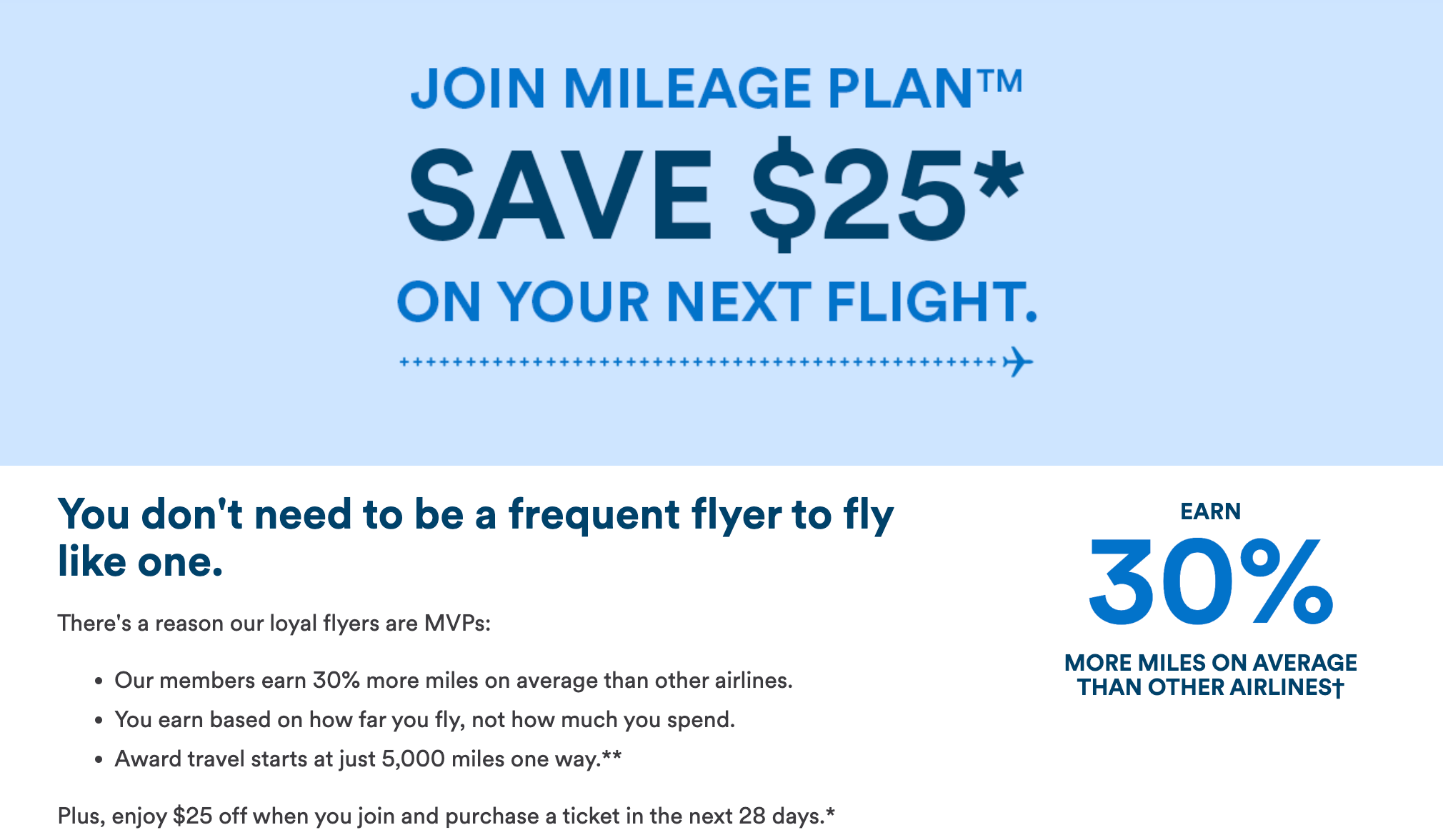
Prior to joining TPG, I did not have a loyalty account with any program besides Southwest Airlines . This was silly on my part, since loyalty programs offer various perks, including some that award bonus points simply by signing up or by completing a first qualifying activity .
Hilton Honors , Marriott Bonvoy and Alaska Airlines Mileage Plan are among the loyalty programs currently offering freebies for new members , ranging from points to miles to travel credits.
Before you book a flight or a hotel reservation, see if the brand has a loyalty program you can sign up for. If you forget to add your loyalty number at the time of booking, try doing it during check-in or reaching out to the program afterward to see if they will retroactively credit you for a flight or a hotel stay. (I have done this successfully with World of Hyatt .)
It takes time to accrue enough credit card points for great redemptions — and the same is true for points earned through loyalty programs. But over time, you'll hopefully earn enough points and miles to cover the costs of some free trips.
Entry-level status doesn't get you much
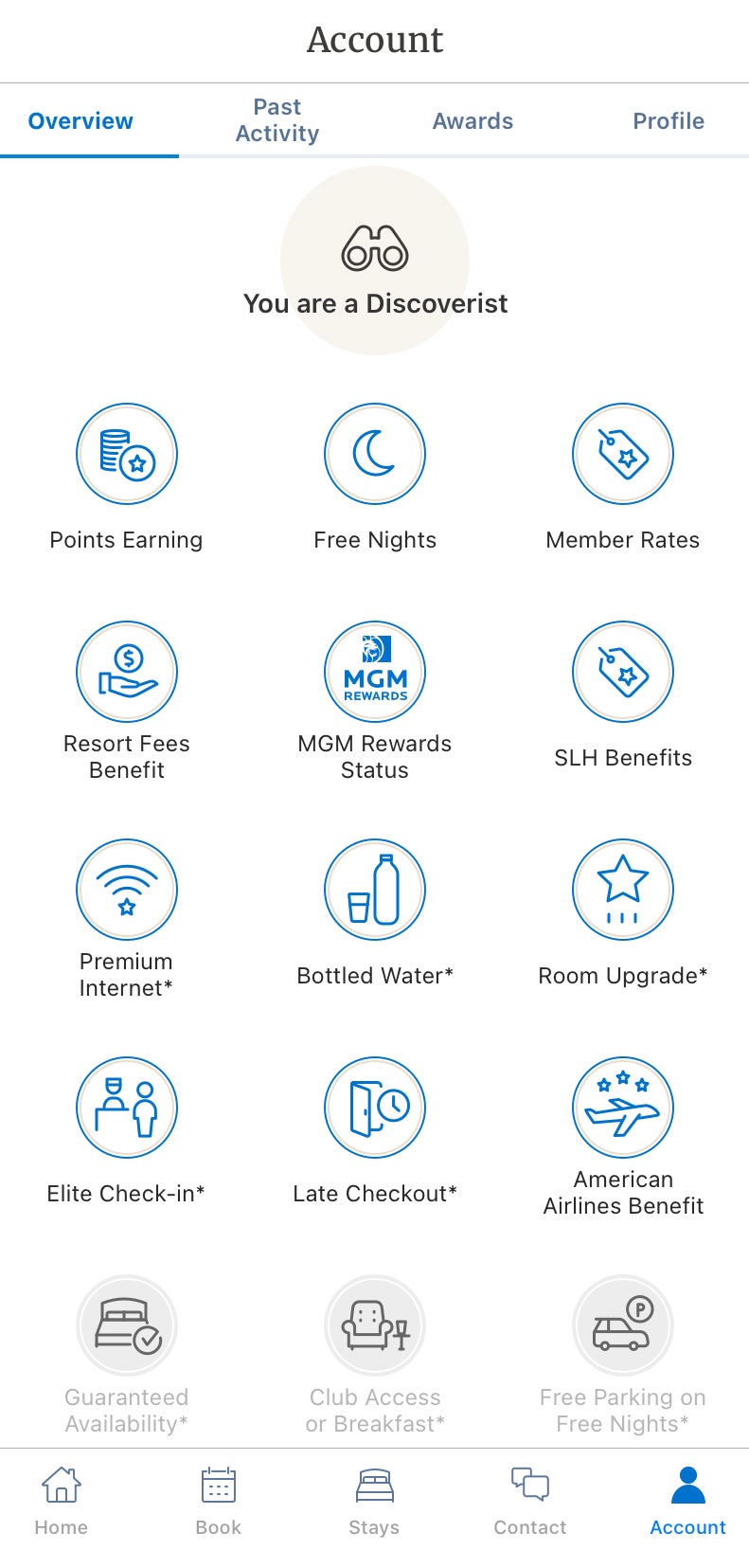
I obtained Gold American Airlines AAdvantage status last year , much to my excitement. In addition to my AAdvantage Gold status, I became a World of Hyatt Discoverist last July.
I expected to receive upgrades as a result of holding status for each program, but I have not experienced any so far (excluding one upgrade to first-class on a regional American flight last month from St. Louis to Chicago ).
Even though obtaining entry-level status means you're heading in the right direction with points accumulation, don't expect to get too much in return.
As an AAdvantage Gold member, I'm eligible for complimentary upgrades on American flights, but I'm not anticipating this to be a regular occurrence because status upgrades are granted in descending order from highest to lowest status holder. Therefore, I will likely only be upgraded if there are still seats unsold within the 24-hour period before a flight's departure.
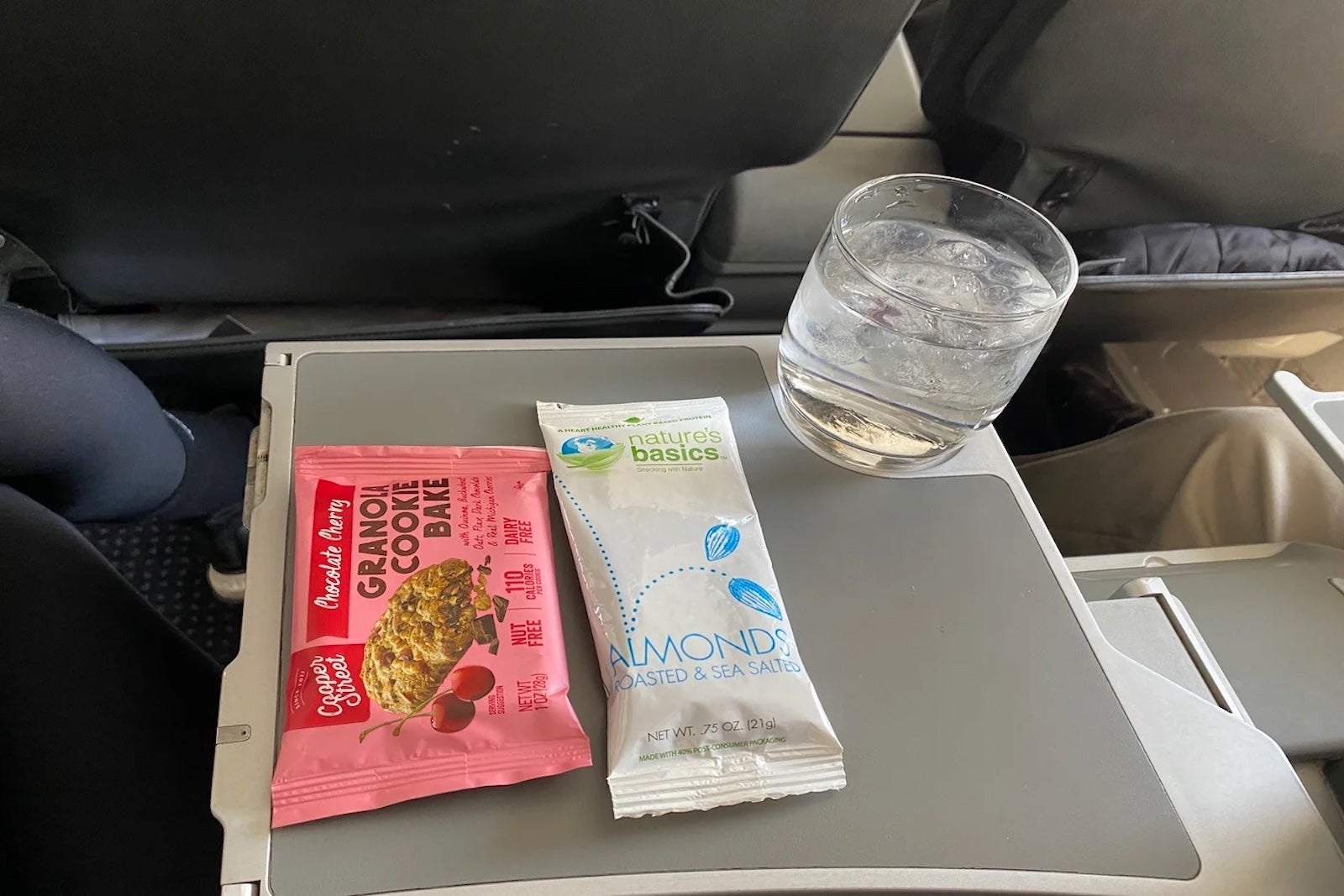
Outside of flight upgrades, Gold members are eligible for better seats, either in the preferred area of an aircraft or a Main Cabin Extra seat with extra legroom on American. I also get to board with Group 4, which is earlier than I would board without status.
Out of all of the benefits I've received thus far from my Gold status, I've enjoyed the preferential seat selection most.
For hotels, my experience as an entry-level Hyatt status holder has been similar . I've received one room upgrade thus far when staying at the Hyatt Centric in Chicago's South Loop in January.
Upon checking in, the front desk member told me I was eligible for either a bigger room or a room on a higher floor with a view. I opted for the bigger room for the extra space it provided to exercise.
Beyond that room upgrade, I also received later checkout times between 12:30-2 p.m., though this is not nearly as helpful as the 4 p.m. checkout offered as a standard benefit to Globalists (World of Hyatt's highest tier).
You also get free Wi-Fi at hotels even as just a member of a program, so it's always worth signing up.
Read more: What is World of Hyatt elite status worth in 2022?
Otherwise, I haven't noticed much of a difference with this entry-level hotel status.
As I continue frequenting Hyatts, I look forward to earning more perks , like the free breakfast that my Globalist friends receive. Higher-tier members also sometimes get costly resort fees waived and receive complimentary parking on free night awards .
I am loving earning World of Hyatt points, and I like that I have the opportunity to earn milestone rewards including two Club Lounge Access Awards after I stay 20 nights in a calendar year. I am a World of Hyatt Discoverist which you qualify for after 10 eligible nights (or when you accumulate 25,000 base points or $5,000 in spending) or by holding the World of Hyatt Credit Card and/or the World of Hyatt Business Credit Card . Both come with automatic Discoverist status.
There are ways to contribute to status beyond credit card spending
Because I want even more rewards as an American Airlines AAdvantage loyalty member, I'm attempting to become an AAdvantage Platinum. For me specifically, I have to look at ways to qualify for status beyond co-branded credit card spending alone .
I was pleased to learn that I could earn both the airline's Loyalty Points and AAdvantage miles through an activity I already participate in — online shopping. Yes, you read that correctly. You can use the American Airlines eShopping Portal to shop and earn a certain number of miles per dollar at select retailers you might already frequent, such as Lululemon, Alo Yoga, Walgreen's and Nordstrom Rack.
Another easy way to reap the benefits of activities you already participate in is by linking your credit cards to the AAdvantage Dining program . This allows you to earn between 1 and 5 AAdvantage miles per dollar spent at participating restaurants for both dine-in and takeout service.
The number of miles you earn correlates with your level of participation. For example, a VIP member earns 5 miles per dollar spent when they make 11 transactions in a calendar year through the program. All members get 1 mile per dollar spent.
For additional ways to earn AAdvantage miles that don't involve flying or using an American Airlines co-branded credit card , see our guide here .
Link your AA and Hyatt accounts
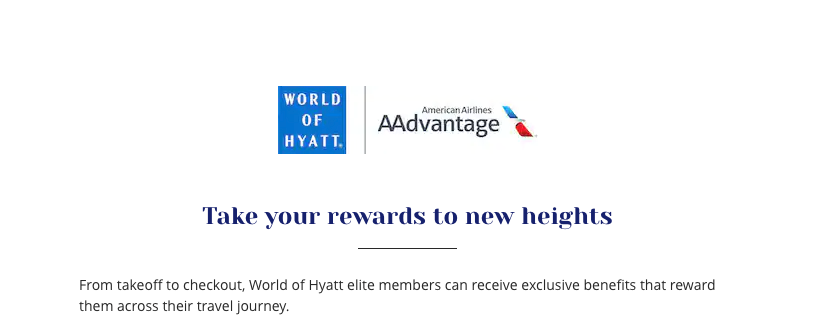
Once I became an American status holder, I started targeting Hyatt hotels specifically. This wasn't a random choice — American and Hyatt elites can link their accounts to get reciprocal benefits thanks to a partnership announced in 2019.
This means I can earn 1 AAdvantage base mile per eligible dollar spent on qualifying Hyatt stays and experiences , and 1 World of Hyatt bonus point for every eligible $1 spent on qualifying American flights. This is in addition to the points and miles I would earn on stays and flights, respectively.
To take advantage of this double-dipping opportunity, you must link your World of Hyatt and AAdvantage accounts .
Read more: Chasing American Airlines elite status? Here are 14 ways to earn Loyalty Points
Always charge your hotel meals to your room

Speaking of hotels, I learned something very valuable from TPG executive editor Scott Mayerowitz , which is to charge everything you buy at a hotel to your room.
I learned this lesson in December when dining with my aunt at Rita's Cantina, a restaurant at the JW Marriott Scottsdale Camelback Inn Resort & Spa . As I got out my credit card to pay for my portion of lunch, Scott walked by and said, "What are you doing? You should be charging that to your room."
The reason you should charge any restaurant bill to your room is that doing so will earn you more points with the hotel than if you just used any old credit card to pay for the meal. You should put all parts of a hotel stay, from the room itself to meals to any extra services, on your room bill.
Not only does this tactic allow you to earn more points, but it also could help you reach the highest levels of status.
In this case, it might help you reach their top-tier Marriott Bonvoy Ambassador status which requires $20,000 of spending each year to earn in addition to 100 nights with the chain. Every dollar (in spend) counts.
Related: What is Marriott Ambassador status worth?
The value of Chase Ultimate Rewards points
In addition to learning about hotel and airline status, another big takeaway for me during my time at TPG is how to determine the value of Chase points.
Right after I started at TPG, my coworkers convinced me to take advantage of the then-100,000 point offer for opening a Chase Sapphire Preferred Card. I earned that bonus (the card now offers a still-decent sign-up bonus of 60,000 points after spending $4,000 on purchases in the first three months of account opening) but it has taken me the subsequent nine months to earn an additional 16,000 Chase Ultimate Rewards points.
For the first time in my life, I closely looked at just how valuable the points actually are.
Chase values its Ultimate Rewards points at 1.25 cents each, meaning I could redeem these points for use on travel costs through the Chase travel portal for as much as $1,450 in bookings directly on the site.
However, based on TPG's most recent valuation of Chase points at 2 cents each , these points could be worth even more with the right redemption or transfer. TPG values my points around $2,320.
This confused me at first, because I didn't understand how Chase could value its points one way and TPG could do it another. The reason for the difference in valuation is that you can often reap a higher value out of the points by transferring these points to travel partners instead of using the Chase portal, a move that has the potential to get you outsized earnings.
"As for value, it's all in how you plan to redeem," said TPG senior reporter Katie Genter, who continues to be one of the most valuable TPG resources for points and miles newbies like me.
For example, Chase users may see the value of Ultimate Rewards increase when they transfer the points to partners like World of Hyatt .
Related: Hilton, Marriott and other loyalty programs are offering free points for new members
So does having Ultimate Rewards points mean you automatically have World of Hyatt points?
"Kind of," Genter said — but like all things points and miles, there's no short answer to this.
You can transfer Chase points to Hyatt at a 1:1 ratio , but that doesn't work in reverse. Some partners are more valuable than others based on how far a point goes. For example, you're likely to get more value from one Hyatt point than one IHG point.
Alternatively, you could use Chase points to book a Hyatt stay through the travel portal. However, you'd only get 1.25 cents per point when doing so, and you wouldn't get any elite earnings or benefits (which are only granted by booking through the hotel directly).
So, it would be more beneficial to transfer Chase Ultimate Rewards points to Hyatt and then redeem those World of Hyatt points for your stay (unless the points rate is very high or the case rate is low). This is where the TPG calculator is helpful.
The calculator is your best friend in determining whether you should use points or cash for a flight or hotel.
Personally, I haven't yet used my Chase Ultimate Rewards points, as I'm saving up for a bucket list trip. I'll be sure to update readers once that happens.
Pick a credit card that rewards your spending habits
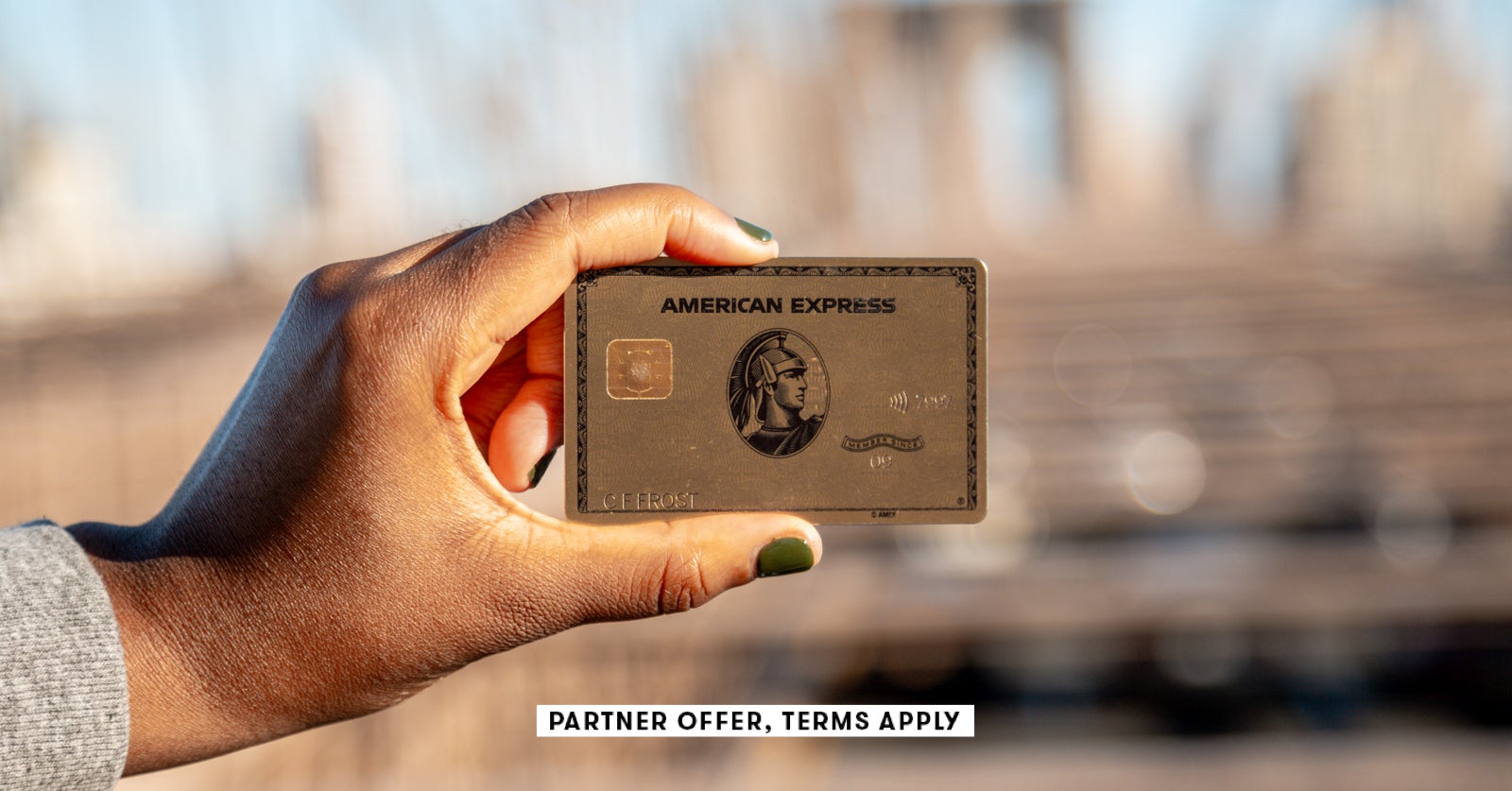
When I dove into the world of Chase Ultimate Rewards points, I took a closer look at my spending habits to see what I was actually spending money on.
Based on that research, I decided it would be worth looking into another card that rewards everyday spending. It sometimes makes sense to use different cards for specific purchases. This is one of the many tips I learned from TPG senior reporter Benji Stawski.
I like the Chase Sapphire Preferred for the 2 points per dollar on all travel and so-called "personal" purchases, which is helpful as I spend a lot on travel purchases, including Uber.
I also spend consistently on food, namely groceries from Whole Foods. Because of that, I plan to get the American Express® Gold Card, which would give me 4 points per dollar at restaurants (including takeout and delivery) and 4 points per dollar on up to $25,000 in per calendar year, then 1 point per dollar.
Cardholders also get a $10 monthly credit to use toward Uber, as well as credits on other partners, including Seamless and some Shake Shack locations — a personal favorite for me.
For non-bonus and non-everyday spending, I'm looking at the Chase Freedom Unlimited, which has no annual fee and would offer up to 1.5% cash back on purchases.
Related: Get more from your points with these 5 transfer bonuses
As you can see, it makes sense for some people to have multiple cards.
Always compare flight prices in cash versus miles
As previously mentioned, you shouldn't always assume that using points or miles instead of cash is the way to go, especially for limited-time flight deals.
For example, let's say you are considering a flight to Paris this fall. Google Flights tells me the average economy flight from the New York City area to both Paris airports — Paris Charles De Gaulle Airport (CDG) and Orly Airport (ORY) — in September costs about $1,200. There was one exception from French Bee , a low-cost carrier that costs just less than $500.
At this point, you should consider what you'd get in return for a significantly lower price tag of $491. For some, the thought process may end here; since French Bee doesn't have a mileage program, there's no miles redemption to consider.
However, if I was considering this flight, I would tell you that you get what you pay for based on my experience recently flying French Bee's inaugural Los Angeles International Airport (LAX) to ORY route . Therefore, I am going to calculate the value of the other available flights.
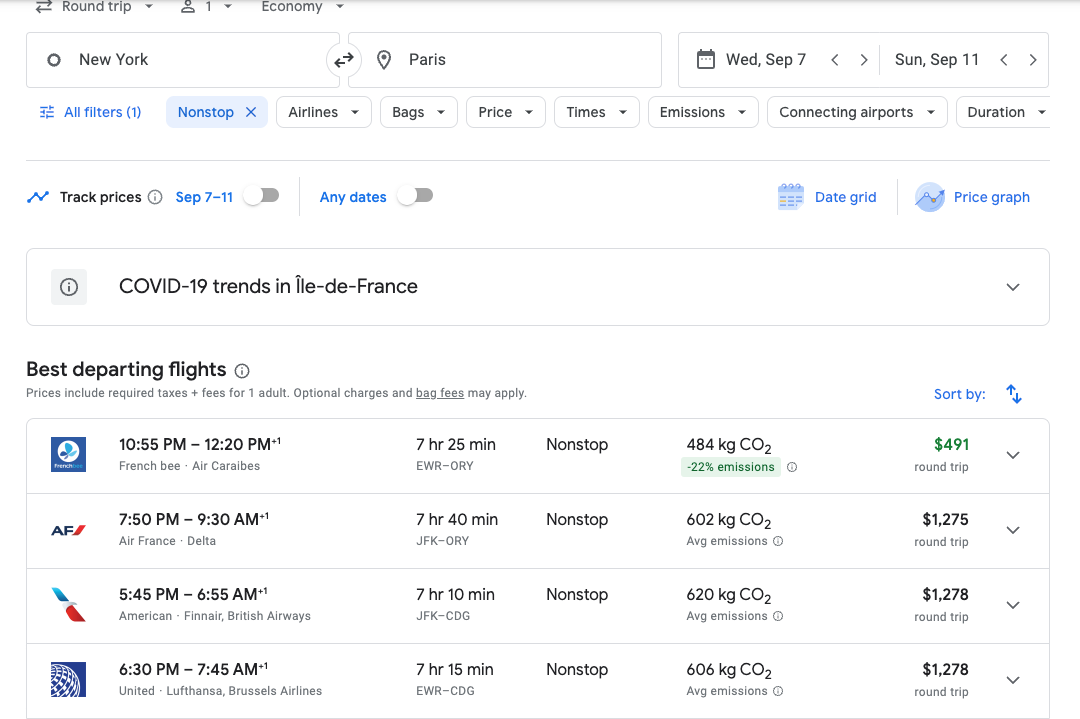
Since I am attempting to reach American Airlines status , I'd first look at the cash price of the American flight, before determining how much the same flight would cost in miles. In this case, it would be 60,000 AAdvantage miles plus $83.77 in taxes and fees.
Read more: Never say never: I just got upgraded as a lowly AAdvantage Gold member
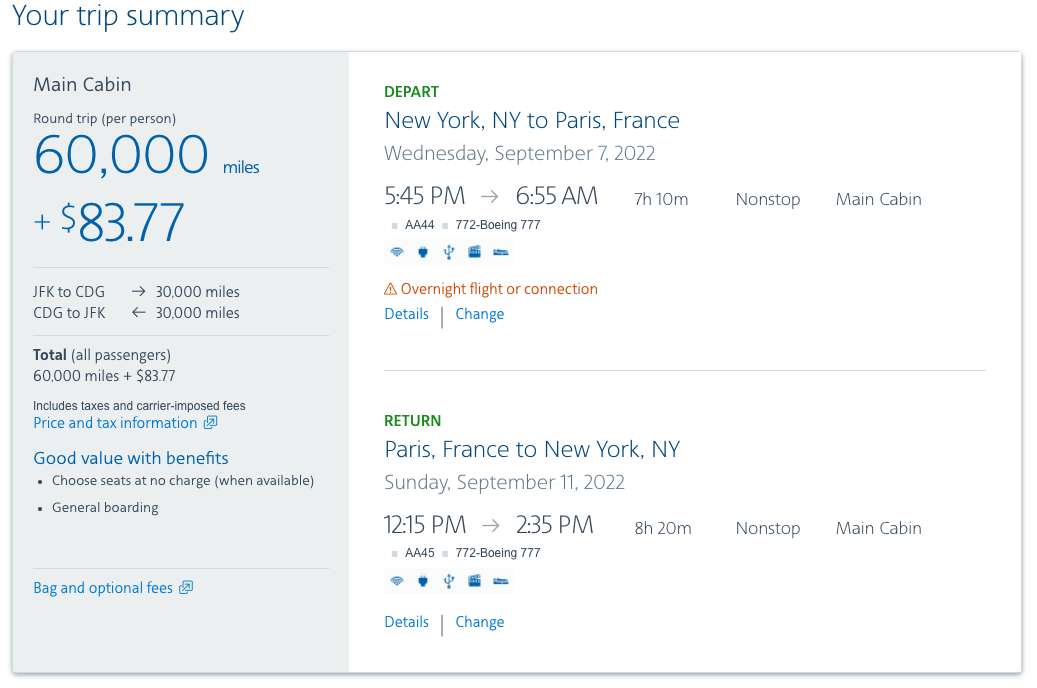
With the cash and miles price in hand, I headed to our calculator to compare how much money I would save by using cash versus miles to book this flight. Based on TPG's current valuations , which peg AAdvantage miles at 1.77 cents a piece, I would actually save $186 by booking this flight with miles. This doesn't take into account the number of Loyalty Points you would earn for the cash booking (in my case around 8,400 Loyalty Points). Your mileage may vary.
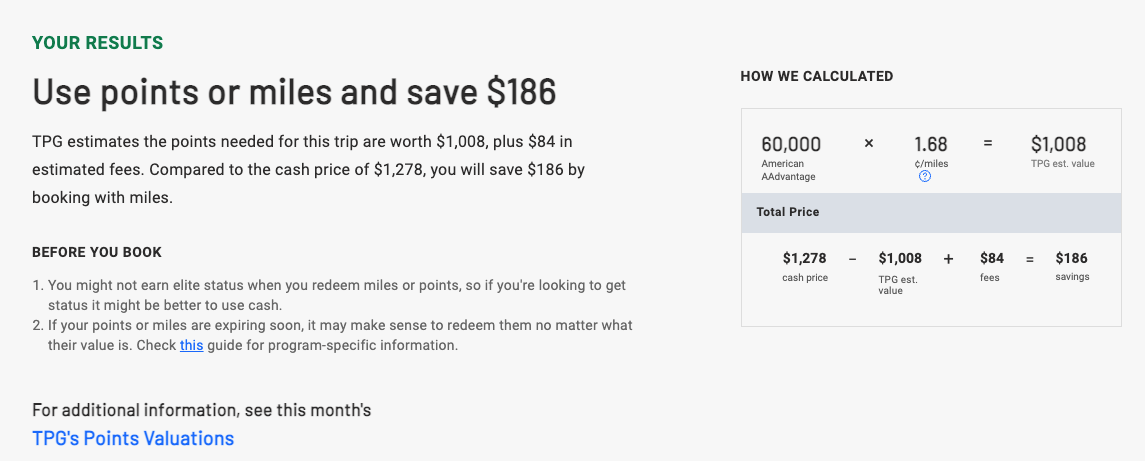
Be sure to bookmark the TPG calculator for your future use.
Compare the value of booking through an airline versus booking with a transfer partner airline
As you go through the process of booking flights, you should also see whether there's an opportunity to transfer miles from a rewards portal to book with another airline that may be a better value.
For example, I can use AAdvantage miles from flying American-operated flights to book award tickets on other Oneworld alliance carriers, but I can't transfer those miles between partners.
You should compare the partners to see which can offer you the best value.
For instance, while you can book trips on Oneworld partner airlines such as British Airways and Japan Airlines using AAdvantage miles, you may be better off transferring Chase Ultimate Rewards points directly to British Airways for that redemption.
Here is just one example to compare how much it would cost to use miles to book the same flight through American versus British Airways.
A round-trip main cabin fare from John F. Kennedy International Airport (JFK) to Heathrow Airport (LHR) booked through American would cost 60,000 AAdvantage miles plus approximately $650 in fees. That same flight booked through British Airways would cost only 26,000 Avios plus $318.50 in fees for the economy cabin. In this case, it would make more sense to use British Airways miles versus AAdvantage miles.
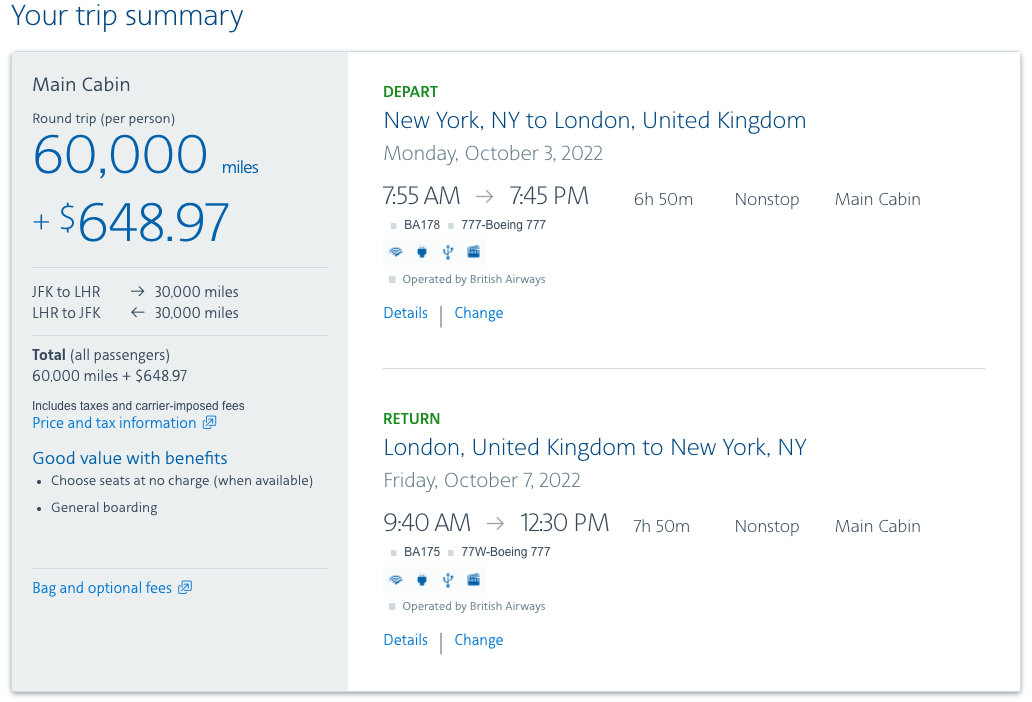
And while it appears that using miles is the way to go here, let's run these numbers on the calculator to make sure. Indeed, you would save $316 by using AAdvantage miles or $633 by using Avios. Therefore, transferring using Avios, in this case, is a better deal.
A good rule of thumb for transferring points is that you only want to do so when you have a specific redemption in mind. There are also times when a transferable currency program offers a periodic transfer bonus period with a deadline to transfer the points; this can yield lucrative points redemptions.
Read more: Get more from your points with these 5 transfer bonuses
Bottom line
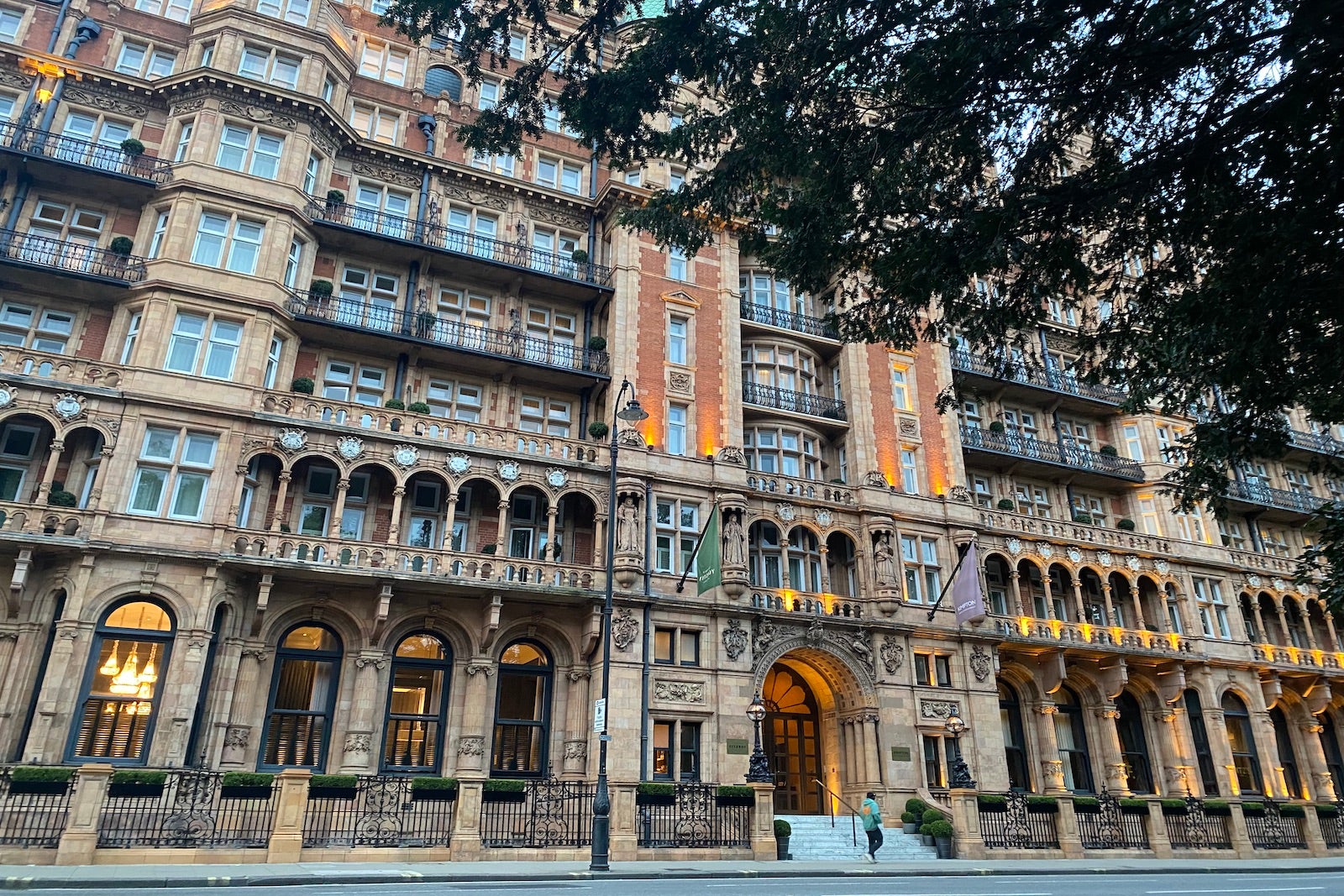
As you have read, there is a lot to learn when it comes to points, miles and loyalty. You have to treat it like a game and turn it into a hobby to really make it work since there's not one single credit card, loyalty program or method that will solve every travel problem.
Related: Here's why American's new Loyalty Points are a game changer for me
Here's my biggest takeaway: It's complicated. TPG is in the business of making it easier, but I can tell you firsthand it's not easy. The rules are also constantly changing, so you need to do your homework. It's something that you really need to study to fully maximize, but the more you learn, the more you'll benefit. It's simple to get free travel — even if you are not an expert — by following just a few of the tips I've gone over in this story.
A Travel Points Hacker Spills His Secrets

ONE EMAIL. ONE STORY. EVERY WEEK. SIGN UP FOR THE VICE NEWSLETTER.
By signing up, you agree to the Terms of Use and Privacy Policy & to receive electronic communications from Vice Media Group, which may include marketing promotions, advertisements and sponsored content.

The Ultimate Guide to Travel Hacking: Hotel Rewards
Disclosure: The Globetrotting Teacher may receive commission from card issuers. Some or all of the card offers that appear on the The Globetrotting Teacher are from advertisers & may impact how & where cards appear on the site. The Globetrotting Teacher does not include all card companies or all available card offers. Opinions, reviews, analyses & recommendations are the author’s alone, and have not been reviewed, endorsed or approved by any of these entities.
Most people who start earning miles and points focus initially on award flights.
There’s no denying the huge chunk of a travel budget airfare occupies, even as airlines compete with one another to offer the best pricing and offer periodic promotions.
However, hotel rewards offer tremendous value, as well. On a typical 1-2 week trip, using points for award nights at a hotel can save hundreds, even thousands of dollars.
And, this is before you factor in the value of any elite hotel benefits you’re eligible to receive.
Even vacation rentals can be quite expensive without the help of cashback and other travel rewards to offset the cost.
In this post, let’s take a break from award flights and focus instead on using points to earn hotel rewards.

Step 1- Hotel Brands
There are many hotel programs that have loyalty programs. However, a few, in particular, are popular with points and miles enthusiasts.
These hotel brands are:
- Choice Privileges
These brands are popular because of their global footprints, the convenience of earning points & free nights through co-branded hotel credit cards and travel rewards credit cards with transferrable points programs, as well as because of the status and elite benefits they offer.
Each hotel brand includes a variety of hotel properties that include budget lodging, luxury accommodations, and everything in between.
For example, IHG encompasses Holiday Inn Express, Crowne Plaza, and Intercontinental Hotels. These brands range from low to high, in terms of cost.
The chart below shows a small sampling of hotels, their loyalty programs, and the type of brands they are.
It’s important to know which hotels belong to which brand, as well as how to go about earning points for hotel rewards.
ProTip: Also, look at A Beginners Guide to Hotel Reward Programs . There’s a handy chart that gives a complete look at brands, the hotels they include, and the pros and cons of each of the major hotel reward programs.
Step 2- Strategies for Hotel Rewards
As with earning miles and points for award flights, you want to target the hotel points you earn toward your short and long-term travel goals.
Initially, as you get started with points and miles, focus on the destination(s) you would like to plan trips to in the near term.
Some research will help you to understand which hotel brands have hotels where you want to stay.
ProTip: Use tools like Hotel Hustle and AwardMapper to see which loyalty program hotels are in the destination to which you want to travel. These websites can be helpful but are also just a starting point on which to base your hotel research.
In bigger cities and popular destinations, you’re likely to find hotels belonging to several of the brands mentioned above.
You might also prefer to earn hotel points with a particular hotel brand you like.
One of the benefits of hotel brands with a large reach is you can find the same amenities and comfort level you’re used in a range of destinations.
For example, staying at a Hampton Inn is likely to be similar whether you’re in Florida or California simply because of the standards the brand aligns with.
Both are effective approaches, especially if your aim is to make points and miles a long-term habit.
Just keep in mind that you never want your hotel points (or airline miles) to sit too long unused because of the risk that their value can decrease or even expire.

Of course, your travel style factors into your decision and influences which hotels are better suited to your tastes.
- Do you prefer upscale or more modest accommodations?
- Do you travel as a family and need more space or extra beds?
Certain hotel brands will fit your needs and preferences better than others.
ProTip: What happens if there’s no loyalty program hotel in your destination? Or perhaps there’s a cute boutique hotel you’d like to stay in instead? Use a program like the Hotels.com Rewards program to earn towards a free night.
Step 3- Earning Hotel Rewards
As with earning miles for airfare, credit card welcome bonuses can be quite lucrative for earning hotel rewards.
Co-branded hotel credit cards will allow you to earn points with just that hotel program.
These include cards like:
- Hilton Honors Credit Card
- World of Hyatt Credit Card
- IHG® Rewards Premier Credit Card
- Marriott Bonvoy Boundless® Credit Card
Flexible point-earning cards , like the Chase Sapphire Reserve or the American Express Gold , will let you transfer your points to a variety of hotel reward programs.
But, you’ll want to be careful about transferring high-value flexible points to lower-value hotel programs.
For example, Chase Ultimate Rewards points transfer to Hyatt , IHG, and Marriott.
Ultimate Rewards points are valued at about 2 cents each. Consider that IHG points are worth .7 cents each and Hyatt points about 1.8 cents each.
These values are relative and often just the starting point for how much value you can get when maximizing your award travel redemptions.
Transferring Chase Ultimate Rewards points to IHG for a .7 cent valuation would be considered a loss on the value of your points.
Instead, it’s wiser to save your Chase points and easily earn IHG points in other ways, like with the IHG trick .
In contrast, Hyatt is arguably the best Chase Ultimate Rewards transfer partner. Hyatt redemptions are typically high value given the upscale nature of their hotel lineup and the benefits that are possible with elevated status.
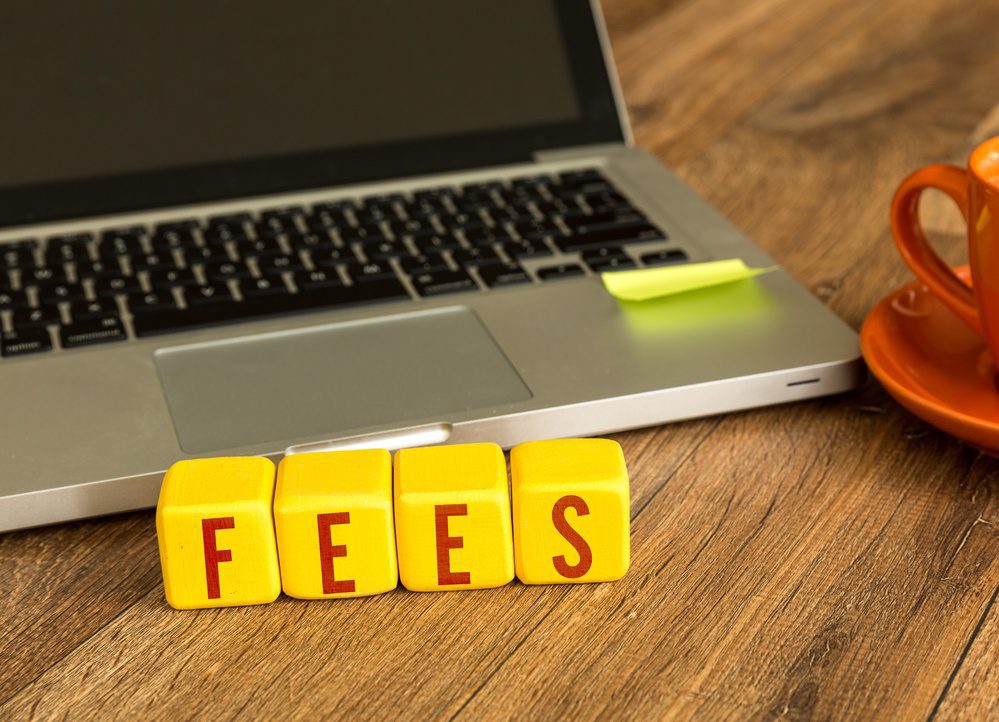
Co-branded hotel credit cards typically have an annual fee, like many travel rewards credit cards.
If you’re like many miles and points beginners, you’re probably wondering whether paying an annual fee is worth it or not.
Yet, co-branded hotel credit cards are where the value in paying the annual fee just might be the most obvious.
Consider Chase’s World of Hyatt Credit Card with its $95 annual fee.
Each year you renew your card by paying the annual fee, you’ll earn a free night certificate for a Category 1-4 hotel.
Depending on the destination and the hotel, a Category 4 Hyatt hotel can cost $300+. Paying the annual fee becomes a no-brainer with this type of return value.
Chase’s IHG® Rewards Premier Credit Card and Marriott Bonvoy Boundless® Credit Card card both earn a free night each year you renew your card. In both cases, the annual fee is more than offset by the value you’ll get for a free hotel night.

Another way to earn hotel points is through shopping portals and dining program rewards . These provide even more options to earn hotel points from everyday spending.
Lastly, hotel reward programs often run promotions. You can earn bonus points or award stays for completing a challenge or staying some number of nights. These promotions generally happen each season or quarter.
For example, years ago I took advantage of a Radisson promotion by staying at an inexpensive hotel outside of Washington, DC. The hotel stay hit many of the promotion’s bonus tiers and earned enough points for all my hotels on a trip to Europe .
Promotions can also be stacked with co-branded hotel credit card earnings.
For instance, the Hilton Honors Surpass earns 12x the points for every dollar spent on Hilton purchases. During a promotion, like earn 2,500 Hilton points per stay, you’d earn the points from your credit card, plus the points from the promotion.
It’s always a good idea to sign-up to receive emails, follow hotel brands on social media, and even check your snail mail for the latest hotel promotional offers.
When you see them pop up, register for them right away even if you don’t have a stay planned. If your plans change, you’ll be ready to take advantage of the promotion.
Bottom Line:
Hotel rewards can deliver a huge return and save you a lot of money on your next trip.
Spend some time investigating hotels in your next destination. If you haven’t already done so, sign up for hotel loyalty programs and add your member number and password to your travel hacking spreadsheet.
Investigate the hotel co-branded credit card that’s right for you .
What is your strategy for earning hotel rewards?
Like this post? Please share it on social media using the share buttons below.
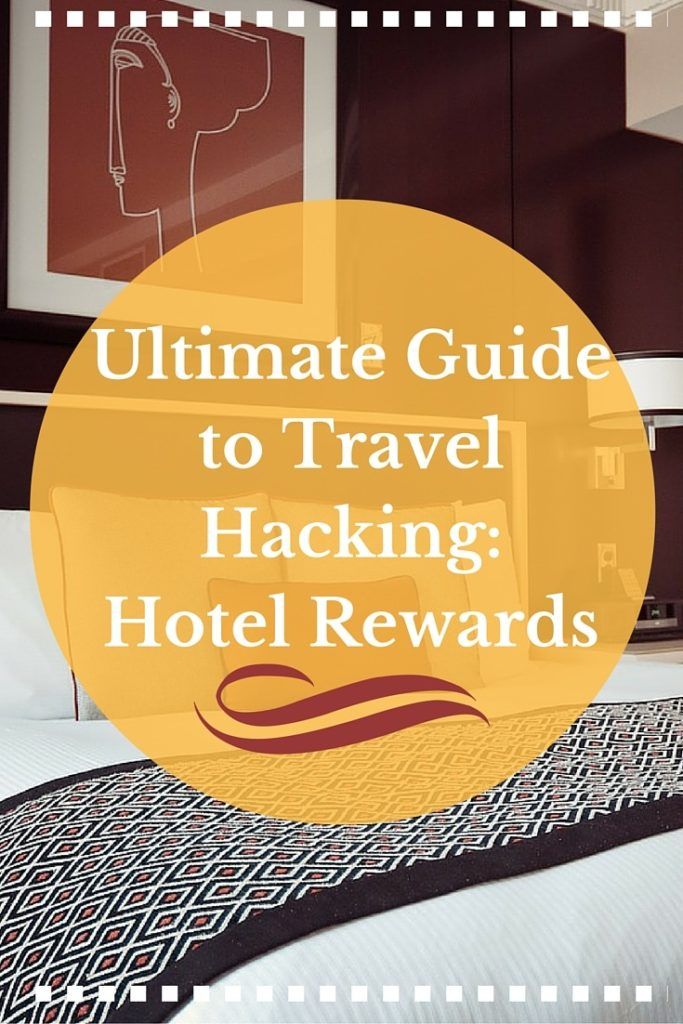
Related Posts
Earning with dining programs.

The Wonders of Shopping Portals
2 thoughts on “the ultimate guide to travel hacking: hotel rewards”.
This is great article for travelling. Thanks
Thanks for reading, Kemal. 🙂
Leave a Comment Cancel Reply
Your email address will not be published. Required fields are marked *
Save my name, email, and website in this browser for the next time I comment.
This site uses Akismet to reduce spam. Learn how your comment data is processed .
Privacy Overview
The travel hacker’s secret weapon: how to fly free (and faster) with Chase Ultimate Rewards®
Marketing speak can be a real turn-off: Companies always claim to offer the “greatest” this or the “most incredible” that, but the reality often falls short. By calling its credit card rewards program “Chase Ultimate Rewards®,” Chase is basically begging you to differ.
In this case, however, the actual benefits of the program live up to the promise of its pretentious name.
Most people, unfortunately, will only get minimal value from the Chase Ultimate Rewards® program, since it can be confusing. The key to getting this program to live up to its name is to understand the best ways to earn the most points and the ideal way to spend them.
Earning Chase Ultimate Rewards® points
Chase offers several credit cards that give you Chase Ultimate Rewards® points for every dollar you spend. Each card has different features and benefits, and you need to hold the right combination of cards to earn the most points.
Here’s a brief rundown of some of what Chase offers:
Chase Freedom Flex℠
The Chase Freedom Flex℠ offers 5% cash back on up to $1,500 in combined purchases in bonus categories each quarter you activate.
Cardholders can earn $200 bonus after you spend $500 on purchases in the first 3 months from account opening. Cash back rewards never expire, so if you’re trying to travel for less, the goal is to gain as many points are possible. Other incentives with the Chase Freedom Flex℠ is you’ll earn 5% cash back on travel purchases when you book through Chase Ultimate Rewards®, 3% cash back on dining, takeout, and drug store purchases, and unlimited 1% cash back on all other purchases.
There is no annual fee for this card; so lots of opportunities to save toward your next trip.
Chase Sapphire Preferred® Card
The Chase Sapphire Preferred® Card offers 5X points on travel purchased through Chase Ultimate Rewards, 3X points on dining, 2X points on all other travel purchases, and 1 point per dollar spent on all other purchases.
There is a $95 annual fee for this card and no foreign transaction fees. New applicants earn 60,000 bonus points after you spend $4,000 on purchases in the first 3 months from account opening. That's $750 when you redeem through Chase Travel℠.
Ink Business Cash® Credit Card:
With the Ink Business Cash® Credit Card, earn 5% for office supplies, internet, cable, and phone purchase on the first $25,000 spent in combined purchases.
Customers can redeem their cash rewards in a variety of ways including cash, gift cards, products and services available through Chase Bank or eligible third parties, and even to pay for travel through Chase Ultimate Rewards®.
You’ll also get 2% for gas and restaurants on the first $25,000 spent in combined purchases; 1% for everything else.
There’s no annual fee for this card.
Choosing the right card(s)
What’s great about the Chase Ultimate Rewards® program is that you can transfer points between the different cards you have, and even between your spouse or domestic partner. The best way to max out this feature is to have multiple cards that you use for different purchases.
Start with a cash-back card— like the Chase Freedom Unlimited® –which will earn you rewards on every purchase, but don’t allow you to transfer points to airline miles. If you really want to max out your rewards, you can create a duo, for example, of the Chase Freedom Unlimited® and the Ink Business Cash® Credit Card.
Finally, you need a card like the Chase Sapphire Preferred® Card to get bonuses for travel and dining. With this combination, you will get a noted minimum and maximum. Use this strategy, and your balances of points will soar.
Transferring your rewards to points and miles
As long as you have a card like the Chase Sapphire Preferred® Card , then you can get the most value from your points by strategically transferring them to seven different airlines and four different hotel partners.
You can then redeem points and miles for expensive reservations such as luxury hotel rooms, last minute flights, or seats in business or first class.
There are many great deals that you can take advantage of when you transfer your points to airlines and hotels, but here are a few examples (subject to change):
- British Airways Avios —You can redeem them for flights on American Airlines. 7,500 points gets you any one-way flight that’s 1,151 miles or less.
- Korean Air SkyPass —Get a round-trip, first-class award to Hawaii on Delta. Economy class is just 25,000 points.
- Singapore Airlines —Enjoy their incredible First Class Suites for 91,375 miles one-way between Los Angeles and Singapore.
- Southwest —Your points are worth about 1.4 cents each towards any flights in their “Wanna Get Away” fare class.
- Hyatt Gold Passport Program —You can enjoy free night stays starting at just 5,000 points. This program allows points to be redeemed for free nights in any unsold room with no blackout dates.
The Chase Ultimate Rewards® program is incredibly valuable, but only if you know how to max it out. By using the right credit cards to earn the most points, and transferring those points to airlines and hotel, you can stretch your rewards further than you may have thought.
About the author

Jason Steele
Jason Steele has been writing about credit cards, travel and personal finance since 2008, and is passionate about using his cards to travel for free. Jason contributes to many of the top personal finance and travel sites and has been widely quoted in mainstream media as a credit card expert. Jason lives in Denver Colorado where he enjoys bicycling, snowboarding and flying.
Your money deserves more than a soundbyte.
Get straightforward advice on managing money well.
Most financial content is either an echo chamber for the "Already Rich" or a torrent of dubious advice designed only to profit its creators. For nearly 20 years, we've been on a mission to help our readers acheive their financial goals with no judgement, no jargon, and no get-rich-quick BS. Join us today.
We hate spam as much as you do. We generally send out no more than 2-3 emails per month featuring our latest articles and, when warranted, commentary on recent financial news. You can unsubscribe at any time.
Nomadic Matt's Travel Site
Travel Better, Cheaper, Longer
How to Earn Points and Miles in Canada

Collecting points and miles is one of the best ways to lower your travel costs. Flights, accommodation represent two of the biggest expenses travelers face so getting those to zero allows you to travel more for less. When money isn’t a worry, the world is your oyster.
While I have tons of points and miles resources on this website for U.S. travelers, I get a lot of questions from Canadians about whether they can take advantage of points and miles too. And the answer is always yes!
While the U.S. has the most deals and opportunities, Canada isn’t too far behind and is the second biggest points market in the world.
To help you understand the Canadian points and miles world, I reached out to my friend and fellow travel blogger Ricky Zhang from Prince of Travel . In this interview, he shares his tips and tricks.
Nomadic Matt: Hey Ricky! Thanks for doing this! To begin, tell us about yourself. Ricky : I’m based out of Montreal and Toronto , and I’ve always loved to travel and get the best bang for my buck when doing so. For the past few years, I’ve run the Prince of Travel website, which is dedicated to helping my fellow Canadians maximize their frequent flyer miles and credit card points to travel the world at a fraction of the price.
How did you get into the points and miles game? I first became interested in points and loyalty programs back in 2013. As a university student in Canada , I was making frequent trips back home to China to visit my family and I was trying to figure out how I could get airport lounge access.
It turns out that there was a little-known opportunity to earn top-tier Star Alliance Gold status very easily with the loyalty program of Aegean Airlines, the Greek national airline. I figured out that I could simply credit the miles from one or two of my round-trip flights to Aegean and I’d end up with Star Alliance Gold, which would get me the lounge access I wanted.
That led me to the online blogs and forums, where I quickly learned that credit card points — and specifically the signup bonuses — was the key to racking up the points and funding many trips around the world (often in business class or First Class) at a fraction of the price.
From there, I was hooked and I’ve just continued honing my craft over the years!

The U.S. is known for its awesome travel credit cards. How does Canada compare? Many outside observers would probably guess that the Canadian travel credit card market is less lucrative than the US and, while that’s true in some ways, there are also ways in which Canada is the more favorable place to be.
The US has a wider range of travel credit cards, provides access to a greater number of airline and hotel programs, and also gives consumers larger quantities of signup bonuses (for example, 100,000-point bonuses are a regular occurrence whereas, in Canada, the single-highest signup bonus is 75,000 points).
However, the US credit card issuers are also stricter about limiting the number of signup bonuses that a single individual can obtain (or imposing limits on how often you can obtain them), whereas the Canadian issuers haven’t imposed such limits, making Canada much more favorable in terms of earning the signup bonuses repeatedly.
Almost all the cards in Canada let you double- or triple-dip on the bonus (although the terms and conditions may not always say so). It’s easy for issuers to update their terms and conditions to say that you’re only eligible for a once-in-a-lifetime bonus, but much more challenging for them to actually enforce that from an IT perspective.
In addition, there are ways for Canadians to apply for US credit cards as well, thus letting us play the game on both sides of the border!
Really? How can Canadians get a U.S. travel credit card? Well, to do that, you need three things:
- A US address
- A US bank account
- A social security number (or something equivalent)
The address is easy. Just use a friend or family member’s address, or a mail-forwarding service. The bank account is also easy. Just use the cross-border banking service of your favorite Canadian bank to set up a US domiciled bank account with your US address listed on it.
The social security number part is tricky. You can’t just get one unless you actually study or work in the US. Instead, you can get an Individual Taxpayer Identification Number (ITIN), which is an equivalent number that many issuers also accept in place of an SSN.
Any foreign resident can get apply for an ITIN from the IRS if they show that they’ve earned income in the US (for example, if you’ve earned $5 gambling in Vegas) but need to be exempt from withholding taxes on that income as a foreign resident. Once you have your ITIN, you can use that in place of the SSN on US credit card applications – and voilà!

What are some of the best credit cards in Canada right now? The single-highest signup bonus one can obtain in Canada is the American Express Business Platinum Card, which gives you 75,000 Membership Rewards points upon spending $7,000 (CAD) in the first three months.
This card is also very valuable for its referral bonus of 25,000 Membership Rewards points, which you earn simply for referring a friend or family member to a card of their own, and can add up very quickly after just a handful of referrals. Then you’ve also got the unlimited Priority Pass lounge access and the Marriott Gold Elite status perks as well.
However, the Business Platinum does come with an annual fee of $499. For those who are more interested in First Year Free offers to minimize their out-of-pocket cost, I’d recommend the TD Aeroplan Visa Infinite, which is offering 30,000 Aeroplan miles + First Year Free.
Moreover, RBC Avion points can be very valuable due to how flexible they are, so in that regard the RBC Visa Infinite Avion is another great card to pick up, offering 15,000 Avion points at signup.
In most cases, you don’t need to be a small business owner in the traditional sense to get a business card. Instead, you apply as a “sole proprietor”, which is a form of doing business in which you operate under your own name. Just enter your own name as the business name and apply, and most issuers are happy with it.
And what about debit cards? When it comes to avoiding ATM fees abroad? The frontrunner in this regard is the Stack Prepaid MasterCard, which does not impose any foreign transaction fees on foreign ATM withdrawals. Stack is free to apply for and to load funds, and only charges you the fair currency exchange rate when you withdraw money at a foreign ATM (although the local ATM fee may still be charged). It’s my go-to method for withdrawing cash while I’m traveling.
What tips do you have for new points and miles collectors in Canada? There’s always a ton of reading and scouring online blogs and forums at the start of the learning curve, but the best way to actually get started would be to think about one or two places you’d like to go over the next year (which places, what time of year, how many passengers, what class of service, etc.), then research specifically the best ways to make that trip happen using points, and then put together a strategy for earning those points using credit card signup bonuses.
Having this strategy in place will allow you to learn the ropes and reap rewards much faster than if you simply opened credit cards left, right, and center without a clear goal in mind.
Besides that, try to make it out to an in-person event or meetup at some point so that you can get to know other members of the community — that’ll accelerate your learning process by leaps and bounds. You can learn about them from some of the following groups/websites:
- Prince of Travel Elites
- PointsNerd.ca
- RedFlagDeals
- Welcome Bonuses for Canadians (Reddit)
I try to host in-person events for Prince of Travel readers about twice a year, and I’m also looking to host a larger-scale PointsCon event sometime later this year, so stay tuned for details on that one.
Otherwise, the Prince of Travel Elites community regularly hosts small informal gatherings, which are known as “Miles & Pints”, in cities all across Canada, so make sure to join the group and keep an eye out for the next event in your area!
Where can people find you online/on social media to learn more? I can be found sharing Miles & Points knowledge, industry news and analysis, travel tips, and reviews from my own trips every day at princeoftravel.com and sharing weekly videos on my YouTube channel . Also follow me on Instagram , where I post the highlights from my travels, and get to know the rest of the community on my Prince of Travel Elites group on Facebook !
Book Your Trip to Canada: Logistical Tips and Tricks
Book Your Flight Use Skyscanner to find a cheap flight. They are my favorite search engine because they search websites and airlines around the globe so you always know no stone is left unturned.
Book Your Accommodation You can book your hostel with Hostelworld as they have the biggest inventory and best deals. If you want to stay somewhere other than a hostel, use Booking.com as they consistently return the cheapest rates for guesthouses and cheap hotels.
Don’t Forget Travel Insurance Travel insurance will protect you against illness, injury, theft, and cancellations. It’s comprehensive protection in case anything goes wrong. I never go on a trip without it as I’ve had to use it many times in the past. My favorite companies that offer the best service and value are:
- Safety Wing (for everyone below 70)
- Insure My Trip (for those over 70)
- Medjet (for additional repatriation coverage)
Looking for the Best Companies to Save Money With? Check out my resource page for the best companies to use when you travel. I list all the ones I use to save money when I’m on the road. They will save you money when you travel too.
Want More Information on Canada? Be sure to visit our robust destination guide on Canada for even more planning tips!
Got a comment on this article? Join the conversation on Facebook , Instagram , or Twitter and share your thoughts!
Disclosure: Please note that some of the links above may be affiliate links, and at no additional cost to you, I earn a commission if you make a purchase. I recommend only products and companies I use and the income goes to keeping the site community supported and ad free.
Related Posts

Get my best stuff sent straight to you!
Pin it on pinterest.
Trailer - Australian Travel Hacking Podcast Australian Travel Hacking
- Places & Travel
Welcome to the Australian Travel Hacking Podcast. Transform luxury travel, making first class cheaper than economy with points, miles and deals. Helping you turn your bucket list into a checklist! Follow to Learn how
- Episode Website
- More Episodes
- Copyright 2024 Harrison Duplex
- Zur Navigation
- Zum Seiteninhalt
- Zur Inhaltssuche
Seiteninhalt

What the Hack: Die besten Tipps der Profis für unbeschwertes Reisen
Flugbegleiter Florian Schwebel ist auf Reisen gern für alle Fälle gewappnet. Hier verrät er seine besten Travel Hacks
In meinem Job habe ich eines schnell gelernt: Meistens braucht man nie all die Klamotten, die man in seinen Koffer gepackt hat. Deshalb wähle ich sehr bewusst aus, was ich mitnehme. Besonders dann, wenn ich wie so oft nur 24 Stunden an einem Ort bin.

Travel Hack #1: Jogsuit
Immer dabei habe ich einen „Jogsuit“ in einer Basicfarbe wie Grau oder Blau. So nennen sich Anzüge aus Jogginghosenstoff, die es von verschiedenen Marken gibt. Sie haben keine Bügelfalte, knittern nicht und sehen in Kombination mit Sneakern sehr lässig aus. Vor Ort kann man sie in die Waschmaschine stecken und ist sofort top gestylt, wenn man kurz nach der Ankunft abends noch ausgehen möchte.
Travel Hack #2: Longsleeve aus Merinowolle
Auf meiner Packliste steht auch immer ein Longsleeve aus Merinowolle. Das Material hat den Vorteil, dass es schweißresistent ist und die Temperatur gut regulieren kann. Das ist sehr praktisch, wenn man nicht weiß, welches Wetter einen vor Ort erwartet. Genauso wie eine superleichte, komprimierbare und wasserdichte Jacke, die sich zu einem kleinen Paket zusammenfalten lässt.
Travel Hack #3: Feuchtigkeitsspray
Damit ich nach einem langen Flug von Deutschland in die USA frisch und wach aussehe, sprühe ich mir gern Feuchtigkeitsspray ins Gesicht. Das wirkt Wunder.
Travel Hack #4: Seesack
Auf Kurztrips habe ich statt eines Hartschalenkoffers meist nur einen kleinen Seesack dabei. Der lässt sich im Flugzeug leichter ins Gepäckfach knautschen. Und für den Fall, dass ich unterwegs Zeit zum Shoppen habe, habe ich immer eine zusammenfaltbare Mini-Reisetasche dabei. Man weiß ja nie, was man alles entdeckt.
Zur Person:
Florian Schwebel ist Flugbegleiter bei Lufthansa. Er reist sowohl interkontinental auf der Langstrecke als auch innerhalb Europas.
Bereit, die Welt zu entdecken?
Buchen Sie Ihren Flug und finden Sie neue Inspiration – wo auch immer die Reise hingehen mag.
Flug suchen
Insider Today: 'Stopover' travel hack
- This post originally appeared in the Insider Today newsletter.
- You can sign up for Business Insider's daily newsletter here .

Welcome back to our Saturday edition! Wait — don't put down that yummy dessert. One 38-year-old woman told Business Insider that instead of skipping treats, she lost 140 pounds in two years by eating more high-protein foods.
That's great news for foodies like myself. Keep reading for more good news to kick-start your weekend.
On the agenda:
"Stopover" programs let travelers explore between connecting flights .
What it's like to work with a life coach who charges $400 a month .
"Challengers" turned Zendaya and the cast into tennis stars .
Two lifestyle adjustments helped one woman lose 55 pounds .
But first: Power lunches are back, baby.
If this was forwarded to you, sign up here . Download Insider's app here.
This week's dispatch
Power hungry (literally).
It's no secret that many deals are made outside of the boardroom.
In 2013, Jeff Bezos famously secured The Washington Post for $250 million while traipsing around Hailey, Idaho during the Allen & Company Sun Valley Conference. That's where billionaires and other business types strike deals while competing in tennis matches, going on guided hikes, and yes, eating lunch.
You don't have to be a billionaire to capitalize on a midday meeting, though. Enter: the power lunch. (Or should I say "remember the power lunch"?)
As the call to return to the office slowly drags on, many are taking advantage of what can happen over a nice meal.
One BI reporter went to Cecconi's in West Hollywood to find out why the Soho House-owned restaurant has been a mainstay for power-lunchers for 15 years. Her review is the first of many stories that will dig into some of the hottest power-lunch spots across the country.
Although she had a mixed review of the menu, what remains true is that productivity isn't just reserved for the office.
Score a "stopover" flight
Need a vacation within your vacation? Some travelers make it happen by booking long layovers. That gives them time to leave the airport and explore for a few hours — or days — before the next flight.
Known as "stopover" programs, airlines benefit from this hack, too. Plus, the layovers can sometimes come with free or discounted hotels, excursions, transportation, and food at the layover destination.
How to book the long layovers .
You'll soon be able to get an automatic refund when your flight is delayed or canceled
It's time to invest in yourself
BI's investing correspondent finally took the advice she's written so much about and invested in herself. She spends $400 a month on a life coach, a splurge she said is some of the best money she's ever spent.
She and her coach have met weekly for the past nine months. The coach has helped her write speeches, navigate cross-country moves, and held her accountable for the things she wants to accomplish.
What it's like to hire a life coach .
From movie star to tennis star
"Challengers," a steamy new drama that premiered Friday, stars 27-year-old Zendaya, who transformed into a tennis pro for the film.
Tennis coach Brad Gilbert served as a consultant on the film, training Zendaya and her costars. He told BI what the cast endured — from spending hours playing tennis to packing on muscle — to play the part.
Everything it takes to become an on-screen tennis pro .
Easy lifestyle changes for weight loss
Megan Tjelle, a 29-year-old from Chicago, was athletic as a kid, but became less active after starting nursing school. Throughout her 20s, she said, her weight increased and her confidence sank.
In 2022, she made two small changes: eating a balanced diet in a calorie deficit, and gradually moving more. Over six months, through diet and walking alone, Tjelle lost 55 pounds.
How small changes can have big results .
I hate cottage cheese but I tried stirring it into my meals for an extra dose of protein. I felt my gym performance improve.
What we're watching this weekend
"MILF Manor": The second season of the controversial show — wherein moms date each other's sons — is even messier than the first. It's streaming on Hulu.
"The Doomsday Cult of Antares de la Luz": Former members of a Chilean cult speak out about their experiences in the new Netflix series.
"We're Here": In this wholesome Max series, famous drag queens travel to small-town America where they give out makeovers.
See the full list .
More of this week's top reads:
A billionaire's son shares how wealth affected how he dated and made friends .
The hottest hotel rooms right now are tents and RVs .
Differences between parenting in the US and Germany, according to an American mom .
A student studying abroad is shocked by how many lavish trips her peers take .
Following his brother's death, he decided to live a life of adventure .
Meet Tree Paine, the PR mastermind helping steer the massive Taylor Swift machine .
Cathay Pacific's first-class lounge will make you forget you're in an airport .
Traveling full-time isn't worth it, according to a woman who did it for nine months .
The Insider Today team: Joi-Marie McKenzie , editor-in-chief, in New York. Jordan Parker Erb , editor, in New York. Dan DeFrancesco , deputy editor and anchor, in New York. Lisa Ryan , executive editor, in New York.
Watch: Marriott International's Tina Edmundson tells Insider that the travel mindset has changed since the pandemic
- Main content

IMAGES
VIDEO
COMMENTS
Travel hacking involves earning frequent flyer miles or points through non-traditional methods and redeeming them for nearly-free travel. The most common travel hacks include leveraging credit card welcome bonuses for premium cabin flights and taking advantage of sweet spots and generous routing rules to get the best deal on award flights.
This guide teaches you how to travel hack like a pro and create unforgettable travel memories using reward points and airline miles. Discover the best ways to earn points and miles, the top credit cards for beginners, and how to get free flights and hotel stays. R.J. Weiss, CFP®. Updated December 20, 2023. The Ways To Wealth has partnered with ...
70 Travel Hacks That Will Blow Your Mind. 1. Use my "contact lens case" hack for makeup and skincare products. This is one of my best space saving packing hacks. People tend to take up unnecessary room in their toiletry bags by bringing full-sized products. Here's the trick: put your foundation, moisturizer, eye cream, and any other ...
But you can play that game too. Points and miles addicts play the game back and amass huge amounts of points/miles to travel for practically free (as seen in the movie Up in the Air ). A popular term these days to explain the game is Travel Hacking or Points Hacking. 1) Traveling for the least amount of money possible.
Step 5: Redeem your points and miles. It's time to cash those points in and make your travel dreams a reality! Depending on your spending and financial situation, maybe you've been able to save up enough in just a few months. Maybe it's taken you a couple years. Either way, it's time to reap the rewards!
Travel hacking involves working within the existing rules set up by airlines, credit cards, and hotels, and using them to your advantage to earn free travel including flights, lodging, and other upgrades. Travel hacking is not a new thing. According to Wikipedia, the first frequent flyer program was created in 1972 for United Airlines.
Points/Travel Hack Tip 1: Patience. As a frequent flyer points newbie (and aspiring travel hacker in Australia), you will probably be scared off by the number of miles and points required to actually fly business or first class. All I can say is, Rome wasn't build in a day, and neither is your points balance.
That is worth $1,000 of travel. Think of all the free flights you can book with that. Chase Sapphire Preferred: The Chase Sapphire Preferred credit card will provide you with 60,000 bonus points after spending $4,000 in the first three months. You may need a decent credit score to be approved for this travel credit card.
09- Redeem at Chase Travel Portal. The other way you can redeem points is through the Chase travel portal. If you have the Chase Sapphire Reserve Card, your points get boosted from 1 cent per point to 1.5 cents per point. For simple math, let's say you have 200,000 Chase points sitting in your account.
Step 1: Earning Points and Miles. The best place to get started travel hacking is learning how to maximize the points you earn. The faster you rack up points, the sooner you'll have enough for your dream vacation. Here are some of the simplest ways to accrue points as you learn how to travel hack.
Travel hacking typically refers to the variety of ways you can earn points and miles toward future travel, often without flying or staying at hotels. It involves strategically using credit card ...
It's free to join and register your credit card. Then, every time you use it at one of the more than 12,000 participating restaurants in the U.S., you'll automatically earn free miles. (That ...
Post-flight Airport Hacks. The travel hacks don't stop when your flight lands. Use these tips to travel like a pro. 43. Find Your Luggage Quickly. Many bags can look the same, so it's smart to use a unique luggage tag or tie a brightly colored ribbon around your checked bags to make them easily identifiable in the baggage carousel ...
Adding stopovers to award tickets adds a ton of value to your redemption. Stopovers on domestic itineraries are when you stop for more than 4 hours. International stopovers are stops of more than 24 hours. United and Alaska Airlines allow free one-ways on award travel. (Yay!)
For example, pair a Chase Sapphire Reserve card ($550), which earns three points per dollar on travel and dining expenses, with a no-annual-fee Chase Freedom Unlimited card, which earns one and a ...
As a result, I've spent the past 10 months (and counting) learning on the job about the intricacies of the travel hacking world. It's been a steep learning curve. This points game is complicated. The information is fluid, and loyalty rewards programs change constantly.
Think about which airlines are partners and to which airline transfer partners you have access to with your flexible points. 2. Practice searching for award flights and availability. Visit the legacy airline (American, United, Delta) websites and do an award flight search to see which, if any, partner results show.
When the pandemic hit in 2020, that came to an abrupt halt. While Americans continued to earn about $6.8 billion worth of mileage points, and many hotel and airline loyalty programs extended ...
Step 2- Strategies for Hotel Rewards. As with earning miles and points for award flights, you want to target the hotel points you earn toward your short and long-term travel goals. Initially, as you get started with points and miles, focus on the destination (s) you would like to plan trips to in the near term.
The Chase Sapphire Preferred® Card offers 5X points on travel purchased through Chase Ultimate Rewards, 3X points on dining, 2X points on all other travel purchases, and 1 point per dollar spent on all other purchases. There is a $95 annual fee for this card and no foreign transaction fees. New applicants earn 60,000 bonus points after you ...
So here's how I get those points and miles: Table of Contents. Step 1 - Get a Travel Credit Card. Step 1a - Earn Points on Rent. Step 2 - Meet the Minimum Spending Requirements. Step 3 - Be Smart with Spending. Step 4 - Sign Up for Every Contest, Survey, and Deal in the World. Step 5 - Buy Points/Miles….Sometimes.
A prepaid, reloadable debit card - like the Qantas Travel Money card - is an excellent way to manage your foreign currency, and earn points as you spend. Travel hacks for packing 10. Roll your clothes. Undoubtedly one of the best packing hacks for travel is also one of the simplest: rolling your clothes.
The single-highest signup bonus one can obtain in Canada is the American Express Business Platinum Card, which gives you 75,000 Membership Rewards points upon spending $7,000 (CAD) in the first three months. This card is also very valuable for its referral bonus of 25,000 Membership Rewards points, which you earn simply for referring a friend ...
Travel Hack #4: Duffel bag On short trips, I usually only have a small duffel bag with me instead of a hard-shell suitcase. It's easier to squeeze into the overhead compartment on the plane.
A FEW YEARS AGO, Gary Leff, who runs the points and miles blog View From the Wing, chose to take a circuitous route home to Texas from his vacation in France. Instead of going direct from Paris ...
Welcome to the Australian Travel Hacking Podcast. Transform luxury travel, making first class cheaper than economy with points, miles and deals. Helping you turn your bucket list into a checklist! Follow to Learn how
For example, a travel card may offer 50,000 bonus points if you spend $4,000 in the first three months. If one of you gets this card, you can earn 50,000 bonus points.
Travel Hack #2: Longsleeve aus Merinowolle. Auf meiner Packliste steht auch immer ein Longsleeve aus Merinowolle. Das Material hat den Vorteil, dass es schweißresistent ist und die Temperatur gut regulieren kann. Das ist sehr praktisch, wenn man nicht weiß, welches Wetter einen vor Ort erwartet. Genauso wie eine superleichte, komprimierbare ...
Welcome back to our Saturday edition! Wait — don't put down that yummy dessert. One 38-year-old woman told Business Insider that instead of skipping treats, she lost 140 pounds in two years by ...